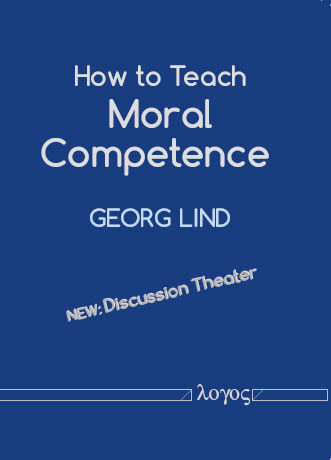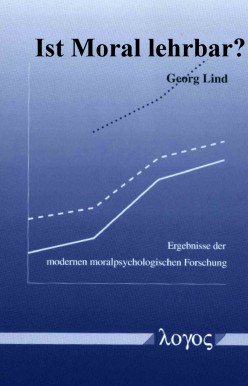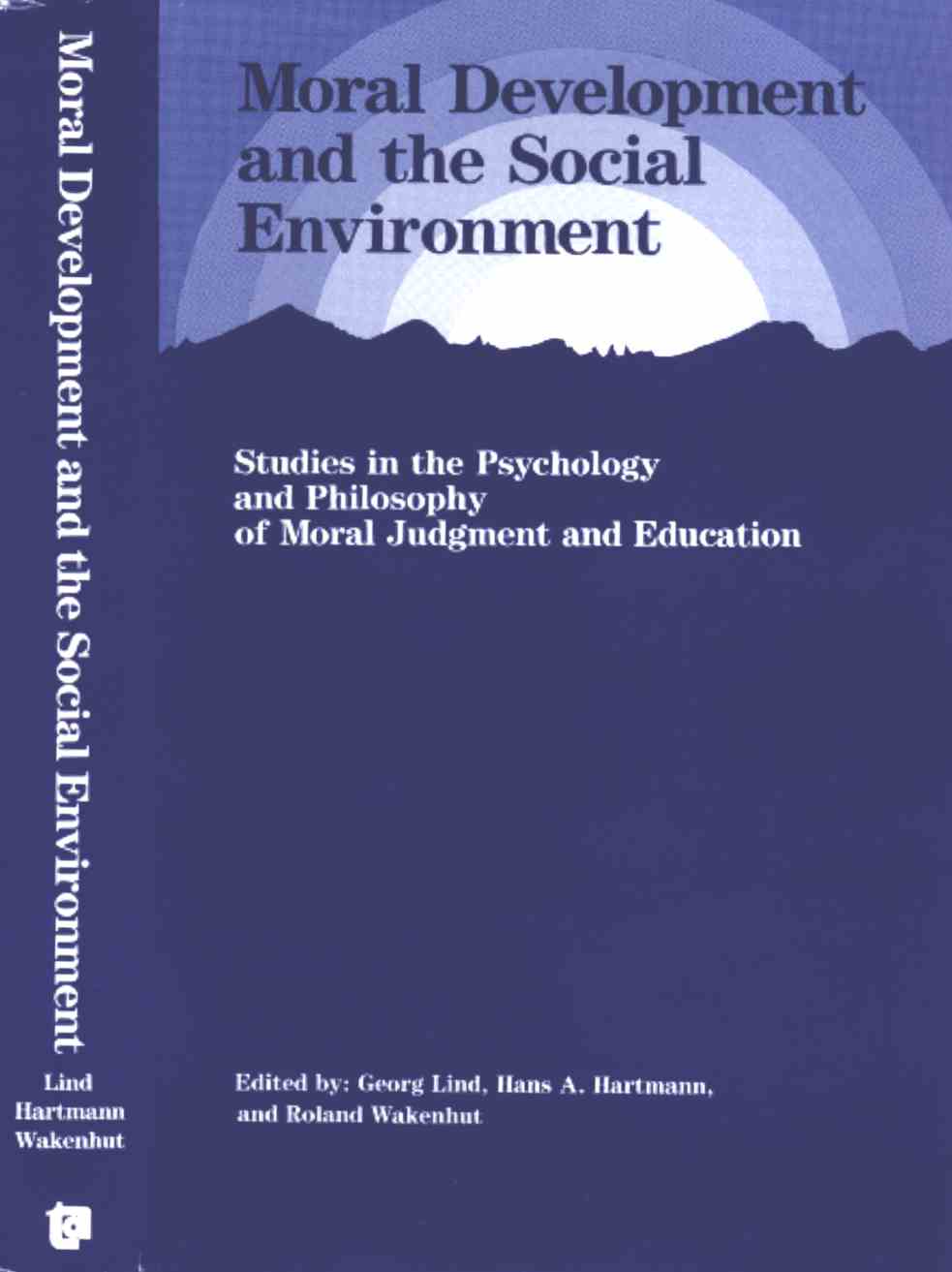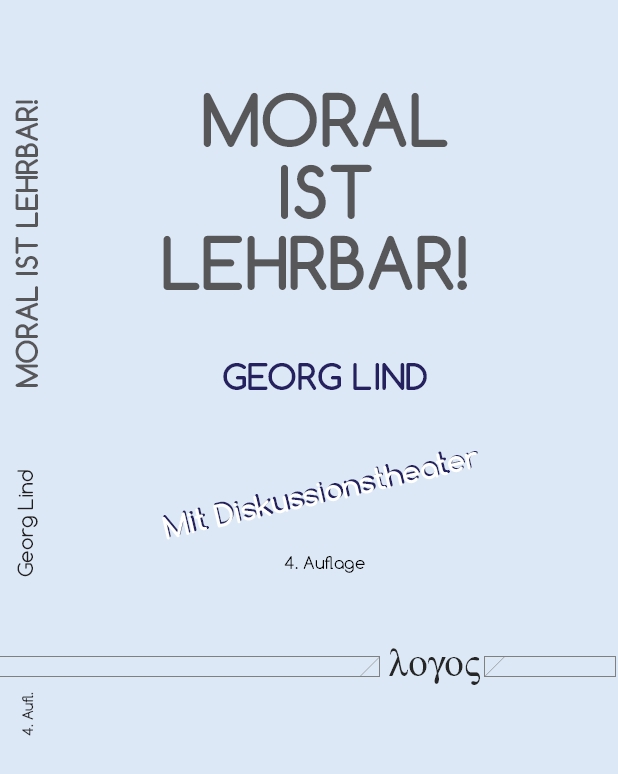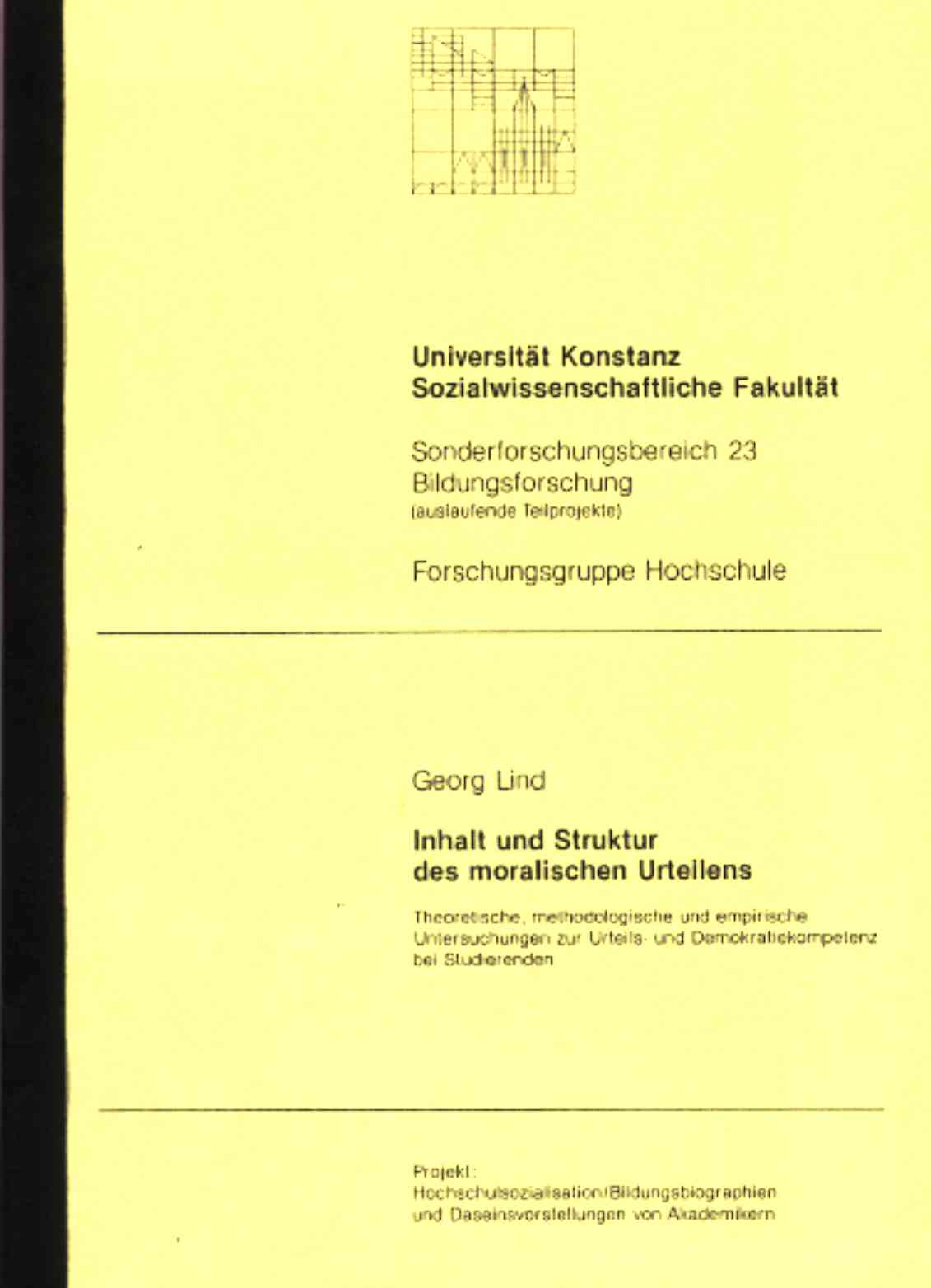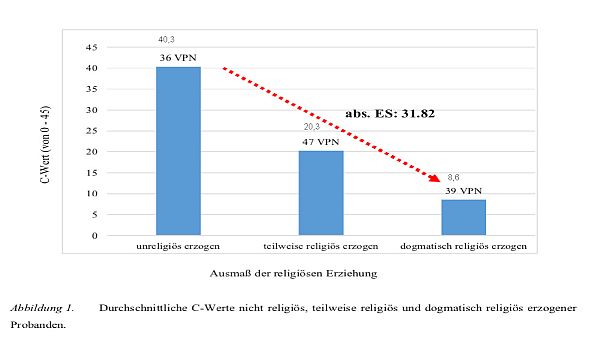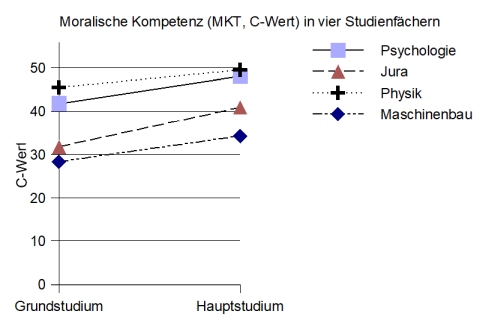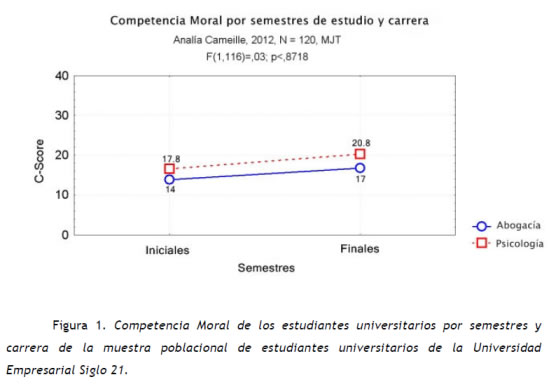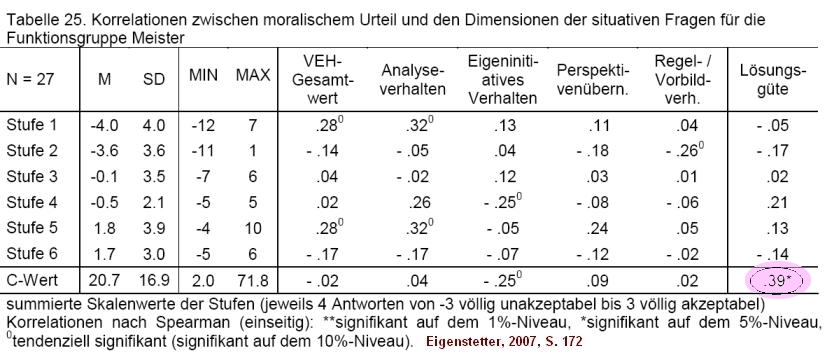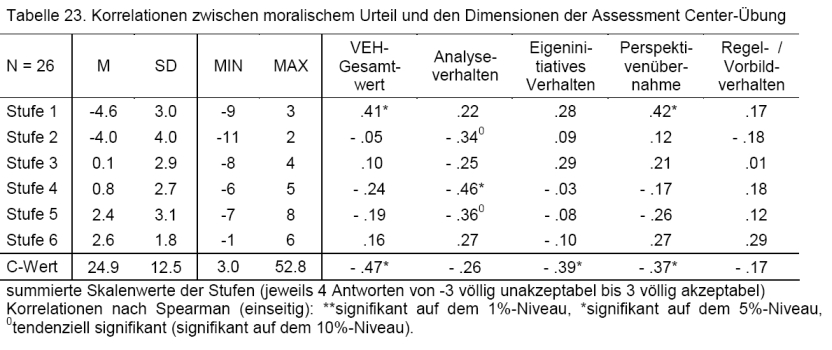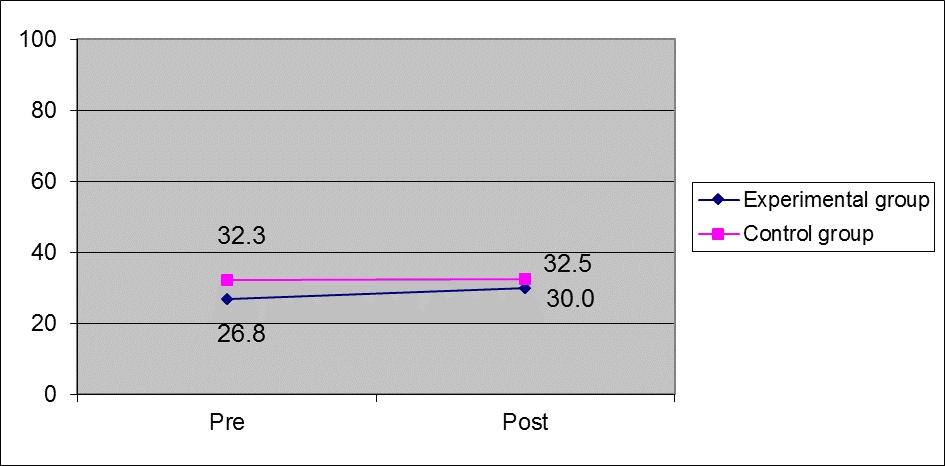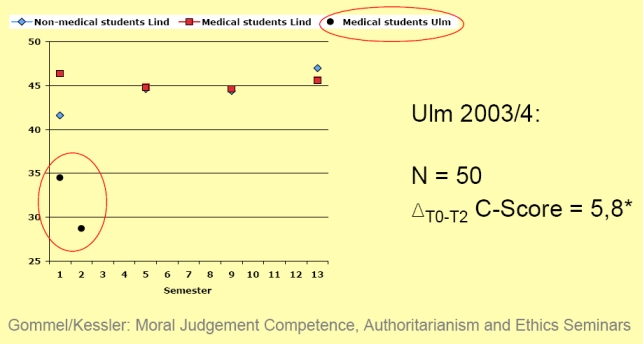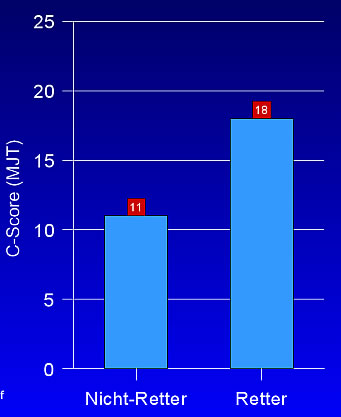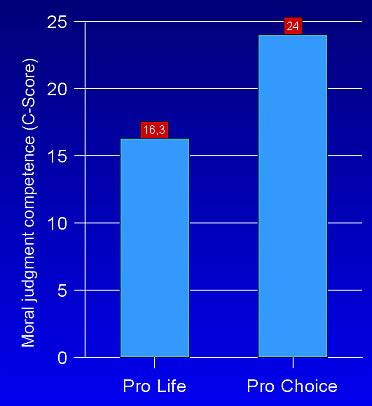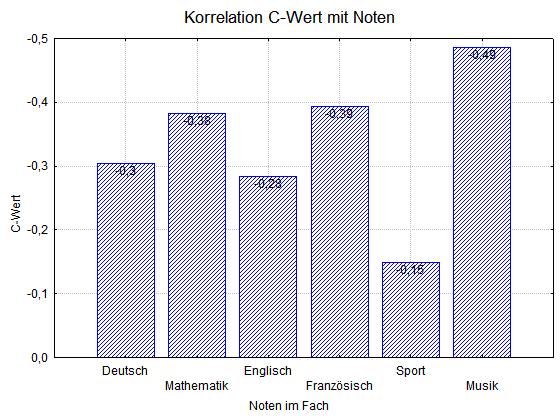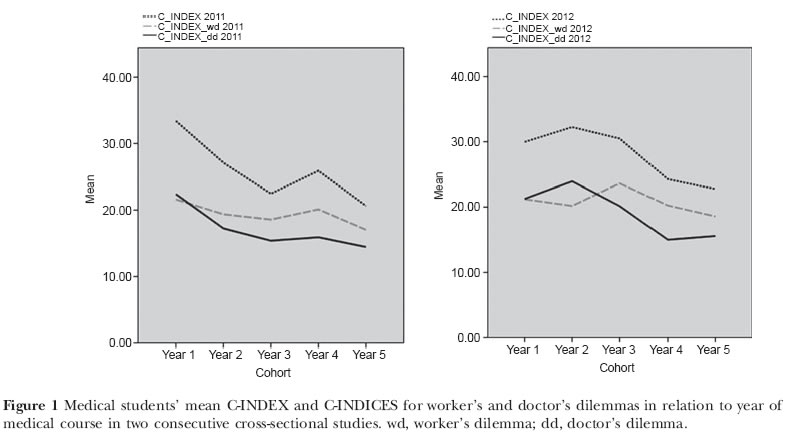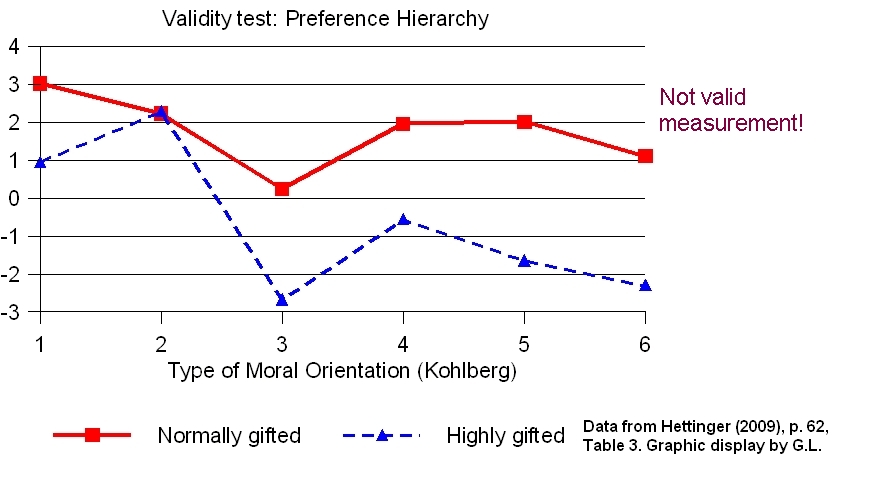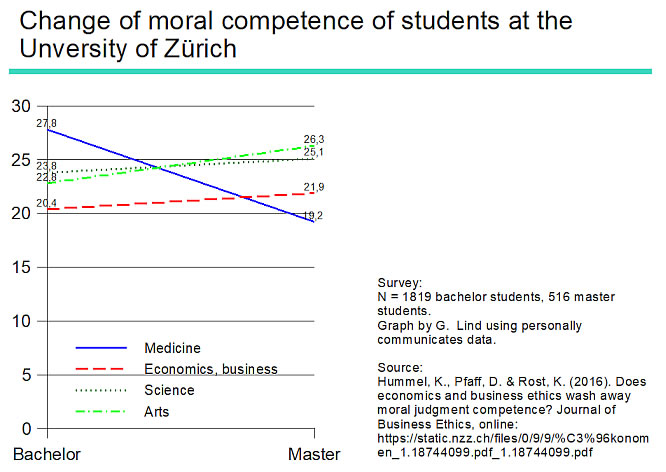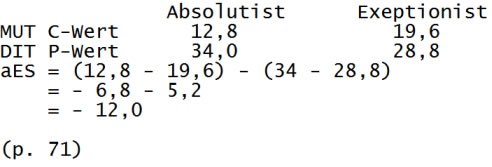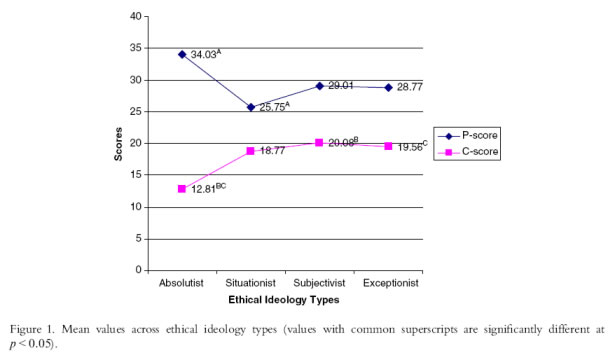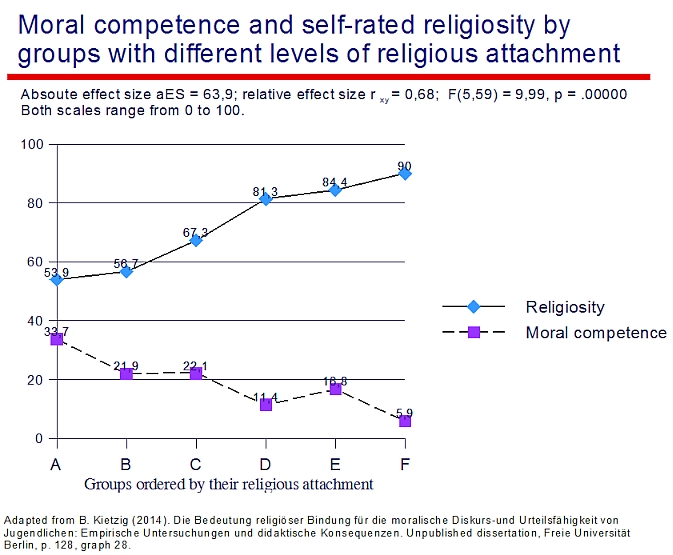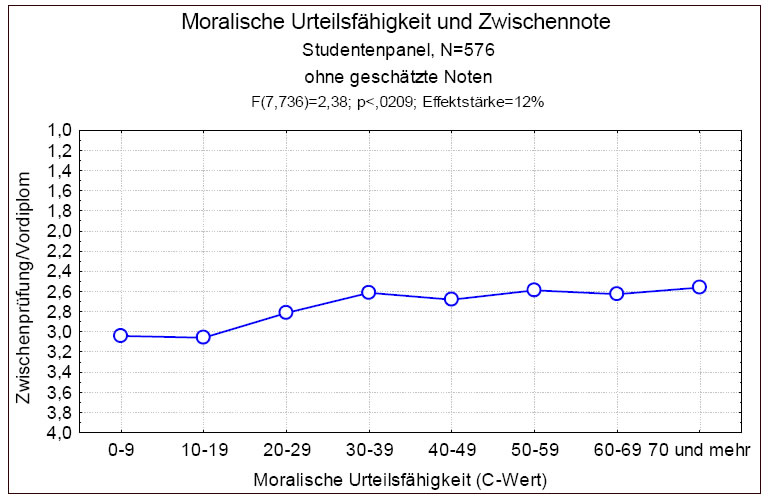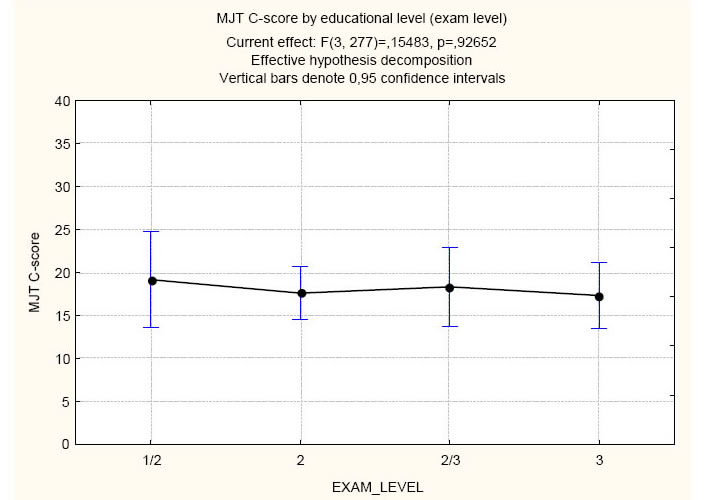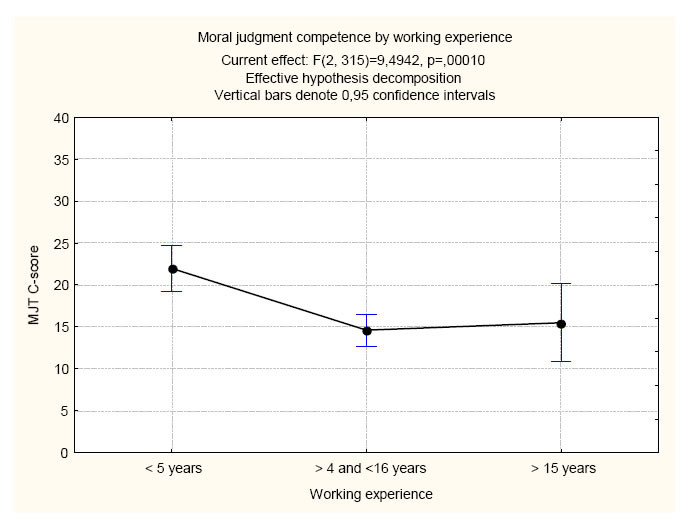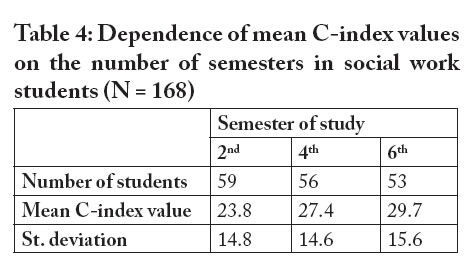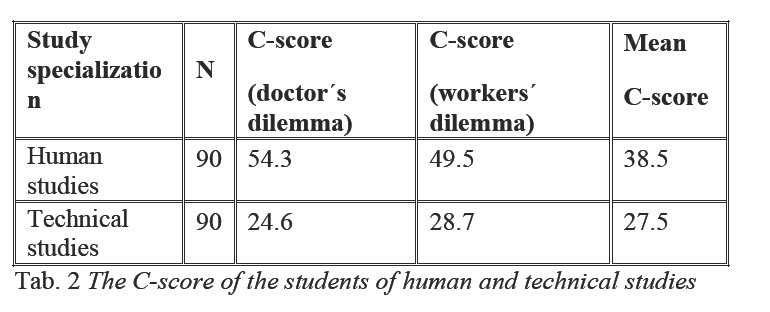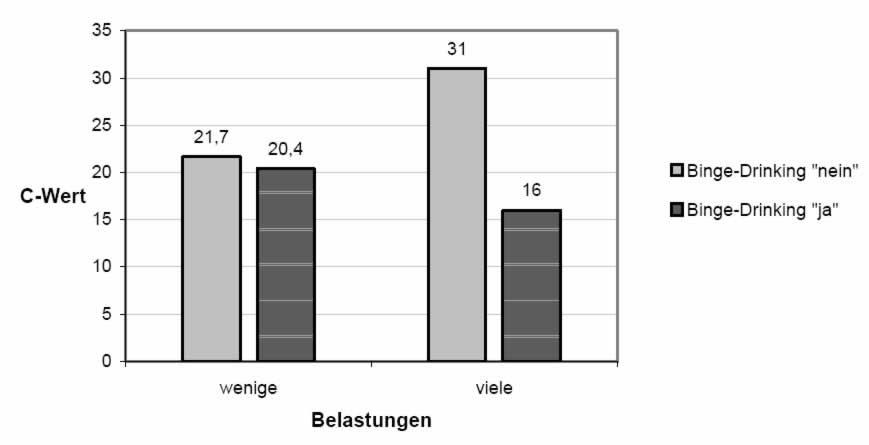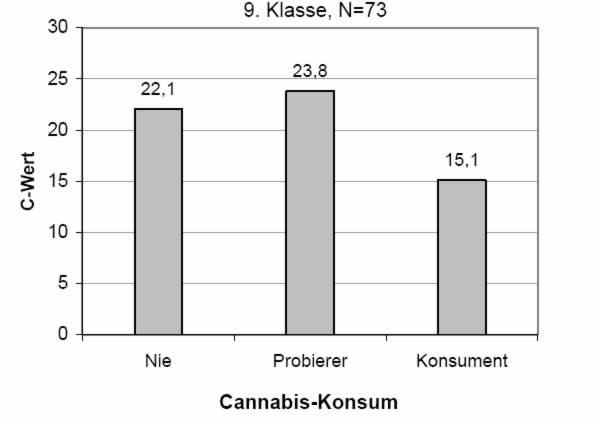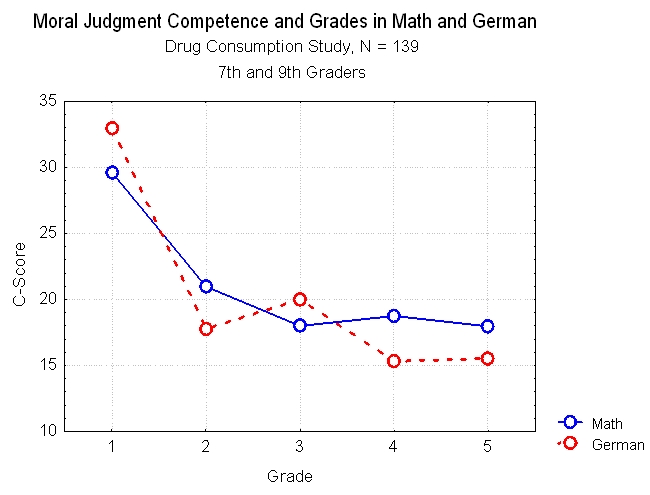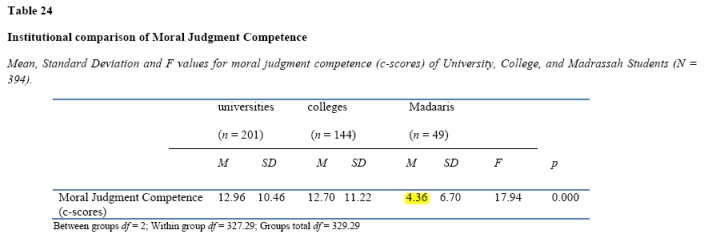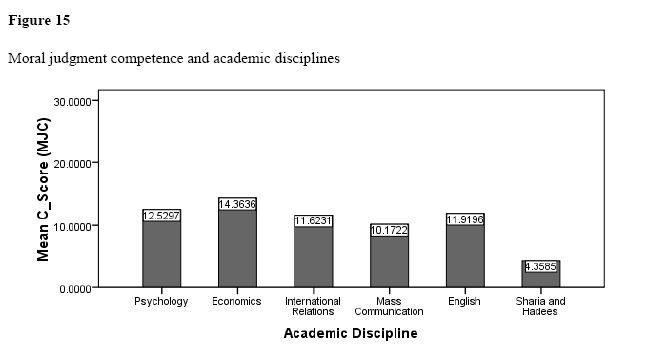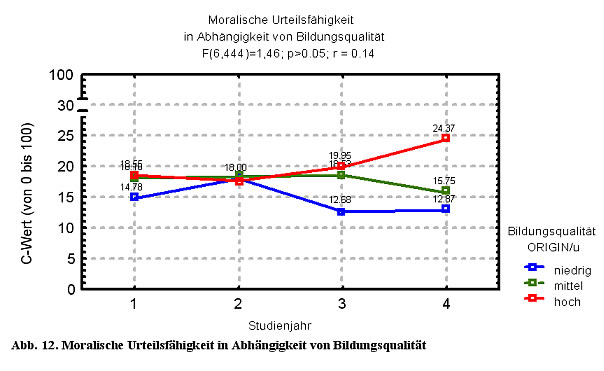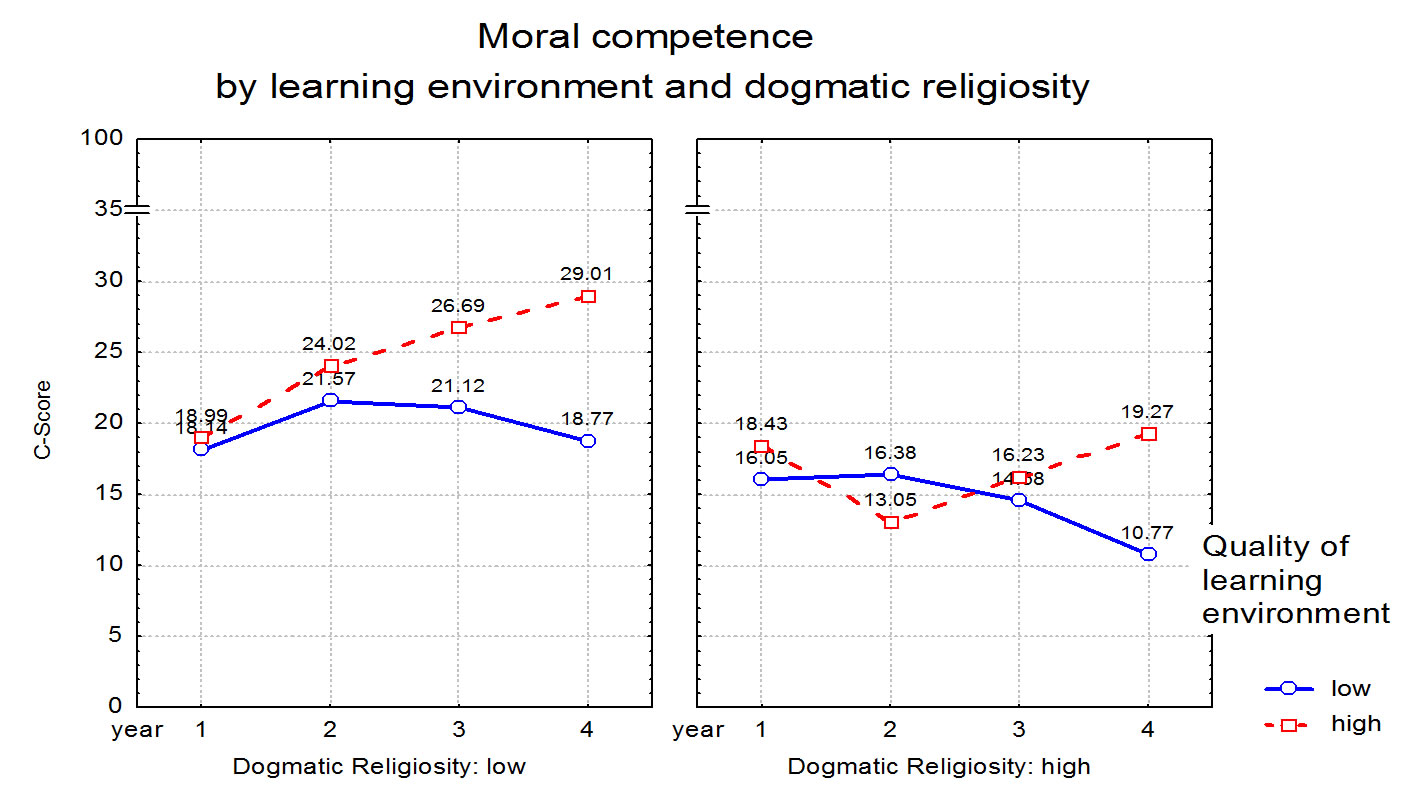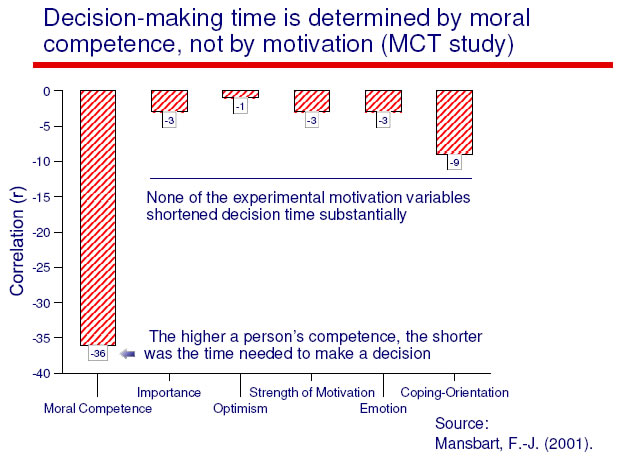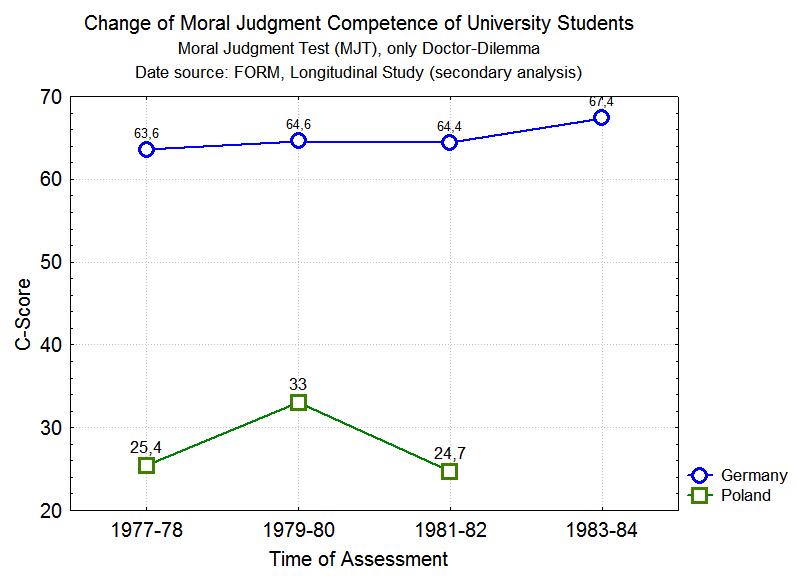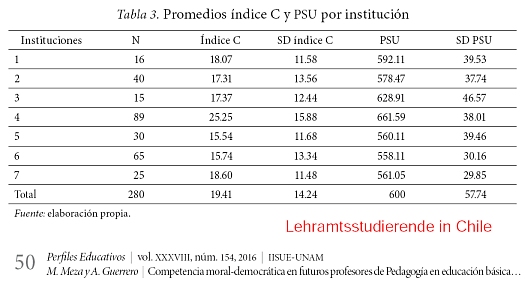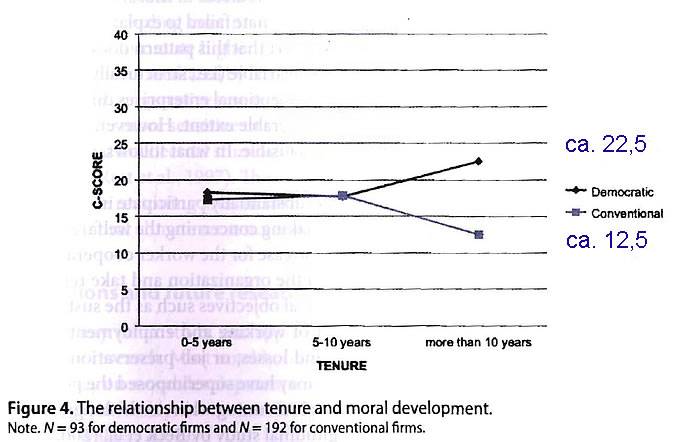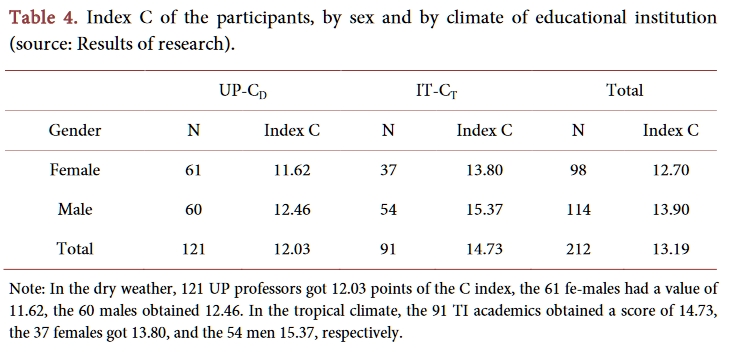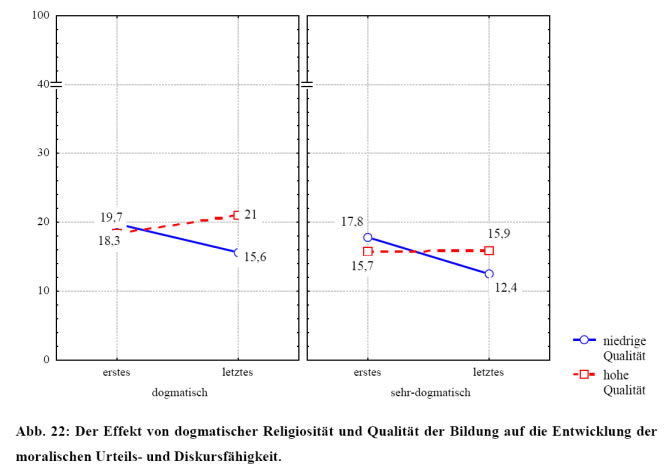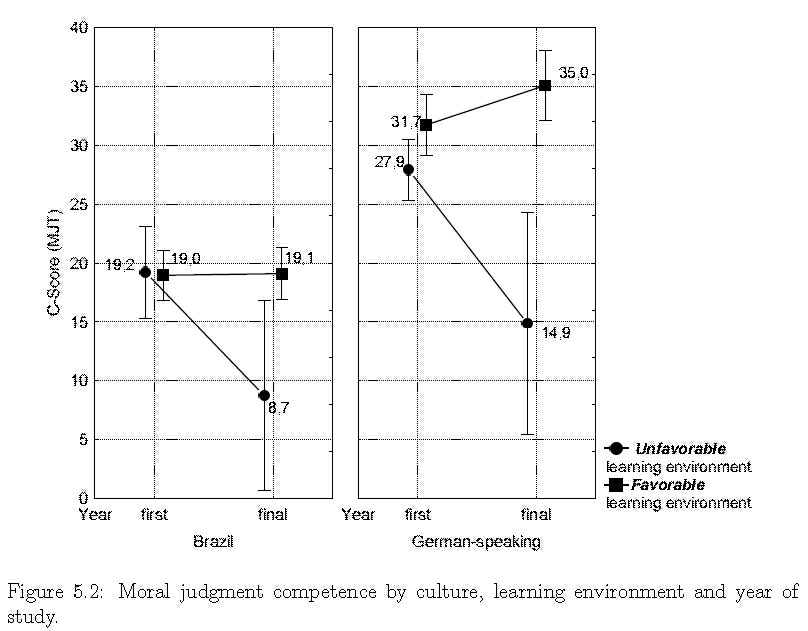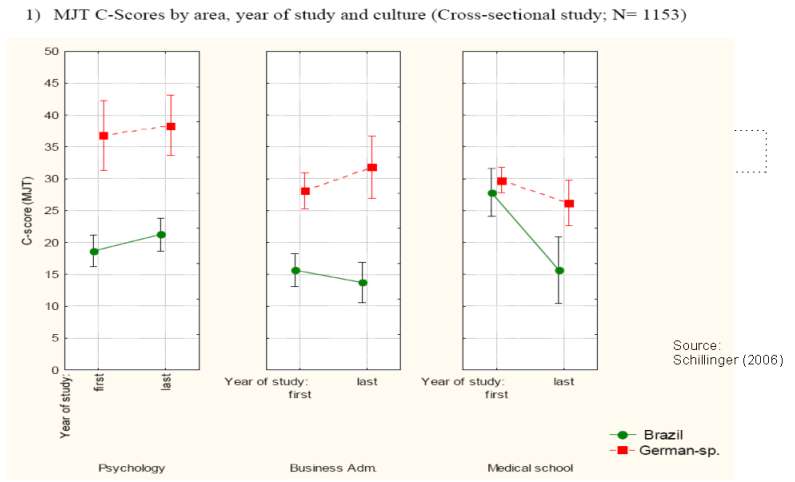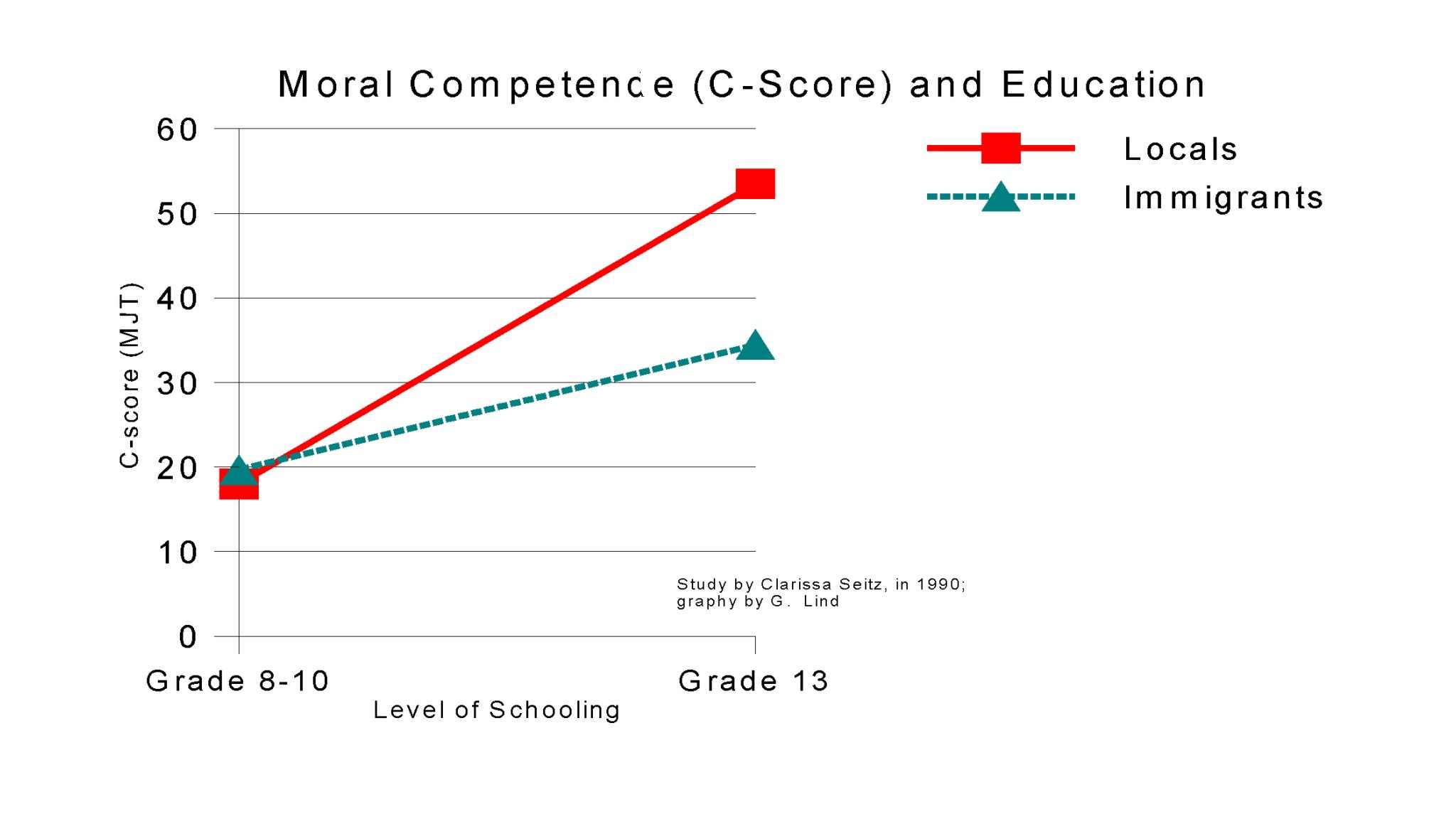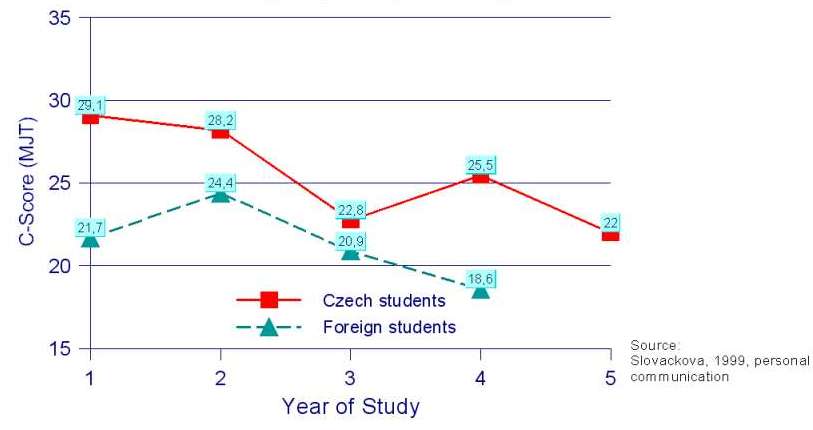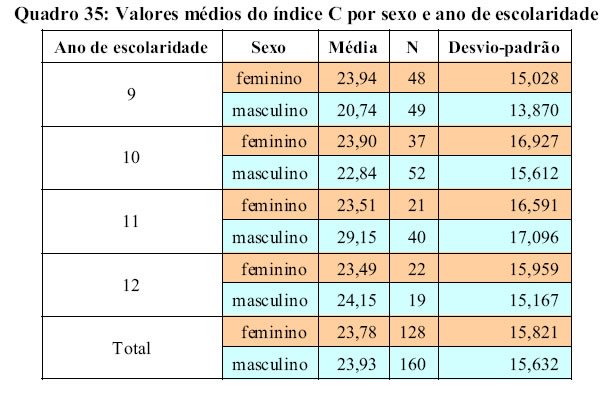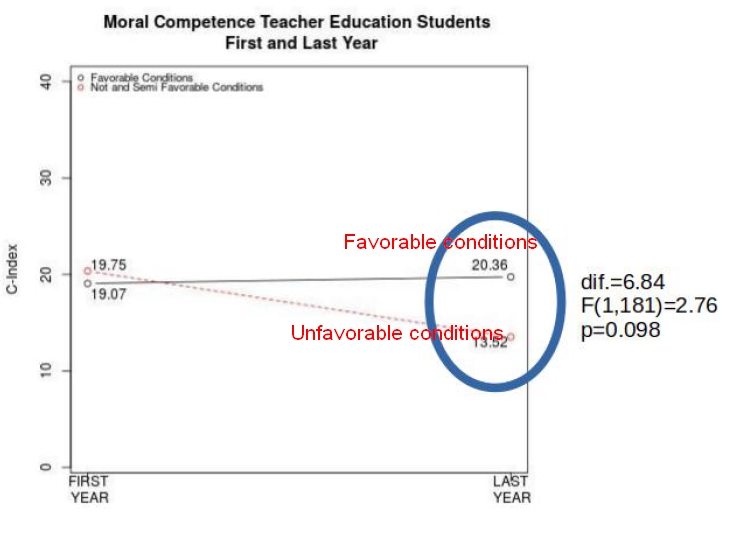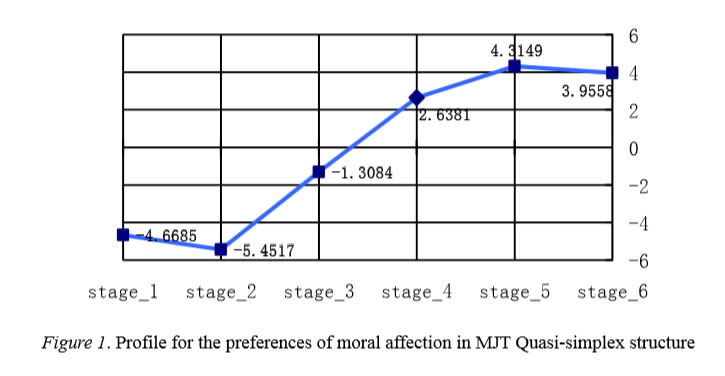References: Measurement, Nature and Development of
Moral Competence (MCT)
Home
Lind's publications
Last revision:
August 7, 2021
For downloading from protected sites, user = kohlberg, pvv = kmdd kurs.
References: Fostering moral competence with KMDD and other methods
Ideas for moral competence research
Improvement of Teaching Through Self-Monitored Evaluation (ITSE)
On complexity"Entities should not be multiplied without necessity." (William of Ockham, 1285–1347)
On hypotheses
"A statement that conveys more information has a greater informative or logical content; it is the better statement." (Karl Popper, 1972, Objective knowledge. An evolutionary approach. Oxford, UK: Clarendon Press, p. 55)
On validity
"To what extent does the proposed test measure a trait that 'really' exists?" (p. 643) (Jane Loevinger, 1957, p. 643) (= Theoretical validity; GL)
-------------------
Note: As an effort to follow Ockham's advice, and to reduce the number of concepts involved in my Dual-Aspect Theory of moral behavior, and to make my theory, as Popper reminds us, more informative and better testable, I have made a few terminological changes over the past four decades of research:
- The main object of my research has always been, and still is, moral competence. Already in the past I have frequently used this term, but I have also used other terms like 'moral judgment' and 'moral reasoning.'. I dropped these termes because they are often used for designating the conscious process of ethical judgment and ethical reasoning rather than for the largely unconscious process of moral competence.
- I also use the term moral-democratic competence to indicate that moral competence applies to both, thinking and discussion.
- Accordingly, I have renamed the once-called Moral Judgment Test (MJT) to Moral Competence Test (MCT). The MCT lets us make an individuals' moral competence visible in their actual pattern of responses to the MCT.
Georg Lind, August. 2021.
Recent publications on the MCT:
Lind, G. (2019). How to make moral competence visible. Chapter 4 of: How to teach moral competence. New: Discussion Theater. Berlin: Logos. ...more
Lind, G. (2019). The art of experimental psychology. Ideas for studying moral competence and beyond. Manuscript. more
Lind, G. (2021). Effect size: statistical, practical and theoretical significance of empirical findings. (automated translation of Lind 2021)
Lind, G. (2021). Making human traits visible, objectively and validly, through experimentally designed questionnaires. Ethics in Progress 12, 1, 15-38. DOI:10.14746/eip.2021.1.3
Lind, G. (2021). Effect size: statistical, practical and theoretical significance of empirical findings. (automated translation of Lind 2021)
Lind, G. (2021). Panic and the lack of moral competence. How we can help to prevent panic pandemics. Ethics in Progress 12, 1, 84-94.
Lind, G. (2021). Moral competence: what it means and how accountant education could foster it. In: M. Pinheiro & A. O. Costa, eds., Accounting ethics education. London: Routledge.
For downloads see Lind's list of publications.
========================
Moral Competence Data (in progress)
| C-score | N | Year | Country | Age | Sample | Source |
| 12,2 | 79 | 2020 | Costa Rica | 18-24 | university students and legal professionals | Rafael León, 2020, pers. communication |
| 22,0 | 452 | 2019 | Romania | 15-25 | high school students | Popoveniuc 2021 |
| 18,2 | 287 | 2019 | university students | |||
| 127 | ? 2019 | USA Florida | ? 18-22 | university students, undergraduate | Klimenko 2021 | |
| 14,1 | " recalling alturistic and egositic dilemma | |||||
| 15,6 | " recalling only alturistic dilemmas | |||||
| 8,5 | " recalling egositic dilemma | |||||
| 20,8 | 217 | ? 2018 | Iran | 18-36 | university students, undergraduate | Mofakhami 2021 |
| 18,0 | 654 | ? 2018 | Lithuania | 19-23 | university students, various fields | Kriaučiūniene & Lind 2021 |
| 20,9 | 236 | ? 2016 | Chile | physicians | Aguerto, Tello et al, 2017 | |
===================== Publications in alphabetic order ===================
Abbasi, W. G., Shakir, S., Azhaar, M., Arif, P., Shariff, N. & Syed, H. (2017). Effect of medical education on the moral competence of medical students. Proceedings of the 4th International Conference on Arts and Humanities 4, 127-140. DOI: https://doi.org/10.17501/icoah.2017.4113
Comment: Like in all other studies, medical education has a negativ impact on the MCT's C-score. This seems to be world-wide phenomenon. See Lind (2000) and Lind (2013). Because moral competence is very important for professional behavior, medical education needs to be supplemented with interventions that promote moral competence, like the Konstanz Methode of Dilemma Discusson (see Lind 2019; Hernandez et al 2005).
Abdel-Hadi, S. A. (2017). The level of moral competence and its relationship with the variables of, gender, specialization and academic year among Al Falah University in Dubai. International Journal of Business and Society 18, S3, 463-478.
"Moral Competence is a term used in the current study to indicate the student who has a master and internalize the laws and mastery in the use of language, skill, and knowledge, showing the integration of a number of important capabilities; such as: a sense of moral and desire to do what is right, and serious will to do the right thing, and the trend and the ability to continue to do what is right, and wisdom, caution and prudence, and possess knowledge about how to do what is right (Liszka, 2002). And the moral competence is defined procedurally in this study as: total score obtained by the student on the ethical sufficiently scale used in this study, as scale items measure the student's level in the integrity and honesty and impression management and responsibility." (p. 469)
Comment (GL): The author of this study claims that he deals with moral competence, but actually uses a measure that contains no moral task but consists of a hodgepodge of concepts: "has a master" (what ever this means), "internalizes the law", "has mastery of language" (why this?), "has skill" (which one?) and "knowledge" (which one?), and "showing a number of important capabilities" (which capabilities?), and so on and so on. He quotes Kohlberg's definition of moral judgment competence (without revealing his reference) but does not explain why he does not use it. He quotes an existing tests of moral competence (Lind 2008) without explaining why he does not employ it.
Acton, G.S. & Revelle, W. (2004). Evaluation of Ten Psychometric Criteria for Circumplex Structure. Methods of Psychological Research Online 2004, Vol. 9, No. 1, 1 - 27. ... more
"A common model for representing psychological data is simple structure (Thurstone (1947). According to one common interpretation, data are simple structured when items or scales have non-zero factor loadings on one and only one factor (Revelle & Rocklin (1979)1. Despite the common place application of simple structure, some psychological models are defined by a lack of simple structure. Circumplexes (Guttman (1954) are one kind of model in which simple structure is lacking." (p. 1).
Comment: The (quasi-) circumplex of stage-correlations has become one of the core validity criteria of the MCT. I borrowed this idea from Kohlberg (1958), who in turn borrowed it from Guttman (1954).
Background: Thurstone's model is the basis of "classical test theory." This model assumes that each item of a test measures the same psychological property (e.g., general intenlligence) and possesses the same difficulty, so that all items are highly (linearly) correlated with each other. Ideally, these correlations are perfect (r = 1.0), yet assumed measurement error reduces these correlations. Gutman's model is similar. It also states that all items measure the same construct but that they differ in regard to their difficulty. Because of the way statistical linear correlations are defined, the correlation between items with different difficulty cannot be r = 1.0 even in the absence of measurement error. This is not a "lack" of simple structure but a consequence of the definition of linear correlation. Guttman argued that the correlations whould be highest for items with most similar difficulty and the similar the more different their difficulty is. When such a structure is given, a factor analysis results in two factors with factor loadings describing a circumflex (a quarter of a circle). See validation crieria for the MCT.
Abdu, Aminu (2008). Socio-cultural factors in the patterns of empathy, prosocial reasoning and moral judgment among senior secondary school students in Nigeria. Unpublished Dissertation, Post Graduate School, Bayero University, Kano, Nigeria.(no page numbers are given)
[The data reported in the tables in this study are highly contradictory. According to some tables, the average C-score in this study is about 11, in other tables it is about 28. I recommend a thorough re-analysis of all data. GL ... more]
Agurto, M., Tello, D., et al. (2017). Índice C en médicos de dos centros hospitalarios chilenos según el test de competencia moral de Lind. Revista medica de Chile, 145, 1122-1128.
"Assessment of moral competence of physicians.
Background: Moral competence (MC) in physicians is fundamental, given the increasing complexity of medicine. The “Moral Competence Test” (MCT © Lind) evaluates this feature and its indicator is the C Index (CI). Aim: To explore moral competence and its associated factors among physicians working in Chile. Material and Methods: The MCT was answered by 236 physicians from two medical centers who voluntarily participated in the study. Besides the test, participants completed an encrypted form giving information about gender, years in practice and post-graduate studies. Results: The average CI value of the participants was 20,9. Post-graduate studies had a significant positive influence on CI. There was a significant decrease in CI, between 16 and 20 years of professional exercise. Gender and the area of post-graduate studies did not have a significant influence. Conclusions: The studied physicians showed a wide range of CI which was positively affected by the postgraduate studies performed. The years of professional practice had a negative influence. Expanding training opportunities during professional practice could have a positive effect on moral competence as measured by CI."Comment: Each day medical doctors have to solve many problems and conflicts. We expect them to cope with these problems and conflicts on the basis of their moral principles, which they doubtlessly have. But they need also moral competence, that is the ability to cope with them through thinking and discussion, instead of through power, deceit, or submission under the authority of others. In other words, the profession of medicine requires a rather high level of moral competence. Yet, as this important study shows, medical education does not foster this enough in Chile (but also in many other countries). The average C Index of 20,9 for these physicians is just the minimum which is needed for cooperating in a social environment (Lind 2016). This means that about half of the physicians is below that minimum. These physician can hardly practice their profession at the level which we should expect. This finding should motivate all who are responsible for medical education to provide opportunities for developing higher moral competence in medical students. The positive effect of postgraduate studies seems to support this request. (Note: I cannot detect any systematic correlation between years of practice and moral competence level. The variation of average scores could be due to sampling effects or quality of education when these age cohorts were studying.) Georg Lind
Akin, Asli (2020). Religiöse Erziehung und Moralentwicklung: Der Einfluss einer religiös geprägten Kindheit auf die moralische Orientierung und Kompetenz. Ethics in Progress (ISSN 2084-9257). Vol. 9 (2018). No. 2, Art. #3, pp. 27-43. Doi:10.14746/eip.2018.2.3. | download
"Insgesamt konnten die Ergebnisse der vorgestellten Studie den bedeutenden Einfluss der frühkindlichen Erziehungserfahrungen für die Moralkompetenz im Erwachsenenalter belegen. Es lässt sich festhalten, dass dogmatisch religiöse Erziehungsmethoden als moralhemmend einzustufen sind, aber welche Erziehungsmethoden eine hohe Moralkompetenz fördern bleibt folglich unbeantwortet und bedarf einer ausführlichen Untersuchung." (p. 39)
Title: "Religious education and moral development: The influence of a religiously influenced childhood on moral orientation and competence."
"All in all, the results of the presented study could prove the significant influence of early childhood educational experiences on moral competence in adulthood. It can be stated that dogmatically religious educational methods are to be classified as inhibiting the development of moral competence, but which educational methods promote moral competence remains unanswered and requires detailed investigation." (Translation by GL) (p. 39)
(C-scores added by GL)
Anderson, N.H. (1991). Moral-social development. In: N.H. Anderson, ed., Information integration theory. Volume III: Developmental, pp. 137-187. Hillsdale, NJ: L. Erlbaum.Anderson, N.H. (1973). Functional measurement of social desirability. Sociometry, 36, 89 - 98. ... more
I borrowed ideas from Anderson's concepts of information integration and functional measurement for constructing the MCT. GL
Anderson, S. W., Bechera, A., Damasio, H., Tranel, D., & Damasio, A. R. (1999). Impairment of social and moral behavior related to early damage in human prefrontal cortex. Nature Neuroscience, 2 (11), 1032-1037.
These authors were among the first who discovered the unique functions of the frontal brain, especially the right dorsolateral prefrontal cortex (rDLPFC) for the integration of (conscious) symbolic reasoning on the one side and affective and emotional impulses originating in the limbic system. They show that if this part of the brain is impaired, people can still use their symbolic functions and cognitive skills but can no longer control their moral behavior. See also Prehn et al. (2008).
Barnett, R., Evens, J., & Rest, J. (1995). Faking moral judgment on the Defining Issues Test. British Journal of Social Psychology, 34, 267-278. see also Lind (1996).
Bataglia, Patricia (2009). A Validação do Teste de Juízo Moral (MJT) para Diferentes Culturas: O Caso Brasileiro (Moral Jugment Test (MJT) * Adaptation for Different Cultures: Brazilian Case.) Psicologia: Reflexão e Crítica, 23(1), 83-91. ... more [* now called Moral Competence Test]
Bataglia, Patricia (1999). The development of moral competence in psychologists. The development of moral competence in psychologists. Paper presented at the AME conference, Nov. 1999, Minneapolis.
Bataglia, P., Schillinger, M. (2013). Moral segmentation in studies with the Moral Judgment Test in Brazil. In: E. Nowak, D. Schrader & B. Zizek., eds., Educating competencies for democracy, pp. 71 - 82. Frankfurt am Main: Peter Lang Verlag.
"Abstract: Analyzing Brazilian MCT data (Bataglia & Schillinger, 2002) separately in a retrospective study, we have noticed that all the samples had much better results in the Workers' Dilemma than in the Doctor 's Dilemma (i.e., Mercy Killing Dilemma). This phenomenon has been called moral segmentation (Wakenhut, 1972 [, Krämer-Badoni & Wakenhut, 1985, GL]). The purpose of the present paper is to present a history of our efforts at investigating the moral segmentation phenom enon in Brazil. Some possible hypotheses and explana tions are presented below." (p. 71)
Bataglia, P., Schillinger-Agati, M. M., Lind, G. & , Quevedo, T.L. (2003). Testing the segmentation hypothesis with an Extended Version of the MJT.* Poster presented at the meeting of the Association for Moral Education, Krakow, July 19, 2003. ... more [* now called Moral Competence Test]
Bataglia, P., Agati (Schillinger), M., Torres, S., Zanoni Crivelaro, D.B., et al. (2002). The development of moral competence and religious commitment in Brazil. Paper presented at the Meeting of the Association for Moral Education, Chicago, Nov. 2002. ... more
Bear, G. G. (1989). Sociomoral reasoning and antisocial behaviors among normal sixth graders. Merrill-Palmer Quarterly 35, 2, 181-196.
Beck, Klaus (1995). Methodologische Probleme und empirische Befunde. In: E.H. Hoff & L. Lappe, eds., Verantwortung im Arbeitsleben, pp. 114 - 128. Heidelberg, Germany: Roland Asanger Publ.
"[D]as von Lind entworfene (freilich von ihm anders verstandene) Messinstument, der 'Moralisches Urteil-Test' (MUT/MJT; 1978)*. Er präsentiert dem Probanden ein Stimulusmaterial, für das die psychische Funktion 'moralische Urteilsbildung' sensibel sein und auf welches sie daher modifizierend wirken müßte mit der Folge eines entsprechenden Verhaltensoutputs. So gesehen provoziert er ein (Antwort-/Ankreuz-)Verhalten, dessen inter- und intrapersonale Variation im wesentlichen auf die unterschiedliche 'Bearbeitung' des systematisch variierten Simulusmaterials (Geschichte, Pro-Contra-Argumente) in der 'Funktionsstelle: Moralische Urteilsbildung' zurückzuführen sein dürfte." (p. 119) [* now called Moral Competence Test]
"Insofar the MJT can be seen as an measurement instrument which is relevant for Kohlberg's theory (see also Heidbrink, 1991, p. 110-121 and 137-150)." (p. 120, my translation GL)
Bennato, A. &
Oraisón, M. (2000 ?). La intervención ético-pedagógica
en la formación docente. Una propuesta para su tematización
y aplicación.
Available from: http://www.unne.edu.ar/cyt/2001/9-Educacion/D-018.pdf
Biggs, Donald, Colesante, R., Agafonov, A., Felming, J., & Campbell, K. (1999). Education about controversial issues: the role of tolerance, moral judgment, and course involvement. Symposium at the AME conference in Minneapolis, Nov. 1999.
Blasi, A. (1980). Bridging moral cognition and moral action: A critical review of the literature. Psychological Bulletin, 88, 1-45.
"Delinquent individuals tend to use developmentally lower modes of moral reasoning than do matched nondelinquents." (p. 11)
"Moral judgment delay in delinquents represented the 'strongest' (p. 37) area of support for the hypothesis that moral reasoning and moral action are related." (p. 37; quoted in Basinger et al. 1993, ms.; p. 7)
Block, J. (1977). Advancing the psychology of personality. D. Magnusson & N. Endler, eds., Personality at the crossroads, pp. 37-63. Hillsdale, NJ: Lawrence Erlbaum.
"Perhaps 90% of the studies are methodologically inadequate, without conceptual implication, and even foolish. ... Many concepts have not been well represented by their operational indicators. Psychologists have been extraordinarily causal and even irresponsible in developing measures to represent concepts. ... Psychologists often employ research designs almost guaranteed to obscure relationships that may be residing in the data." (p. 39, 40, 41)
Brabeck, M. (1984). Ethical characteristics of whistle blowers. Journal of Research in Personality 18(1), 41-53.
Broughton, John (1978). The cognitive-developmental approach to morality: A reply to Kurtines and Greif. Journal of Moral Education 1, 81-96.
Comment: John Broughton brilliantly refutes the critique of Kohlberg's measurement approach by Kurtines and Greif.
Brügelmann, Hans (1979). Erfahrungen mit dem Test zum 'Moralischen Urteil' (M-U-T)* bei Konstanzer und Tübinger Jura-Studenten. (Experiences with the Moral Competence Test* applied to law students in Konstanz and Tübingen, Germany.) In: G. Lind, ed., Moralische Entwicklung und soziale Umwelt. Konstanz Tagungsbericht, S. 74-81.... more [* now called Moral Competence Test, MCT]
Brunswik, Egon (1955): Representative design and probabilistic theory in a functional psychology. Psychological Review, 62(3), 193-217.
I have borrowed from Brunswik the diacritical method for making inferences on the validity of hidden dispositions of behavior for constructing the MCT. GL
Bühn, Andrea (1995). Die Rolle von moralischer Urteils- und Wahrnehmungsfähigkeit im Prozeß der Fach- und Berufswahl von Studerierenden. Unveröffentl. Diplomarbeit, im Fach Psychologie an der Universität Konstanz.
The gains of moral competence by field of study. Cross-sectional comparison of 1st-4th semester students with 5th-10th semester students (Grund- versus Hauptstudium). The law students gained most (p. 45).
Law 31,740,9Psychology 41,848,1Civic engineering 28,334,2Physics 45,549,5
The C-scores in thei study are much higher than in other studies. This could be the effect of moderate participante rate (ca. 50 percent): People with higher moral competence are moral likely to participate voluntarily in studies. It should also be noted that the data have been collected from a cross-sectional sample, so that the differences can also reflect selection processed during the study. That is, student may not have gained from their study but that student with a higher moral competence are less likely to drop out of their study. In fact, other studies show that higher moral competence makes better learning behavior.
Cameille, Analía Gabriela (2012). Competencia de Juicio Moral en estudiantes universitarios de Psicología y Abogacía de la Universidad Empresarial Siglo 21. Trabajo Final de Graduación, Universidad Empresarial Siglo 21, Cordoba, Argentinia. ... more
Comment: The absolute effect sizes of higher education (Universidad Empresarial Siglo 21) in the two disciplines psychology and law in this study were 2.0 and 3 C-points. GL
Campbell, D. T. (1950). The indirect assessment of attitudes. Psychological Bulletin, 47, 15-38.
Validity: "Research on social attitudes has been justly criticized for a failure to integrate definition and measurement procedures." (p. 31)
Chrenková, P. & Šukolová, D. (2016). Nevera Vo Vzťahu K Morálnemu Usudzovaniu – Infidelity in relation to moral reasoning. Conference paper. Download.
Abstract
The main objective of the study was to find out, if there is any relation between personal tendency towards infidelity and moral reasoning. Furthermore, we focused on the link between moral reasoning and assessing the significance of the various causes of infidelity (eligibility, normalcy, sexuality, search suggestions, social background and seduction). In the end, we analyzed gender differences in the overall tendency to infidelity and moral reasoning. To obtain the data we used the INFQ –Infidelity Questionnaire (Yeniçeri & Kökdemir, 2006) and the MJT – Moral Judgment Test (Lind, 2008).* The sample consisted of 151 respondents (75 men, 76 women) during young adulthood. The research results have shown a negative correlation between the tendency towards infidelity and moral reasoning and a negative relationship between moral reasoning and infidelity causes –search initiatives, social background and seduction. Statistically significant gender differences weren’t demonstrated.
Key words: moral reasoning; infidelity causes; young adulthood (moral competence)* Comment by GL: The MJT has been renamed as Moral Competence Test (MCT). For a more recent publication on the MCT, see: Lind, G. (2016). How to teach morality. Promoting deliberation and discussion, Reducing violence and deceit. Berlin: Logos.
The correlations between moral competence and infidelity are interesting. Yet they are small (from r=0,02 to 0,13) and rest on self-report data. A replication study with behavioral data would be desirable. This study should also include participants with higher moral competence. The mean level in this sample was relatively low (mean C = 15,7; p. 189).
Çiftçi, Nermin (2001). Ahlâkî Yarki Testi MUT´un Teorisi ve Türkçe Versiyonunun Geçerligi. Kuram ve Uygulamada Egitim Bilimerli 1/2, Aralik 2001, 295-321. (Validation study of the Turkish MCT)
Cohen, Semantha (2011). Pragmatic Morality. Does cuing moral judgment lead to moral action? Unpublished research paper, Hunter College, City University of New York.
Small study with N = 10 subjects, sampled in Washington Square Park: "The dependent variable was whether or not the participant was willing to take a donation form for the charity of the Food Bank for New York City and consider donating to that charity. ... The mean Cscores for those who donated and those who did not can be seen in Figure 2. The mean C-score for those who accepted a donation form was 41.15 (SD = 33.47) and was 27.54 (SD = 15.30) for those who did not accept a donation form." PDF [Access, pw = "kohlberg"]
Colby, A., Kohlberg, L., Colby, A., Kohlberg, L., Speicher, B., Hewer, A., Candee, O., Gibbs, J., & Power, C. (1987). The measurement of moral judgment: Standard issue scoring manual, Vol. II. New York: Cambridge University Press.
Colesante, Robert & Biggs, Donald (2001). A controversy about the measurement of moral development: Stage preference or moral consistency? Paper Presented at the Association for Moral Education Conference held in Vancouver, BC, October 25 - 27, 2001... more
Table 1 (appendix)
"Data for this study were collected in two general education courses at a mid-sized state University in the northeastern United States from Spring 1997 to Fall 2001. 570 students completed a questionnaire on the final day of their classes; 144 were later dropped (about 25%) from analysis because of incomplete responses on the Moral Competence Test." (p. 6) [* now called Moral Competence Test, MCT]
Note: The study reports an unusually high rate of incomplete responses. This underscores the very low C-score found amongst these college students. The authors do not report any circumstances which may account for these scores. It is also interesting to note that the C-score hardly increases from freshman to senor year, indicating the college education has no impact on the development of moral competence.
Colesante, Robert & Biggs, Donald (2002). A test of the dual aspect theory of moral judgment competence. Unpublished manuscript. ... more
Comunian, Anna Laura & Gielen, Uwe P. (1995). A study of moral reasoning and prosocial action in Italian culture. Journal of Social Psychology.
Comunian, A. L. & Gielen, U. P. (2006). Promotion of moral judgement maturity through stimulation of social role-taking and social reflection: an Italian intervention study. Journal of Moral Education, 35 (1), 51-69.
"Abstract: We examined social role-taking and moral judgement improvement after an educational group-oriented intervention emphasizing guided reflection and role-taking dimensions among 11 groups, made up of a total of 61 female and male Italian university students. They were compared to a control group of 59 students. We twice applied Italian adaptations of two role-taking and two moral development measures, originally developed by Gibbs and by Lind respectively in the USA and in Germany. Good empirical upport for the reliability and validity of the American and German instruments was noted in the Italian setting. Students assumed more responsibility in a variety of social roles, exposed themselves increasingly to social role-taking opportunities, and showed increased moral judgement maturity after the educational intervention. An active orientation toward role-taking opportunities was related to higher levels of moral judgement among both men and women."
Derkum, H., Echterhoff, G. & Schneider, W. (1992). Wege zur Verhaltensänderung junger Menschen im Straßenverkehr und zur Reduzierung von Verkehrsunfällen. Teil II: Befragung von Freizeit- und Verkehrsverhalten jungen Menschen und Umfrage unter Polizeidienststellen im Bundesgebiet. Köln Forschungsmeinschaft Auto-Sicht-Sicherheit.
Desplaces, D. E., Melchar, D. E., Beauvais, L. L., & Bosco, S. M. (2007). The impact of business education on moral judgment competence: An empirical study. ... more
Study of 899 business students, mostly undergraduates (78 graduate students) of three universities in the northeastern region of the U.S. Almost no correlations of moral competence (C-score, MCT) with age (r =.08) and gender (0.01). The perception with "ethical culture" of one's institution was r = 0.000. Unfortunately, it does not say how the single question for this variable was worded (p. 80). In contrast the P-score of the DIT-correlated with gender (r = 0.17) with women indication somewhat stronger preferences for principled moral reasoning than man [contradicting Carol Gilligan's assumption that women prefer morality of care over principles of justice.]
The fact that all correlations were lower than r = 0.1 may be caused by the rather low C-scores of these business students which severely limit the variance of the C-scores and, as a consequence, also all correlations with other variables. The authors did not report the overall mean but it can be imputed from a quote as being below C = 18.0: "The mean C-Index of respondents who did not report witnessing unethical behavior was 17.22 (SD = 13.56) compared to a mean of 18.26 (SD = 12.95) for those who did report witnessing unethical behavior." (p. 82). The amount of perceived cheating in their institution was used as an index for 'unethical behavior'.
De Waal, Frans (2008). Primaten und Philosophen. wie die Evolution die Moral hervorbrachte. München: Hanser.
"Homo homini lupus -- der Mensch ist dem Menschen ein Wolf -- lautet ein uraltes lateinisches Sprichwort, das Thomas Hobbes einem breiteren Publikum bekannt machte. ... das Sprichtwort zeichnet sich durch zwei schwerwiegende Fehler aus. ERstens tut es den Kaniden unrecht, die zu den geselligsten und kooperativsten Tieren auf unserem Planeten zählen... Zweitens, und das ist noch schlimmer, stellt es da unserer eigenen Spezies mitgegebene soziale Wesen in Abrede." (p. 21) "Im Abendland gibt es die Neinung, Emotionenen als verweichlicht und soziale Bindung als chaotisch zu betrachten, so dass sich die Theoretiker lieber der Kognition als der maßgeblichen Seite menschlichen Verhaltens zugewandt haben. Wir feiern die Rationalität. Und dies, obowhl die psychologische Forschung nahe legt, dass menschliches Verhalten zuallererst aus schnellen, automatisierten emnotionalen Einschätzungen herrührt und nur in zweiter Linie aus langsameren Bewusstseinsvorgängen..." (p. 24)"Darwin .... 'Es scheint mir in hohem Grade wahrscheinlich zu sein, dass jedwedes Tier mit wohlgebildeten sozialen Instinkten (Eltern- und Kindesliebe eingeschlossen) unausbleiblich ein moralisches Gefühl oder Gewissen erlangen würde, sobald sich seine intellektuellen Kräfte so weit oder nahezu so weit wie beim Menschen entwickelt hätten.' [Darwin 1971: 122]" (p. 32)
Kommentar: Frans de Waal kritisiert zurecht den 'Dualismus', wonach die Moral eine kulturelle Leistung unabhängig von der Evolution sei, und beklagt, dass die Emotionen und sozialen Gefühle von vielen als etwas angesehen werden würden, das der menschlichen Natur fremd und aufgesetzt sei. Aber er verkennt, dass er selbst einem Dualismus unterliegt, wenn er die Emotionen und Gefühle als das Primäre ansieht und Kulturleistungen als etwas, das kein Produkt der Evolution sei. Hier versteht auch de Waal sein Vorbild Darwin falsch, wie das von ihm selbst wiedergegebene Zitat oben zeigt! Für Darwin sind auch Intelligenz, Kultur und andere kognitive Leistungen ein Produkt der Evolution und als solche zu beachten. Moralische Emotionen sind zwar automatisiert und schnell, aber sie sind leider auch 'dumm' und undifferenziert und können miteinander in unauflösbare Konflikte geraten. Und genau für diesen Fall, der in hochkomplexen Gesellschaften beim Menschen sehr häufig vorkommt, benötigen wir kognitive Fähigkeiten. Um beiden Aspekten der menschlichen Natur gerecht zu werden, benötigen wir also eine Zwei-Aspekte-Theorie der Moral und keine einseitige Emotionstheorie (Lind, 2008; 2009; 2015).
Deutscher, I., ed. (1973). What we say / what we do: sentiments and acts. Glencoe, IL: The Free Press.
Validity: "Our observation is not valid unless it matches our intentions..." (p. 108)
Doehne, M., von Grundherr, M., & Schäfer, M. (2018). Peer influence in bullying: The autonomy-enhancing effect of moral competence. Aggressive Behavior, 44, 591-600. doi:https://doi.org/10.1002/ab.21784.
Abstract: "Research has found that moral competence is negatively associated with bullying behavior in schools, but the drivers of this association are not yet well understood. In this paper, we report on two studies which suggest that moral competence acts as a moderator of peer influence in the context of school bullying. Data were collected at two time points in three German higher secondary schools (grades 7–10, average age at measurement: 14.26 years). Using a cross-lagged panel design (CLPD), study 1 (N = 251) found adolescents with low moral competence to be susceptible to peer influence, while no such effect was found for adolescents with high moral competence. Study 2, a cross-sectional analysis (N = 748), found moral competence to be inversely related to the likelihood of an individual's conforming with the pro-bullying behavior of his or her peers. Neither study found corresponding effects for pro-social, defending behavior. Our findings further illuminate the associations between moral competence, peer influence, and school bullying. Some implications for bullying prevention are discussed."
Donders, Franciscus Corelius (1868). Die Schnelligkeit psychischer Prozesse. Reichert's und du Bois-Reymon's Archiv. ... more
Donders, F. C. (1986). On the speed of mental processes. Acta Psychologica 30, Attention and Performance II, 412-431. Retrieved from: http://www2.psychology.uiowa.edu/faculty/mordkoff/InfoProc/pdfs/Donders%201868.pdf
DuBois, James (1997). The moral judgment of medical personnel. A cross-cultural study about brain death and organ explantation. Unpublished dissertation, University of Vienna, Austria.
"I agree with Lind that a high level of inconsistency in answering test items may indicate authentic patterns of reasoning rather than factors which would render performance on the test invalid." (p. 45)"It is important to note that in the study by Rest, Thoma, and Edwards the C score was calculated using data collected from the DIT. This is problematic because one cannot possibly arrive at a C score using a test which does not require one to evaluate both arguments for and against the decision made in solving the dilemma. ...
It is absolutely impossible to capture that which the C score is meant to measure without providing arguments pro and con; because the DIT does not do this, it seems theoretically invalid to try to generate a C score using DIT data: whatever it is that Rest, Thoma and Edwards produced, it was not the C score which Lind measures with his MJT."* (p. 46) [* now called Moral Competence Test]The data show a substantial correlation between moral competence (MCT) and a positive attitude towards mercy killing [F(1,178) = 7,59; r = 0.41; my calculation of r; GL] and organ transplantation [F (7,185) = 4,20; r = 0.15; my calculation of r; GL] p. 242
DuBois, James (1998). Medical personell and the logic of moral judgment. Delivered to the American Educational Research Association, Section J (Post-secondary Education) Symposium: “Does Medical Education Fail to Promote Moral Competence – and Why Does It?” San Diego, CA, April 13,1998. ... more.
DuBois, J. (1999). Attitudes Toward Death and Organ Procurement: The Influence of National, Professional, Religious, and MJT * Variables. Delivered to Association for Moral Education, University of Minnesota, November 19-20. [* now called Moral Competence Test]
Duriez, Bart & De Marez, P. (2000). Voorstelling en validering van de Morele Ordeel Test (MOT), de Nederlandstalige versie van de Moral Judgment Test (MJT).* Internal Report. Leuven, Belgium, K.U. Leuven. [* now called Moral Competence Test]
Duriez, B. & Soenens, B. (2006). Religiosity, moral attitudes and moral competence: A critical investigation of the religiosity-morality relation. International Journal of Behavioral Development, 30, 1, 76-83. ... more
Dutka, Joanna (2017). For a future free of violence: Moral competencies As a means of emancipation and self-empowerment. Ethics in Progress (ISSN 2084-9257) Vol. 8 (2017) No.1, Art #14, pp. 225-240. Doi 10.14746/eip.2017.1.14
"In this paper I will explore the idea that protection from interpersonal violence is essential for making society more democratic, and in turn that education which focuses moral- democratic competencies is an appropriate means of helping people affected by interpersonal violence. I will specifically explain how the self-empowerment of people subjected to violence or endangered by the potential use of violence, can make a positive contribution to violence prevention. This selfempowerment goes hand in hand with the growth of competencies. I view this matter as complementary to the issue of preventing potential perpetrators from acting violently, by providing them with the opportunity to foster their own competencies.
I will also discuss gender-based violence and the situation of women affected by abuse, in order to support my claims with some empirical evidence. In this context, the type of violence I refer to is physical violence - acts of violence targeting the body of a person. Therefore, I will also explore the problem of violence prevention in the context of the struggle for women's emancipation and gender equality. This paper will also refer to the idea of moraldemocratic competencies, following Georg Lind, who bases many of his ideas on the earlier works of his teacher, Lawrence Kohlberg. The view of democracy as way of life, which Lind supports in his work, corresponds to the vision of democratic relations in society which can be found in the writings of feminist political thinkers such as Iris Marion Young, Nancy Fraser and Ann Phillips."
Eigenstetter, Monika (2007). Verantwortung in Organisationen: Entwicklung und Validierung simulationsorientierter Instrumente zur Diagnostik verantwortungsvollen Entscheidens und Handelns im Arbeits-, Gesundheits- und Umweltschutz. Unveröffentlichte Dissertation, Universität Jena. ... more
The following graphs from Eigenstetter (2007) show that moral competence correlates negatively with the gloabal rating of vague rating-dimensions by observers, but that it correlates positively and quite high (r = 0.39) with the observed competence ("quality of solution"). In contrast, this competence does not correlate with self-observed "integrity" (r = 0.06) and "internal locus of control" (r = 0.03). [Auszug meiner Stellungnahme zu dieser Studie:] "Die Annahme, dass Regel- und Vorbildverhalten und moralisches Urteil positiv zusammenhängen, konnte für die [Assessment Center-] AC-Übung nicht bestätigt werden." (p. 169). Genau das sagt die Bildungstheorie vorher! ...
Die Einschätzkriterien [Ihrer Beobachter] sind sehr allgemein und es werden sehr verschiedenartige [Kriterien] zu einheitlichen Kriterien verbunden. Wie Kritikfähigkeit und Perspektivenübernahme durch kurze Beobachtungen gemessen werden können, ist sehr fraglich. Auch ist problematisch, beide zusammen zu fassen. Hohe Reliabilitäten deuten weniger auf gute Validität hin als darauf, dass letztlich nur ein Stereotyp, vermutlich die allgemeine Angepasstheit des Probanden an die Erwartungen der Arbeitswelt gemessen wurde. Dazu würden auch die erstaunlich hohen negativen Korrelationen mit dem C-Wert sprechen. Menschen mit hoher Urteilsfähigkeit sind, so scheint es, auch verantwortungsfähig, aber nicht immer pflegeleicht. Gerade weil sie sich ihrer Verantwortung bewusst sind, ecken sie im Alltag manchmal an, wo es selten um die großen moralischen Ziele des Unternehmens oder gar der Menscheit geht.
Genau das hat Ihre Studie auch ergeben: "Je eher man sich an Straferwartung und Gehorsam orientierte, desto eher wurde man in der AC-Übung als sozial kompetent eingestuft." (p. 169). ...
Bestätigt wird meine Vermutung auch durch Ihre Befunde zur Kontrollüberzeugung und Integrität, die auch überwiegend negativ waren. Aus Sicht der Bildungstheorie macht das alles Sinn."(Mail, 5.2.2008; GL)
Emler, N., Renwick, S. & Malone, B. (1983). The relationship between moral reasoning and political orientation. Journal of Personality and Social Psychology, 45, 1073-80.
Emler et al. showed that the DIT's P-score could be faked upward if participants were instructed to simulate the moral behavior of political adversaries. Especially participants who located themselves on the right side of a political self-description scale and had lower P-scores, could simulate their scores upward when being asked to put themselves into the shoes of a self-describd "leftist" or "liberal." Emler et al. concluded that Kohlberg's theory of moral competence was disproven by this experiment. Moral judgment was merely an attitude or ideology but not an ability. However, the replicating of this study with the MCT instead of the DIT, showed that when moral competence instead of moral attitudes or preferences were measured, the scores could not be faked upward (see Lind, 2008).
In another experiment, Wasel (1994, see below) also showed that moral competence, as measured with the MJT, could not be faked upward and that the precision of the simulation depended on the participants' own degree of moral competence. Both experimental studies corroborate the notion that moral judgment has a strong competence aspect (Lind, 2002).
Feitosa, H. & Rego, S. (2012). Competência de juízo moral dos estudantes de Medicina: um estudo piloto. [Moral judgment competence of medical students: a pilot study.] Brazilian Journal of Medical Education, 0177, 2012
The full article is available from: http://www.educacaomedica.org.br/artigos/artigo_int.php?id_artigo=1873
Abstract
The authors conducted a cross-sectional short-term study using Lind’s Moral Judgment Test (MJT) to compare the moral competence (C-score) among students in the first and eighth semesters from a medical school in the Northeast region of Brazil. This study also evaluates the influence of such factors as age and gender on moral competence. A difference equal to or greater than 5.0 points (absolute effect-size) on the C-score was considered significant. A regression of moral competence among the students in their eighth semester versus the students in the first semester (C-score: 20.5 and 26.2 points, respectively) was observed. In the analysis of the students’ performances in terms of MCT dilemmas, the phenomenon of “moral segmentation” was observed in the both semesters, and the students performed better on the worker’s dilemma than on the doctor’s dilemma. Among students in the same semester of study, older students had lower C-scores. When comparing performance by gender, there was no significant difference between men’s and women’s Cscores.
The finding of regression or stagnation in moral competence among the medical students merits deep reflection by those who work with the political-pedagogical projects of medical schools and by the entire faculty to reevaluate and implement changes in the curriculum to adequately address medical students’ moral development.
Authors
Helvécio Neves Feitosa - Universidade de Fortaleza/ Universidade Federal do Ceará
Sergio Rego, Patricia Bataglia, Guilhermina Rego, Rui Nunes
Feitosa, H., Rego, S., Bataglia, P. U., Sancho, K. F. C., Regor, G., & Nunes, R. (2013). Moral judgment competence of medical students: a transcultural study. Advances in Health Science Education. DOI 10.1007/s10459-013-9449-5.
Abstract: "The authors conducted a cross-sectional short-term study using Lind’s Moral Judgment Test (MJT)* to compare moral competence (C-score) among students from a medical school in the Northeast region of Brazil and a medical school in the Northern region of Portugal. This study compares the C-scores of groups in the first and eighth semesters of study within each medical school and groups from corresponding semesters between the two medical schools. This study also evaluates the influence of such factors as age and gender on moral competence. A regression of moral competence among the students in their eighth semester versus the students in the first semester of Brazilian medical school (p\0.001) and a stagnation of moral competence among students in their eighth semester versus the first semester students in the Portuguese medical school (p = 0.06) were observed. For both the first semester and eighth semester groups, the students in the Portuguese medical school had higher C-scores than the students
in the Brazilian medical school. In the analysis of the students’ performances in terms of MJT dilemmas, the phenomenon of ‘‘moral segmentation’’ was observed in all of the groups, and the students performed better on the worker’s dilemma than on the doctor’s dilemma. Among students in the same semester of study, older students had lower C-scores. There was generally no significant difference between men’s and women’s C-scores." [* now called Moral Competence Test, MCT]
Comment (GL): See also Hegazi & Wilson 2013
Frank, Horst (2013). Citizens of Konstanz as beneficents of the Konstanz Method of Dilemma Discussion, pp. 1 - 6. In: Ewa Nowak, Dawn Schrader & Boris Zizek, eds., Educating competencies for democracy. New York: Peter Lang.
"Abstract: Democracy, Lind claims, is an ambitious idea on how people can and should, design and regulate their social life, an idea that touches both the realms of the theory of the state and of individual morality on a high level. And the core problem lies precisely at the point between ability and obligation because many people in this country have grown accustomed to a democratic government. People get the impression that democracy and its moral foundations are granted. The question of how we can enable people lo live in a democratic way is one of the most important questions today." (p. 1)
Forsthofer, Rudolf (2002). Sozialisationseffekte in Beruf und Studium. Zum moralischen Urteil bei Studierenden der Wirtschafts- und Sozialwissenschaften in Deutschland? Zeitschrift für Sozialpsychologie, 33(4), 229-239.
Comment: The C-scores of these students are very high. However, the author does not report how the sample was drawn and are left to speculate that they were volunteers and thus a positively selected group of students. Because of the specifity of both samples (volunteer students from only one university and two fields of study, no conclusions can be drawn about the influence of 'culture' and 'field of study.' Yet, as part of a larger picture, these data may still prove to be valuable. For example, it seems unlikely that we would get such high C-scores anymore today (2008). Moral competence seems to regress generally (see, e.g., Gommel & Keller 2006; Schillinger, 2006; Feitosa et al 2012; Hegazi & Wilson 2013; Lind 2013). (GL)
Friedrich, O., Hemmerling, K., Kuehlmeyer, K., Nörtemann, S., & Marckmann, G. (2015). Promoting moral competence among medical students: a pre-post study.
Abstract: "[...] This study examined the effects of ethics classes using principle-based structured case discussions (PBSCDs) among medical students in Munich, Germany. Between 2012 and 2013, medical students were tested prior to and after completing different ethics classes using Lind's Moral Competence Test (MCT). The experimental group (EG, N=76) participated in PBSCDs and was compared to a control group (CG, N=55). [...] In the EG [with ethics classes], the C-Score improved by around 3.2 C-Points, in the CG [no ethics classes] by 0.2 C-Points. I[...] The enhancement of the C-Index was greater in the EG than in the CG. The absolute effect-size of the EG compared to the CG was 3.0 C-Points, indicating a relevant effect."
Comment: The absolute effect size of the semester long ethics courses of 3.0 C-point looks promising, but it is rather small in comparison with the effects that can be achieved with much shorter treatments (one to two 90 minute sessions) with the Konstanz Methode of Dilemma-Discussion. The authors report that the C-scores of the initially high scorers even decreased. This phenomenon signals a technical problem of administrating the Moral Competence Test. Such a decrease usually happens only when the experimenters forgot to announce that the post-test has the same questions as the pre-test. Participants with an avove average moral competence seem to dislike such a unexplained repetition of questions.
Froming, W. J., et al. (1977). Predicting compliance behaviour from moral judgment scales. Journal of Research in Personality, 11, 368-379.
Fuchs, Michael (2010). Die Konstanzer Methode der Dilemma- Diskussion als Präventionsmittel für Amokläufe an Schulen? München, GRIN Verlag, https://www.grin.com/document/164840 (Download kostenpflichtig)
"In meinen Augen ist die [Konstanzer Methode der Dilemma-Diskussion] die Beste zur Verhinderung von 'Amokläufen' an Schulen!" (Internet-Werbung)
Translation: "In my view, the Konstanz Method of Dilemma Discussion is the best method to prevent shooting rampages at schools." (ad for Fuchs' booklet on the web)
Note: The author attemnded oneof my seminars and shows good knowledge of the KMDD. But he is not a certified KMDD-Teacher and, therefore, not authorized to teach this method. Anyone interested in using the KMDD is referred to the original literature on the KMDD and KMDD training programs.
Gielen, Uwe & Lei, Ting (1991). The measurement of moral reasoning. In: L. Kuhmerker, ed., The Kohlberg legacy for the helping professions, pp. 61 - 81 Birmingham, AL R.E.P. Books.
"The [MCT] has been applied in a number of European capitalist and socialist countries and has led to novel interpretations of the Kohlbergian research enterprise." (p. 76)
Glanzer, D., Nipe, G., & Lind, G. (2007). Does cross-cultural experience foster moral judgment competence in college students? Poster presentation at the Meeting of the Association for Moral education (AME) in New York, Nov. 2007 ... more
"The cross-cultural findings could be interpreted in light of prior findings (Schillinger, 2006) that students in certain “unfavorable” (with lower opportunities for responsibility-taking) learning environments actually decrease in MCT scores. That scores increase for cross-culturals with home-stays may indicate a “favorable” learning environment.
There was a significant positive correlation between university required service learning hours and moral judgment scores (r = .17), in contrast to no significant correlation between moral judgment scores and community service outside the EMU curriculum.
Moral judgment scores were correlated with self-reported measures of religiosity. The most diagnostic item was “I can be OK without religion” (r = 0.25). Overall, higher religiosity scores predict lower c-scores.
The overall pattern of responses to religiosity items indicates some ambivalence about identifying oneself as a religious person. While 94% of respondents believe in God, only 32% agree that they are religious persons." (p. 1)
Glasstetter, S. (2005). Moralerziehung nach Lawrence Kohlberg - Die Auswirkungen der Just-Community in einem geschlossenen Heim für delinquente Jugendliche. (Moral education according to Lawrence Kohlberg -- The effect of just community in an institution for delinquent juveniles.) Diplomarbeit, FB Psychologie der Universität Landau.
Gommel, M. & Kessler, H. (2006). Medical ethics seminars, moral judgement competence and authoritarianism. Presentation at the annual meeting of the Association for Moral Education in Fribourg, July 2006.
Source: Gommel & Kessler (2006). The Y-axis represents the C-sore. Red circels added. The data indicate a shaprt decrease of moral competence in spite of two semesters of ethics training. They also indicated a dramatic 'secular' decrease of moral competence (of more than 10 C-points) over a period of about 20 years. The data are cited from: Lind, G. (2000). Moral regression in medical students and their learning environment. Revista Brasileira de Educacao Médica, 24 (3), 24 - 33.
See also: Schillinger 2006; Feitosa & Rego 2012; Feitosa et al 2012; Feitosa et al 2013; Hegazi & Wilson 2013; Lind 2013.
Grabow, Mainard (1990). Die Entwicklung moralischer Urteilsfähigkeit in der Erzieherausbildung. (The development of moral judgment competence in kindergarten teacher education.) Frankfurt, Germany: Lang Publisher.
The author writes: "Der Faktor Stufe [C-score] bewegt sich mit Ausnahme der Ausbildungsphase 7 stetig nach oben." (p. 204) [The C-score moves steadily upward with the exception of phase 7 (of the eight phases); my transl. GL]
Moral competence of kindergarten teacher students (N = 578) at different phases of their education (p. 197). The data are cross-sectional and the author mentions a fluctuation of students (p. 108), so it is unclear how much of the gains can be accounted for by educational efforts and opportunities.
Noteworthy are (a) the unusual high level of moral competence scores in this group already at the beginning of the education, and (b) the strong relationship of moral competence with the phase of education. It seems that this education is chosen by school graduates with a rather high level of moral competence, and that this education contributes to its promotion. It should be kept in mind however that the participants of this study are all from one school (in Schleswig-Holstein, Germany), and that the study took place 1985 to 1987. Median C-scores (p. 204):
Begin of prestudy practicum End of prestudy practicum Begin of first year
End of first year Begin of second year
End of second year Begin of professional practicum End of professional practicum
Greene, J. & Haidt, J. (2002). How (and where) does moral judgment work? Trends in Cognitive Sciences, 6, 12, 517 - 523.
"There is no specifically moral part in the brain... We believe that the ordinary concept of moral judgment refers to a variety of more fine-grained and disparate processes, both 'affective' and 'cognitive'." (p. 523)
Comment: There is probably no hypothesis which was more quickly refuted than this one. Prehn et al. (2008) were able to locate a specific part in the brain, namely the right prefrontal dorsa-lateral cortex as the area which was active when moral decisions were to be made. GL
Griffin, J. (2001.
Using a web based collaborative learning management tool to teach professional
issues. 2nd Annual LTSN-ICS Conference, London © 2001 LTSN Centre
for Information and Computer Sciences.
Available from: http://www.mk.dmu.ac.uk/~pjefferi/PhDWorkshop.doc
Grodzinsky, F. Griffin, J. & Jefferies, P. (2002). The Impact of using Computer Supported Collaborative Learning Tools on Moral Reasoning in A Multi-Institutional Computer Ethics Module. Paper for ETHICOMP 2002, University of Lisabon, Portugal. http://www.ccsr.cse.dmu.ac.uk/conferences/ethicomp/ethicomp2002/abstracts/34.html
Gross, Michael L. (1994). Jewish Rescue in Holland and France during the Second World War: Moral cognition and collective action. Social Forces, 73, 463-496.... more (presently not available. See also commercial download)
Finding: (Former) rescuers ("Retter") of Jewish people during World War II showed higher moral competence (C-score = 18.0) than comparable non-resuers (C-score = 11.0) (p. 491). At the time of this study, the participants were all above 80 years of age.Comment: In their diploma research project, Jessica Bächle and Barbara Britten (personal communication) found a C-score of about 10.0 in inhabitants of an elderly home. There age was mostly 80 and above. GL
(My graphic illustration, GL). The findings by Gross (1994) show that saving Jews ("Retter") was associated with a high level of moral competence. While the question of causal relationship remains open in this study, it is interesting that such a correlation between moral competence and life-saving under great risk could be found in this retrospective study fifty years after the behavior had taken place. See also Gross (1997).
Gross, M. L. (1995). Moral reasoning and ideological affiliation: a cross-national study. Political Psychology 17, 317-338.
N = 448 - 474; US and Israel
Level of moral competence (C-score):
- Prof-life action league (US) 16,8
- Naral (Pro-choice) (US) 23,8
- Gush Emunin (settler's group, Israel) 23,3
- Peace Now (Peace activists; Israel) 25,7Correlation r between moral competence and
- Age: -.16
- Education: +.20Source of influence:
- Cleargy: -.19
- Organizational leaders: -.12
- Political leaders: +.06
Gross, M. L. (1995). Moral judgment, organizational incentives and collective action: Participation in abortion politics. Political Research Quarterly, 48, 507-534.
Gross, M. L. (1997). Ethics and activism: The theory and practice of political morality. Cambridge, MA Cambridge University Press.
"The test produces two sets of scores in an effort to distinquish between the affective and cognitive aspects of moral judgment, that is, between the moral preferences which one has and the ability to use them consistently. In this way the MJT [Moral Judgment Test, in German: MUT] * offers a significant improvement over the single score interview technique which conflates these two elements." (p. 248) "The MJT is not a paper-and-pencil version of Kohlberg's Moral Judgment Interview (MJI), nor does it aspire to measure the same things. However, Lind claims that the MJT measures what Kohlberg originally intended to measure -- the cognitive or competence aspect of moral judgment. Kohblerg's test provides only a 'compound' measure of cognitive and affective/attitudinal aspects of moral judgment. If pure measurement of the competence aspect is desired, then the MJT is the only test available for this purpose and, in this sense, superior to Kohlberg's MJI." (pp. 248-249) [* now called Moral Competence Test]
(My graphic illustration, GL.) In his study, Gross (1997) found a higher moral competence in "pro choice" activists (who defend the right of women to chose between aborton and non-abortion) than in rigorous anti-abortionists.
Gross, Nadja (2009). The language of love?! – The influence of the KMDD on emotions in French class. Invited presentation at the international conference "Can morality be taught? Is it a competence?" in Konstanz, July 27 - 31, 2009.
(My graphic illustration, GL.) In Gross' correlational study of 11th grade high school students ( N = 20), moral competence shows an amazingly high corelation with good grades in music, math and other subjects. The correlations are negative because in Germany the best grade is "1" and the worst grade "6". [corrected 2011, GL]
Grundherr, M.v., Geisler, A., Stoiber, M. & Schäfer, M. (2016). School bullying and moral reasoning competence. Social Development Vol. doi: 10.1111/sode.12199.
"Abstract: To examine whether high moral reasoning competence of adolescents is associated with low levels of bullying, and to understand whether moral disengagement mediates or moderates this relationship, 925 German children ranging from 11 to 17 years of age (M = 14.18, SD = 1.21) completed questionnaires on moral reasoning competence and moral disengagement in surveys at three different schools. The children were classified according to their bullying role, based on a peernomination procedure. Multinomial logistic regression analyses showed that moral reasoning competence negatively predicted whether a student took an aggressive role. Moral disengagement partially mediated this relationship. Corresponding effects for defenders and outsiders were not found. These results extend previous findings about the effect of moral reasoning on bullying in primary school. The implications for the prevention of bullying are discussed."
Comment: "Moral reasoning competence" was assessed with the Moral Competence Test (MCT) and, therefore, should read "moral competence". Unfortunately the author do not report any mean C-scores and absolute effect sizes, but only z-scores and other processed scores which cannot be compared with findings from other studies.
Gulliksen (1950). Theory of mental tests. New York: Wiley.
Validity: "... the necessity arises for various statistical critria to determine whether or not a given set of test data agrees with the theory, within reasonable sampling limits. The theory, however, must first be developed without considerations of sampling errors, and then the statistical problems in conjunction with sampling can be considered." (p. 1; my emphasis added)
"The judgment of the subject matter expert must always play an important part in the selection and rejection of items for an achievement test." (p. 365)
Comment: Gulliksen presents in his book probably the most concise description of the so-called 'classical test theory.' Often, however, the caveats he mentions in his book have been largely ignored.
Guttman, L. (1954). A new approach to factor analysis: The radex. In P. F. Lazarsfeld (Ed.) Mathematical thinking in the social sciences (pp. 258-348). Glencoe, IL: Free Press.
Guttman's idea that personality traits rarely form a simple, uni-dimensional pattern but are more adequately described as a (quasi-) simplex order, has been successfully applied by Kohlberg (1958). to his six-stage-model of moral orientations (or stages). He showed that the six orientations or stages are inter-correlated in such a way that "neighboring" orientations (e.g., stage 2 and 3) correlate higher with one another than more "distant" stages (e.g., stage 2 and 5). In a re-analysis of Kohlberg's data Lind (1978) showed that a rotated principle component analysis of these data results in a 'weak' circumplex structure. Most, if not all, data from MCT studies show a stronger circumplex stucture (Lind (1978; 2008). See also Acton & Revell (2004).
Guzman, Bernadette De. (2019). Moral competence or regression: A cross-sectional study on moral competence among Filipino medical students
Abstract (by the author)
"Objective. Moral competence is defined as the capacity to act on one’s own moral principles and judgment. This study sought to compare the moral competence levels between first year and fourth year medical students of the University of the East Ramon Magsaysay Memorial Medical Center, Inc. College of Medicine, using the Moral Competence Test, with the secondary objective of determining moral competence level differences between genders.
Methods. This was a cross-sectional study conducted from October 2017 to January 2018 among first and fourth year Filipino medical students. The primary outcome measure was the Moral Competence Test (MCT) that yielded a moral competence score (c-score). [...]
Results. A sample of randomly selected 188 medical students aged 20-25 years old participated in the study. There was no significant difference in the c-scores of first and fourth year students, suggesting a lack of moral development after three years of medical education and training. Furthermore, there was no association between moral competence level and gender.
Conclusions. The lack of significant difference in the moral competence levels between the first and fourth year medical students poses a challenge to medical educators to re-focus their efforts in developing moral competence, which is an essential component of professionalism worldwide."
See also Lind (2013).
Haan, N., Smith, M. B., & Block, J. H. (1968). Moral reasoning of young adults: Political-social behaviour, family
background, and personality correlates. Journal of Personality and Social Psychology 10(3), 183-201.
Habermas, Jürgen (1983). Moralbewusstsein und kommunikatives Handeln. Frankfurt: Suhrkamp.
"Die Integration von Erkenntnisleistungen und Gefühlseinstellungen bei der Begründung und der Anwendung von Normen kennzeichnet jedes ausgereifte moralische Urteilsvermögen. Erst dieses Konzept der Reife macht die Erscheinung des moralischen Rigorismus als Beeinträchtigung des Urteilsvermögens sichtbar." (p. 194)
"Da Kompetenzen immer nur an ihren greifbaren Äußerungsformen, also anhand von Performanzphänomenen dingfest gemacht werden können, stehen diese theoretischen Ansätze vor besonderen Meßproblemen. Nur in dem Maße, wie diese gelöst werden, können die performanzbestimmenden Faktoren von den theoretisch postulierten Fähigkeiten isoliert werden. ... Es ist gewiß eine grobe Vereinfachung, moralische Urteile als Maß für Kompetenz, und moralische Handlungen als Maß für Performanz zu betrachten." (p. 199)
Habermas, J. (1990). Moral consciousness and communicative action. (C. Lenhard & S. W. Nicholson, Trans.). Cambridge: MIT Press.
In this book, Habermas shows the relationship between Kohlberg's moral development theory and his theory of communication ethics. For the MCT this book is also relevant, because Habermas makes some interesting comments on the measurement of morality. For example, he acknowledges that 'competence' cannot be assessed without assessing 'performance'. see above Habermas, 1983; GL
Haering, Theodor (1913). Untersuchung zur Psychologie der Wertung (auf experimenteller Grundlage) mit besonderer Berücksichtigung der methodologischen Fragen. [Investigation on the psychology of valuing (on experimental basis) with special consideration of methodologcal questions.] Archiv für die gesamte Psychologie, 26.
"Denn diese Unvollständigkeit [des Materials] kann auf keine andere Weise überwunden werden, als durch eine systematische Variation des Objekts der Untersuchung, d.h. des Wertphänomens. Nur dann, wenn möglichst viele Modifikationen des Wertphänomens der Untersuchung planmäßig unterworfen werden, ist an eine annähernde Vollständigkeit des Materials und damit auch seine umfassende Geltung des Resultats zu denken. Diese Forderung der systematischen Variation des Objekts ist aber nichts anderes, als ein weiteres Hauptmerkmal der experimentellen Methode." (S. 277) "Die experimentelle Behandlung des Wertphänomens erscheint somit als ein dringendes Erfordernis der gegegenwärtigen Lage der Werttheorie selbst." (S. 278) "Because the incompleteness [of the material] can be overcome no other way than by systematic variation of the objects of the study, that is, the value phenomenon. Only then, when as many modifications of the value phenomenon are submitted to a planned study, can we think of an approximate completeness of the material and, therefore, also of the general validity of the findings, This request for systematic variation of the object is nothing else than a main feature of the experimental method."
"The experimental treatment of the value phenomenon appears therefore as an urgent requirement of the current status of the theory of values itself." (my translation, GL)
Hamlin, J. K., Wynn, K., & Bloom, P. (2007). Social evaluation by preverbal infants. Nature, 450, 557-560. ... more
“Our findings indicate that humans engage in social evaluation far earlier in development than previously thought, and support the view that the capacity to evaluate individuals on the basis of their social interactions is universal and unlearned.” (p. 559). Siehe auch Hepach et al. 2013.
Hartshorne, Hugh & May, Mark A. (1928). Studies in the nature of character. Vol. I: Studies in deceit, Book one. New York: Macmillan. See also here.
Moral behavior must be measured "without any reference . . . to its motives or its rightness or wrongness" (p. 11)
"Attendance at Sunday school or membership in at least two organizations which aim to teach honesty does not seem to change behavior in this regard, and in some instances there is evidence that it makes children less rather than more honest." (p. 15)
"In one organization length of membership and rank achieved were positively correlated with deceptiveness." (S. 411)
"The reader will recognize at once ... how difficult it is to deal experimentally with motives when studying deception." (p. 391)
"It is not the quality of the isolated act which distinguishes the good man from the bad, but the quality of the man as an organized and socially functioning self." (p. 413)
"The main attention of educators should be placed not so much on devices for teaching honesty or any other 'trait' as on the reconstruction of school practices in such a way as to provide no occasional but consistent and regular opportunities for the successful use by both teachers and pupils of such forms of conduct as make for the common good." (S. 414; letzter Satz von Band 1 !)
Hartshorne, H., May, M. A., & Maller, J. B. (1929). Studies in the nature of character. Vol. II: Studies in self-control. New York: Macmillan.
Hartshorne, H., May, M.A., & Shuttleworth, F.K. (1930). Studies in the nature of character. Vol. III: Studies in the organization of character. New York: Macmillan.
"The concept of integration" - "As systems of response are attached to principles, laws, and ideals, as well as to the concrete demands of immediately perceived situations. ... It is this combination if the ideal and the practical that constitutes the integrated art of living." (p. 358; volume III)
"Integration as an individual achievement" - "All our measures of reliability, validity, and theoretical validity are reflections of the extent to which specifity has yielded to integration." (p. 360)
"The normal unit for character education is the group or small community, which provides through cooperative discussion and effort the moral support required for the adventurous discovery and effective use of ideals in the conduct of affaires." (p. 379; last sentence of the book)
Haste, Helen (2002). An interview with Georg Lind. International Journal of Group Tensions, 31(2), 187-215. ... more
Haste, H. (2013). Moral competence and the cultural context. In: C. S. Hutz & L. K. de Souza, eds., Estudos e pesquisas em psicologia do desenvolvimento e da personalidade: uma homenagem a Angela Biaggio, pp. 95-113. Sao Paulo: Casa de Psicologio.
In contrast with our internal definition of moral competence, Haste suggests an external definition: "What is `moral competence`? Minimally it means functioning at an optimal level within the culturally-expected social and moral order. However this does not entirely capture the dialectical relationship between individual, social and cultural processes. Competence is about adaptation; it is not defined by a set of skills, though it may require skills. It involves adaptive and flexible reflections. It requires daption to change, but such adaptation may also
comprise the maintenance of continuity. ... I identify five competences ...
- Managing ambiguity and uncertainty;
- Agency and responsibility;
- Finding and maintaining community;
- Managing and integrating emotion;
- Technological change." (p. 101)
"Competence is about adaptation. ... The adaptation is also to cultural expectations, social practices and narratives of `the good` and the not so good." (p. 110)For a critique of the external definition of moral competence, see Lind & Nowak (2014).
Hegazi, Iman & Wilson, Ian (2013). Medical education and moral segmentation in medical students. Medical Education 2013, 47, 1022–1028.
"Abstract: ... RESULTS The numbers of students who completed the MCT in 2011 and 2012 were 394 and 486, respectively. The two studies showed a significant difference and negative correlations between the moral judgement competence of medical students and both age and year of medical course (p < 0.001). The findings suggested the existence of a phenomenon known as ‘moral segmentation’, which increased significantly as students progressed through medical education, and were significantly linear between cohorts.
CONCLUSIONS Students show a decline in moral judgement competence during medical education. This probably reflects an increase in moral segmentation rather than an inhibition in moral development. The challenge is to develop a curriculum that will enable medical students to maintain, or better, increase their moral judgement competence." Figure 1 (p. 1025):
Comments by GL: These findings agree well with all previous studies of the development of moral competence of medical students. It is hard to call them into question anymore.
The segmentation is also remarkable, but there is also some loss in the workers' scenario. which at least indicates some overall loss of moral competence. In addition, we regard moral segmentation also a sign of low moral competence.
It is tricky to interpret MCT-results on the basis of Kohlberg's theory which is not compatible with the dual-aspect-theory underlying the MCT. We reject the idea that people must apply the same moral principle across situations. This may be a sign of moral rigidity. We rather demand that the subjects rate the arguments in the same manner across pro and contra (that is, regardless of their opinion-agreement).
I admit that the C-index is designed in a way that it goes up when the consistency across scenarios goes up. This was not a problem as long as we did not get much segmentation. I have developed an index which is independent of cross-scenario-consistency. Because it was correlated r > 0.90 with the standard C-index, I decided not to use it because it is very complex. When first studies came up with the segmentation-phenomenon, we decided to stick to the well-known C-index because it is well-known and because if morality is not universally applied, it is not really morality. This is philosophical statement and can be debated, of course.
The reasons for the regression of moral competence of medical students is well researched now and obvious: Medical students get too little opportunities for responsibility-taking, which causes their moral competence to regress. This interpretation is well supported by the studies of Lind (2000), Schillinger (2006), Lupu (2009) and Saeidi (2011).
We actually know what to do. The Medical School of Monterrey, Mexico, has successfully applied the Konstanz Method of Dilemma Discussion (KMDD). The University of Chile and the University of Sao Paulo are considering a similar program. We do not need more research but more reform of medical education.
The KMDD is in use for 20 years now and its effects and efficiency have been studied not only in one school but in many places including higher education (lately in China and Thailand). Its effect size (with only a few sessions) exceeds any other program. It is well above r > 0.50 (many would be happy if their effects could reach r = 0.30).
But, this effect size can be achieved only if the KMDD-teacher is trained and certified. Several studies show that un-trained teachers have zero effects with dilemmas (imagine a medical doctor who has very good therapies available but no training!). We must not underestimate the difficulty of moral behavior.
Brazilian studies also show that two widely used ethics training programs in medical education (intensive pedagogical training and problem-based training) have no effect: medical students regress just the same. I would be surprised if the UWS program shows larger effect sizes then that KMDD if objectively evaluated with the MCT. (See also Gommel & Kessler 2006; Rego et al 2011; Feitosa et al. 2013; Lind 2013).
Heidbrink, Horst (1984). Zur Validität der moralischen Urteilstheorie von L. Kohlberg. Ergebnisse einer empirischen Studie (On the validity of Kohlberg's moral judgment theory. Findings from an empirical study). In K. Ingenkamp, ed., Sozial-emotionales Verhalten in Lehr- und Lernsituationen, pp. 323-338- Landau, Germany: Erziehungswissenschaftliche Universität. (manuscript)
Heidbrink, H. (2010). Moral judgment competence and political learning. In: Lind, G., Hartmann, H.A. & Wakenhut, R., eds., Moral judgment and social education, pp. 259 - 271. New Brunswik, NJ: Transaction Publisher. Online reading
Heidbrink, H. (1995). Zur Existenz von Moralstufen. Eine strukturelle Validitätsanalyse. (The validity of moral stages. A structural validity study.) In: E.H. Witte, ed., Sozial Kognition und empirische Ethikforschung, pp. 77 - 96. Lengerich, Germany: Pabst Publ.
"The large size of the V(st) [validity coefficient] in both studies can be interpreted as a clear support for the MCT, and also for the validity of Kohlberg's theory." (p. 91; my translation)
Hemmerling, K. (2014). Morality behind bars - An intervention study on fostering moral competence of prisoners as a new approach to social rehabilitation. Frankfurt: Peter Lang.
Hepach, Robert (2007). Interventionsstudien zur Förderung der moralischen Urteilsfähigkeit; eine Meta-Analyse von Studien aus den Jahren 1985 bis 2006. Bachelor-Arbeit, FB Psychologie, Universität Konstanz. PDF.
Hepach, R., Vaish, A., & Tomasello, M. (2012). Young children are intrinsically motivated to see others helped. Psychological Science, 23, 967, 967-972. Download: http://pss.sagepub.com/content/239/967. PDF
"Young children help other people, but it is not clear why. In the current study, we found that 2-year-old children’s sympathetic arousal, as measured by relative changes in pupil dilation, is similar when they themselves help a person and when they see that person being helped by a third party (and sympathetic arousal in both cases is different from that when the person is not being helped at all). These results demonstrate that the intrinsic motivation for young children’s helping behavior does not require that they perform the behavior themselves and thus “get credit” for it, but rather requires only that the other person be helped. Thus, from an early age, humans seem to have genuine concern for the welfare of others." (abstract) See also Hamlin er al 2007.
"Kleinkinder helfen anderen Leuten, aber es ist nicht klar warum. In der vorliegenden Studie fanden wir, dass die Erregung von Sympathie (gemessen durch die relative Veränderung der Pupillen-Erweiterung) bei 2 Jahre alten Kindern ähnlich ist, wenn sie selbst einer Person helfen und wenn sie sehen, dass Personen von einer dritten Person geholfen wird [...]. Damit ist gezeigt, dass Menschen schon in einem frühen Alter sich wirklich um das Wohlbefinden andere sorgen." (Abstrakt; meine Übersetzung, GL). Siehe auch Hamlin er al 2007.
Herberich, Stefanie (1996). Abhängigkeit moralischer Urteilsfähigkeit bei Studierenden von Gelegenheiten zu "Verantwortungsübernahme" und "angeleiteter Reflexion". (The dependency of moral judgment competence of students on role-taking and guided reflection.) Unpublished master thesis, University of Konstanz, Germany, Department of Psychology.
Hernandez, Roberto & Moreno, Cristina (2000. Light and shade: Understanding and/or misunderstanding moral development in Latin-American contexts. Symposium paper, AME meeting in Glasgow 2000. ... more
Herrmann, Dieter (2000). Religiöse Werte, Moral und Kriminalität. In: J. Allmendinger, ed., Gute Gesellschaft? ... more
Anmerkung zu dem Text. Die Studie von Herrmann und die zwei von ihm zitierten Studien von Scheffel und von Kröber et al. mit dem MUF und dem MUT (engl. MCT) beruhen offensichtlich auf falschen Auswertungen. Der für diese beiden Instrumente zentrale C-Werte (früher: DetStufe) wurde offenbar nicht berechnet, nur einige Werte für moralische Einstellungen. Eine Stufen-Zuordnung, wie von den Autoren dieser drei Studien vorgenommen wird, kann mit den Instrumenten nicht erfolgen. Daher sind auch die Befunde zum Zusammenhang zwischen Delinquenz und den Testwerten in diesen Studien nicht interpretierbar.
Bei fachgerechter Auswertung des MUT zeigen sich beim MUT konsistent negative Korrelationen der moralischen Urteilsfähigkeit mit Delinquenz (Lind (2002; Wischka (1982; Huber (1993; Glasstetter (2005).
Hettinger, (2009). Vergleich von moralischer Urteilskompetenz und Werthaltungen bei durchschnittlich begabten und weit überdurchschnittlich/hoch begabten Jugendlichen. [Comparison of moral judgment competence and value orientations of normally gifted and highly gifted youth.] Diplomarbeit im Fach Psychologie, Universität Tübingen [master thesis, Department of Psychology, University of Tübingen, Germany].
"In a first German pilot study within the frame of a diploma thesis with two study groups (N=80 each) the values of highly gifted teenagers were compared to those of normal teenagers with the Value Scale of Klages & Hermann and the questionnaire ?Religiosität, Sozialisation und Werte bei Jugendlichen und Jungen Erwachsenen? (Kerner, Wegel, Stroezel, 2004). The MJT (Moral Judgment Test, Lind, 2002)* measured moral competence. Results: The values differed notably between the two groups, whereas moral judgment competency did not differentiate the groups. Striking results such as mobbing and a bias towards subtle violence among the higly gifted show the urgent need for educational interventions and special education on values in schools, but should also bring forward the research in this neglected area in the studies of highly gifted." (Abstract by the author. Source: http://psydok.sulb.uni-saarland.de/volltexte/2009/2364/) [* now called Moral Competence Test]
Review (GL): The author administered the MCT in some, not all, sub-samples after the intelligence test (DFT-20-R). This may have biased the MCT scores because taking the IQ directly before the MCT might influence the C-score. IQ-Tests force the participant to anticipate the expectations of an authority (teacher, test-constuctor, etc.). This mind-set is at odds with the autonomous mind-set required for getting high scores with the MCT. One "highly gifted" group was tested through mail, whereas another "highly gifted" group and the "normal" group were tested in classroom. this may have caused different mind-sets and different attrition rates in these groups and biased the findings even more. Furthermore, the assessment was not anonymous in all groups, at least not in one of the highly gifted groups.
These doubts about the validity of the study are supported by C-scores that are reported (pp. 60-61): The average C-score (N = 155) of total sample is merely C = 15,4 (p. 60). This is an extremely low score, more characteristic of feeble-minded students than of normal and highly gifted students. The problems are similar in all three sub-groups which have been studied:
Normally gifted secondary school students (N = 79): C = 15,7
Highly gifted secondary schools students (N = 9) in normal school: C = 6,9
Highly gifted secondary school students (N = 76): C = 15,0These doubts are also supported by the findings regarding the preferences of the six types of moral orientation) also indicate serious errors. The scores should show a linear preference hierarchy from type 1 to 6. Unfortunately, the validity of the scores was not checked in this study at all. It seems that the author has made mistakes when calculating the scores. The placement of the MCT after the IQ-Test may also have contributed to this invalidity. The errors seem to serious that the findings regarding the MCT scores should not be interpreted.
Other findings (self-report data) seem not to be affected by this problem. The study found that students in schools for the highly gifted seem to behave more anti-socially than students in normal secondary schools. There were more consumers of hashish or ecstacy in the highly gifted group (16 %) than in the normally gifted group (8%). There were also more students who reported some or much mobbing in the highly gifted group (29 %) than in the normally gifted group (17,4 %) (p. 79). Of the highly gifted students more reported that they acted violently (16%) than is found in normal students (8,4 %) attending upper secondary school (Gymnasium) (p. 80). Students in the schools for the highly gifted report more than twice as much referrals to psycho-therapists (34,2 %) than students in normal schools (13,6%). The parents of highly gifted students rate their children's moral behavior much lower than parents of normally gifted students (p. 82). These findings contradict the positive picture painted in the public by many politicians about special education for highly gifted children. GL
Higgins, A. (1995). Educating for justice and community: Lawrence Kohlberg's vision of moral education. In: W.M. Kurtines & J.L. Gewirtz, eds., Moral development: An introduction, pp. 49 -81. Boston Allyn & Bacon.
"However, one should note that there are cognitive aspects to all of Rest's components, and Kohlberg's idea of a stage as a structured whole or a world view cuts across Rest's componential model. ..." (p. 53)
Huber, Rudi (1993). Zur Förderung der moralischen Urteilsfähigkeit. Evaluation einer Intervention bei jugendlichen Strafgefangenen. Konstanz Unveröff. Diplomarbeit, FG Psychologie.
Hummel, K., Pfaff, D. & Rost, K. (2016). Does economics and business ethics wash away moral judgment competence? Journal of Business Ethics, online: https://static.nzz.ch/files/0/9/9/%C3%96konomen_1.18744099.pdf_1.18744099.pdf (download Dec 10, 2019)
Ishida, Chiharu (2006). How do scores of DIT and MJT* differ? A critical assessment of the use of alternative moral development scales in studies of business ethics. Journal of Business Ethics, 67, 1, 63 - 74. ... more (restricted access) [* now called Moral Competence Test]
Ishida's main conclusion: There is "a clear distinction between the DIT and the MCT." (p. 63). "The key finding is found in the subjects who scored lowest in the MCT scale, but the highest in the DIT scale. This is particularly surprising because both scales are desigend to measure the degree of moral development" (p. 71). Comment: This is less surprising if one acknowledges the fact that both tests are based on totally different theories and that they do NOT measure the same but something quite different. While the DIT measures the preference for principled moral reasoning, the MCT measures moral competence, i.e., the ability to rate arguments in regard to their moral quality rather than in regard to their opinion-agreement and the like. See also: Lind (2008). Study: N = 134 undergraduate students in a marketing course of an American university. The average C-score of these students was extremely low (C = 17,95). In contrast to the DIT, the MCT correlates negatively with ethical absolutismus, which is defined as the absolute validity of ethical principles without exception, and positively with exceptionalism. The absolute effect size is: aES = -12,0, which isvery high and might even be higher if the C-score would be higher and its distribution in the sample broader.
.
This finding supports my multi-deontological point of view. According to his view, most, if not all, ethical principles must allow for exceptions because most situations require us to apply more than one moral principle. As Kohlberg (1958) wrote: "Thus the choice is difficult in the sense ... of doing justice to all the values which the self believes are true and important." (p. 128). If we would not allow for exceptions, such dilemma-situations would be unsolvable. Mono-deontological ethics (like Kant's and Rest's position) cannot deal with contradicting moral principles and dilemmas because they imply an absolutist position. Exceptions, however, must not be made at random but must be justified by other ethical principles. Thus multi-deontological theory is clearly different from crude situationism. (GL)
Comment: Though the author gives mostly correct quotes and descriptions of the MCT, some are inaccurate. Most importantly, the MCT is not based on Kohlberg's stage theory of moral development (like the DIT) but has been constructed on my Dual-Aspect-Theory of moral behavior and development (see Lind, 2010). The C in C-score does not stand for consistency but for competence. The authors does not mention that the MCT, confronts the participant with a moral task, namely to rate counter-arguments. The MCT is not based on Kohlberg's scheme of six stages. The arguments in the MCT represent only the moral orientations which characterize these stages. It is not possible to get stage scores with the MCT. Rest never studied the correlations between the MCT and the DIT, but has created a pseudo-C-index for the DIT and correlated it with the P-index of the DIT. Since the DIT does not contain a moral task and thus is not a competence test, this C-index is meaningless. (GL)
Kant, Immanuel (1784). Idee zu einer allgemeinen Geschichte in weltbürgerlicher Absicht. [Idea for a universal history with a cosmopolitan purpose.] Berlinische Monatsschrift, November 1784, 385-411.
"Der Mensch ist ein Tier, das, wenn es unter andern seiner Gattung lebt, einen Herrn nöthig hat. Denn er mißbraucht gewiß seine Freiheit in Ansehung anderer Seinesgleichen; und ob er gleich als vernünftiges Geschöpf ein Gesetz wünscht, welches der Freiheit Aller Schranken setze: so verleitet ihn doch seine selbstsüchtige thierische Neigung, wo er darf, sich selbst auszunehmen. Er bedarf also einen Herrn, der ihm den eigenen Willen breche und ihn nötige, einem allgemeingültigen Willen, dabei jeder frei sein kann, zu gehorchen. Wo nimmt er aber diesen Herrn her? Nirgend anders als aus der Menschengattung. Aber dieser ist eben so wohl ein Thier, das einen Herrn nöthig hat. Er mag es also anfangen, wie er will; so ist nicht abzusehen, wie er sich ein Oberhaupt der öffentlichen Gerechtigkeit verschaffen könne, das selbst gerecht sei; er mag dieses nun in einer einzelnen Person, oder in einer Gesellschaft vieler dazu auserlesener Personen suchen. Denn jeder derselben wird immer seine Freiheit mißbrauchen, wenn er keinen über sich hat, der nach den Gesetzen über ihn Gewalt ausübt.." (6. Satz).
"Man is an animal that, so long as he lives amongst others of his species, stands in need of a master. For he inevitably abuses his freedom in regard to his equals; and, although as a reasonable creature, he wishes for a law that may set bounds to the liberty of all, yet do his self-interested animal propensities seduce him into making an exception in his own favor whensoever he dares. He requires a master therefore to curb his will, and to compel him into submission to a universal will which may secure the possibility of universal freedom. Now where is he to find his master? Of necessity amongst the human species. But, as a human being, this master will also be an animal that requires a master. Lodged in one or many, it is impossible that the supreme and irresponsible power can be certainly prevented from abusing its authority." (Kant 1824, Idea of a universal history on a cosmopolitical plan, p. 388, London Magazin)
See also Gutmann's observation about concervative education theory.
Kant, I. (1984). "Beantwortung der Frage: Was ist Aufklärung? Berlinische Monatsschrift. Dezember 1784, 481-494.
"Aufklärung ist der Ausgang des Menschen aus seiner selbst verschuldeten Unmündigkeit. Unmündigkeit ist das Unvermögen, sich seines Verstandes ohne Leitung eines anderen zu bedienen. Selbstverschuldet ist diese Unmündigkeit, wenn die Ursache derselben nicht am Mangel des Verstandes, sondern der Entschließung und des Mutes liegt, sich seiner ohne Leitung eines anderen zu bedienen. Sapere aude! Habe Mut dich deines eigenen Verstandes zu bedienen! ist also der Wahlspruch der Aufklärung."
"Enlightenment is man's emergence from his self-imposed nonage. Nonage is the inability to use one's own understanding without another's guidance. This nonage is self-imposed if its cause lies not in lack of understanding but in indecision and lack of courage to use one's own mind without another's guidance. Dare to know! (Sapere aude.) "Have the courage to use your own understanding," is therefore the motto of the enlightenment."Kritik: Kant unterschätzt die motivationale Kraft der moralischen Kompetenz. Schon Sokrates lehrte: Wer wirklich weiß, was das Richtige zu tun ist, fühlt die Notwendigkeit, es zu tun. Auch nach unseren Beobachtungen bedient sich jeder Mensch seines Verstandes, in dem Maß, wie er ihn besitzt. Wir brauchen daher nur ihn zu fördern, und nicht ihn zu motivieren. GL.
Kant, I. (1785). Grundlegung der Metaphysik der Sitten. (Zitiert nach der Akademie-Textausgabe. Bd. IV. Neudruck. Berlin)
Kategorischer Imperativ / Categorical imperative:
„Handle nur nach derjenigen Maxime, durch die du zugleich wollen kannst, dass sie ein allgemeines Gesetz werde.“
"Act only according to that maxim whereby you can, at the same time, will that it should become a universal law."„Handle so, daß du die Menschheit sowohl in deiner Person als in der Person eines jeden anderen jederzeit zugleich als Zweck, niemals bloß als Mittel brauchst."
"Act in such a way that you treat humanity, whether in your own person or in the person of any other, never merely as a means to an end, but always at the same time as an end."Erster Satz: "Es ist nichts in der Welt, ja überhaupt auch außer derselben zu denken möglich, was ohne Einschränkung für gut könnte gehalten werden, als allein ein guter Wille." (first sentence)
First sentence: "Nothing can possibly be conceived in the world, or even out of it, which can be called good, without qualification, except a good will. Intelligence, wit, judgement, and the other talents of the mind, however they may be named, or courage, resolution, perseverance, as qualities of temperament, are undoubtedly good and desirable in many respects; but these gifts of nature may also become extremely bad and mischievous if the will which is to make use of them, and which, therefore, constitutes what is called character, is not good." (quoted from Project Gutenberg; http://www.gutenberg.org/dirs/etext04/ikfpm10.txt; 21 Feb. 2009).
Kant, I. (1787). Kritik der praktischen Vernunft. Ausgabe: Hamburg Felix Meiner Verlag (1959).
"Man muss wenigstens auf dem halben Wege schon ein ehrlicher Mann sein, um sich von jenen Empfindungen auch nur eine Vorstellung machen zu können." (p. 46)
Rough translation: "One must be already half-way a honest man in order to have at least an image of [moral] feelings.""Wo ich empfinde, das bin ich. Ich bin also ebenso unmittelbar in der Fingespritze wie in dem Kopfe. ... " (p. 41)
"... Meine Seele ist ganz im ganzen Körper und ganz in jedem seiner Teile." (p. 42)
Rough translation: "Were I feel, that I am. This means, I am just as well in my finger-tips as in my head..." (p. 41). "... my soul is fully in my whole body and fully in each of its parts." (p. 42)
Kant argues here against theories which consider mind and body, cognition and affect as separate entities, like Descartes did. Modern neurological findings reported, e.g., by Damasio (Descartes' Error) fully support Kant's theory. Damasio even uses a similar phrase without, however, citing Kant: "We think with the tips of our fingers, and feel with the top of our cortex." (quote from memory). I have advanced this theory as Dual-Aspect Theory of behavior. (GL)
Kant, I. (1793). Die Religion innerhalb der Grenzen der bloßen Vernunft, BA II, Vorrede, Zur ersten Auflage.
"Die Moral, so fern sie auf dem Begriffe des Menschen, als eines freien, eben darum aber auch sich selbst durch seine Vernunft an unbedingte Gesetze bindenden Wesens, gegründet ist, bedarf weder die Idee eines andern Wesens über ihm, um seine Pflicht zu erkennen, noch einer andern Triebfeder als des Gesetzes selbst, um sie zu beobachten. ... Sie bedarf also zum Behuf ihrer selbst (sowohl objektiv, was das Wollen, als subjektiv, was das Können betrifft) keinesweges der Religion, sondern, vermöge der reinen praktischen Vernunft, ist sie sich selbst genug."
Kietzig, Bernd (2009). Religionsunterricht versus Ethikunterricht – tertiu m (non) datur?! In: Theo-Web. Zeitschrift für Religionspädagogik 8, Heft 2, pp. 86-98. Full text (German)
"Nirgendwo ist ein Schüler der Indoktrination, Manipulation und Faszination so stark ausgesetzt wie in der Begegnung mit lebensleitenden Ideen und Idealen. Deshalb gilt es, diese immer wieder in einem andauernden Lernprozess auf ihren sozialen Kontext kritisch zu hinterfragen. Denn „erst durch die Fähigkeit, in unseren Handlungen alle unsere moralischen und auch religiösen Prinzipien angemessen zu berücksichtigen und Konflikte zwischen ihnen aufzulösen, erlangen wir moralische Handlungsfähigkeit. Während moralische und religiöse Ideen und Gefühle schon früh ausgebildet zu sein scheinen, bedarf die moralische Urteils- und Diskursfähigkeit des lebenslangen Lernens in Auseinandersetzung mit unserer sozialen Umwelt.“ Ein fachüber-greifender Einsatz dieser Konstanzer Methode an den Schulen könnte die unglückselige Konkurrenzsituation von Religionsunterricht und Ethikunterricht um die bessere Moralerziehung mindestens entschärfen. Ein Zugewinn für die moralische Urteils- und Diskursfähigkeit unserer Schüler ist sie allemal." (p. 96)
Kietzig, Bernd (2014). Die Bedeutung religiöser Bindung für die moralische Diskurs- und Urteilsfähigkeit von Jugendlichen: Empirische Untersuchungen und didaktische Konsequenzen. [The importance of religious attachment for the moral discourse and judgment competence of youth: Empirical studies and didactical implications.] Unpublished dissertation, Freie Universität Berlin. Full text. See also Kietzig (2009).
In the study by Kietzig (2014) six religious groups with different levels of religious activities and attachment have been studied. When ordered accodingly, their members show a) an monotonously increasing average level of self-ascribed religiosity, and b) a decreasing level of moral competence. (Source: Kietzig 2014, p. 128, graph 28). The linear correlation (r = 0.68) is very high, corresponding to a very high absolute effect size (aES = 63,9 C-points). Note that C-scores below 10 mean that these participants have virtually no moral competence, that is, no ability to solve conflicts on the basis of shared moral principles through thinking and discussion, rather than through violence, deceit and power. (GL)
Kirschenmann, Martina (2006). Auswirkung der moralischen Urteilsfähigkeit bei Studenten auf das fachliche Lernen an der Hochschule. [Effects of moral judgment competence on academic learning in higher education.] Unpublished Diploma Thesis (Master), University of Konstanz, Dept. of Psychology ... more
Moral competence was measured with the MCT at the beginning of the first semester. "Zwischennote" (equivalent to average grade at BA level) was assessed two years later. The best grade is "1,0". The data are taken from the German FORM panel study by Peisert, Bargel et al (for a description, see Lind, 2002).
Kim, Soyoung (2006). A comparative study on measurement instruments for moral judgment: selecting an appropriate instrument Paper presented at the meeting of the AERA, San Francisco, April 10, 2006.
Summary: In a direct comparison between the DIT's P-score and the MCT's C-score, the latter showed to be more sensitive to the effects of an educational intervention than the former (12,9 versus 9,0 points gain); see mail exchange.
Kim, S. (2008). Semiotic mediation and social mediation. The basics of growth in moral judgment competence. Saarbrücken: Verlag Dr. Müller.
"The result of the pilot study (Kim & Baylor, 2005) indicated that the MCT was more sensitive to instructional interventions for both semiotic text and group discussion in a similar context of this study than other motral judgment instruments. Furthermore, the coding scheme was also systematic and comprehensive in the contect of the pilot studies, so that the outcome score was stable within individuals and groups." (p. 71) "The religious influence on the participants' moral reasoning was apparent in this study. ... However, the religious influence on morality and moral judgment waa sometwhat controversial in this study and needs further literature review before incorporating it into future study. Some participants tended to consider religious values as part of their semiosis to enrich their [moral] reasoning, whereas other participants had relaitively fixed moral shema that fit into any situation so that their semiosis was more simplified." (p. 154)"As the results of this study suggest, the influence of social interaction on moral judgment should be considered as an important factor in moral education research." (p. 155)
Comment: The special value of this study lies in the theoretical part. Using Vygotsky's approach and semiotics to re-interprete moral development theory stimulates new ways of thinking on this. Unfortunately, the empirical part is less convincing. As measurement, this interventional study did not use the validated standard version of the MCT but only one dilemma in the pretest, posttest and follow-up and every time a different dilemma (workers, doctor, judge steinberg), so we cannot know whether the change of the C-sore is due to the intervention or the dilemma type. The findings chapter concerns mostly technical aspects of fitting complex statistical models to the data but say hardly anything about the author's hypotheses regarding the effects of the interventions on moral competence. Rarely any mean scores and correlations are reported. Only the mean C-score of the third measurement is given. The only graphical presentation of the main findings (figure 11, p. 105) is a pain for the reader. When trying to understand the various "levels", the figure caption is of little help. The overall finding (see quote above, p. 155) is not too suprising after 40 years of intervention studies which demonstrate strong effects of dilemma discussion on the development of moral competence. GL
Klimenko, M., Surdel, N., Muir, K., & Sofia, F. (2018). Can online college education make students smarter and more moral? A preliminary study of the effects of two online college course assignments on students’ moral competence. Ethics in Progress. 9, 2, 44-55.
Unfortunately, no mean scores and change scores are reported so that it is not possible to calculated the absolute effect sizes of the two interventions. Telling from the F-values, in neither group, group discussion had a substantial effect. In one group (Developmental Psychology class) it even had a negative impact on moral competence! In the other group (Research methods lab class) moral competence correlated negatively with the quality of the research papers which the students handed in, but positively with their grades. Overall this study did not show that the two interventions had a positive impact on students' moral competence. So it cannot replace the KMDD. There are several explanations for this lack of impact: (1) The type of group discussion (not any discussion fosters moral competence, (2) the lack of training of the teacher (the teacher seems to have had not training in the KMDD), and (3) the medium (online discussion). It would need new studies to clarify this. Paper
Klimenko, M. A. (2021). What, if anything, most memorable personal moral dilemmas can tell us about women’s and men’s moral competence? Ethics in Progress,12, 1, 59-72.
N = 339. My graph using the data reported by Klimenko, 2021; GL.
Knack, Stephen & Keefer, Philip (1997). Does social capital have an economic payoff? A Cross-Country Investigation. The Quarterly Journal of Economics, 112, 4 (Nov., 1997), pp. 1251 - 1288. [http://www.jstor.org/stable/pdfplus/2951271.pdf]
Abstract: "This paper presents evidence that "social capital" matters for measurable economic performance, using indicators of trust and civic norms from the World Values Surveys for a sample of 29 market economies. Memberships in formal groups-Putnam's measure of social capital-is not associated with trust or with improved economic performance. We find trust and civic norms are stronger in nations with higher and more equal incomes, with institutions that restrain predatory actions of chief executives, and with better-educated and ethnically homogeneous populations." (p. 1251)
Kodwani, D. & Schillinger, M. (2009). Ethics to accountants: Challenges of a global qualification. Presentation at the international conference "Can morality be taught?", University of Konstanz, Germany, July 27 - 31, 2009. ...more
Study of 320 accountant students of The Association of Chartered Certified Accountants (ACCA), Glasgow, using the MCT .. more (user = lind-kurs, password = kohlberg). See also the study by Pircher Verdorfer & Weber (2016).
Kohlberg, L. (1958). The development of modes of moral thinking and choice in the years 10 to 16. University of Chicago. Unpublished doctoral dissertation.
Correlation r between moral competence (Stage scoring) and behavior (teacher's rating):
Teacher's rating of Correlation with Moral Judgment Score (Moral Judgment Interview) - conscience .46 [taken from Table 15, p. 138] - fairmindedness .45 [taken from Table 15, p. 138] - obedience .24 [taken from Table 15, p. 138] - school work effort .03 [taken from Table 15, p. 138] - social participation .65 [calculated from F1,59 = 44.18; p. 140)
Kohlberg, L. (1964). Development of moral character and moral ideology. In M. L. Hoffman & L. W. Hoffman, eds., Review of child development research, Vol. I. New York: Russel Sage Foundation, pp. 381 - 431.
This article contains the famous definition which was the starting ground for constructing the Moral Competence Test. Kohlberg defines here moral competence as „the capacity to make decisions and judgments which are moral (i.e., based on internal principles) and to act in accordance with such judgments" (p. 425)
Kohlberg, Lawrence (1974) 'Education, Moral Development and Faith ', Journal of Moral Education, 4:1, 5 - 16. (pdf; user = lind-kurs, pw = kohlberg)
"Abstract: The Natural Law perspective holds that there are universal principles of justice acknowledged everywhere. Justice is a continuing preoccupation of the child. The development of the notion of justice in children has been found to follow six stages, the order of which is constant across different societies. The different stages have been found to be associated with different kinds of behaviour in moral situations. Moral education must be based upon an understanding of this development. There is evidence that the development of religious faith follows a parallel sequence of stages and it is important to understand the relationship between the two." (p. 5)
Kohlberg, L. (1976). Moral stages and moralization: The cognitive-developmental approach. In: T. Lickona, ed., Moral development and behavior: Theory, research and social issues, pp. 31 - 53. New York Holt, Rinehart & Winston.
This article contains a good description of Kohlberg's model of six Stages of moral development.
Kohlberg, L. (1979). The meaning and measurement of moral development. Heinz Werner Memorial Lecture. Worcester, MA: Clark University Press. Reprinted and edited in:
Kohlberg, L. (1984). The psychology of moral development. Vol. 2: Essays on moral development. San Francisco: Harper & Row.
Kohlberg's methodological writings has had a strong impact on my own thinking and, eventually, on the construction of the Moral Competence Test, though ironically my test is quite different from Kohlberg's own instrument, the Moral Judgment Interview. Here is a collection of my favorite quotes:
"What we conceptualize as moral reasoning is a cognitive competence, necessary but not sufficient for given kinds of motivation and conduct." (p. 400).
"In studying moral behavior we are concerned with studying action in which the subject gives up someting or takes risks where not doing so would appear to be to his or her immediate advantage. ... Thus, it is the overcoming of these situational pressures on either a verbal or a physical level that constitutes the test of moral behavior." (p. 522)
"Proponents of behavioristic conceptions of moral conduct typically define conduct as moral if it conforms to a socially or culturally accepted norm. All of us recognize this as intuitively incorrect, since moral exemplars like Socrates, Ghandi, and Martin Luther King consistently acted in opposition to, and in order to change, social norms -- in terms of the moral principles of Stage 5 or 6." (p. 392).
The test constructor must postulate structure from the start, as opposed to inductively finding structure in content after the test is made. [...] If a test is to yield stage structure, a concept of that structure must be built into the initial act of observation, test construction, and scoring; it will not emerge through pure factor-analytic responses classified by content." (pp. 401-402)
"The structures we seek to tap in test construction and arrive at in test scoring are abstractable from responses as their form or quality." (p. 402)
"The responses of subjects to the dilemmas and their subsequent responses to clinical probing are taken to reflect, exhibit, or manifest the structure. ... There can be no error in the sense of a mistake in inferring from a judgment to some state of affairs concurrent with, predent to, or subsequent to the [scorer's] judgment." (p. 407)
"[Structure] is a construct rather than an inference, and is warranted only on the grounds of 'intelligible' ordering of the manifest items. One might say that the hypothetical structure is the principle of organization of the responses. To treat is on the same level as the responses would be, in Ryle's sense, to commit a category mistake." (p. 408)
"From the point of view of stage theories like Piaget's or mine, test reliability and test construct validity are one and the same thing." (p. 424)
"Rest's conception of construct validity, however, is the notion of moderate-to-high correlations with other tests or variables expected to be associated with the test or variable in question. ... We believe Rest's method is useful for exploratory examination of the correlates of moral maturity, but not for testing theoretical propositions derived from the cognitive-developmental theory." (p. 195)
Moral competence and obedience to immoral authorities: Using the Milgram-experiment, Kohlberg showed that obedience to immoral orders is much lower in participants (13%) with high moral competence (Stage 5 Moral Reasoning) than the obedience in participants (75%) with low moral development (Stage 4).
Kohlberg, L. (2010). Foreword. In: G. Lind et al., eds., Moral judgment and social education, pp. xv - xvii. New Brunswik, NJ: Transaction Publ. Inc.
"[In the MCT] individual preferences are factored into stage, content, dilemma, and interactive components in the [scoring] procedure. I believe this to be a highly promising approach" (p. xvi).
Krämer-Badoni, T. & Wakenhut, R. (2010). Morality and the military life-world. In: G. Lind, H.A. Hartmann & R. Wakenhut, eds.,Moral judgment and social education, pp. 205 - 220. New Brunswik, NJ: Transaction Publ. Inc. Online reading
Krebs, D. & Rosenwald, A. (1977). Moral reasoning and moral behavior in conventional adults.Merrill Palmer Quarterly, 23, 77 - 87.
Percentage of participants failing to fulfill a contract (to return an important questionnaire) Stage 5 0 % Stage 4 9 % Stage 3 60 % Stage 2 66 % N = 31 college students; r = 0.57 [my calculation; GL]
Krebs, D., Denton, K.L., Vermeulen, S.C., Carpendale, J.I. & Bush, A. (1990). The structural flexibility of moral judgment. Journal of Personality and Social Psychology.
Krebs and his colleagues were among the first to discover situational factors influencing moral judgment behavior. However, I believe they mix up behavior with competence and thus are wrongly postulating a situational dependency of moral competence. People, we found, differ a lot in regard to there consistency and differentation of judgment behavior, which we now take as a sign of differing moral competence (see, e.g., Lind, 2002). GL
Kriaučiūniene, Roma (2009). Future foreign language teachers' moral attitudes and their development at university. The summary of doctoral dissertation. Social Science, Education, Teacher education. Klaipéda.University, Lithuania.
Average C-score of N = 526 university students (1. - 4. year, foreign language teacher students): C = 17.
Kriaučiūniene, R. & Lind, G. (2021). Validation of the Lithuanian version of moral competence test and application of kmdd in language teaching / learning process at Vilnius University, Lithuania. Ethics in Progress,12, 1, 6-14.
p. 12
Lajciakova, Petra (2013). Social work students’ moral judgement ompetence. Czech and Slovak Social Work 5, 13, 51-56.
"Social work students show medium levels of moral reasoning (medium C-index scores). Therefore, adequate methods should be sought for to develop moral reasoning in social work courses. Based on the results, interventions for the development of ethical argumentation will be incorporated in the educational plan for social work students." (p. 55) ... more
Lajciakova, P. (2013). The influence of study specialization on the moral reasoning in university students. Acta Technologica Dubnicae 3, 5, 39 - 50.
The author explains this difference between the moral competence of students in human studies and in technical studies as a consequence of their special learning experiences: "The students with humane study orientation are confronted with various moral-based conflicts and a wide pallet of moral issues during the study within selected courses." (p. 45) ... more
An alternative explanation, which is also compatible with these data, is that both groups of students select the field of career which fits best their moral competence. Working with people usually requires a high level of moral competence. See Bühn (1996) (GL)
LaLlave, J. (2006). Moral judgment competence and attitude as moderators of decisions concerning war through preferences of frames and arguments on the Iraq war. Dissertation, Unviersity of Konstanz ... more
Juan LaLlave uses the basic ideas of our method of experimental questionnaires, on which the MCT is based, for his study of arguments pro and con the Iraq war. His study shows the fruitfulness of this method. Yet his measurement instrument is a new development and is not just another version of the MCT. Therefore, the author's claim that he is also "using the theoretical validity [...] of the Moral Judgment Test (MJT) Lind (1985)" * (p. iii), is unwarranted. The theoretical validity of his test still needs to be established. GL [* now called Moral Competence Test]
At 12:40 28.04.2008, Juan responded:
Hi Georg,
Yes, I do agree that the wording was not sufficiently clear, as my aim was to express to the reader that the dual aspect theory as the basis for the Experimental Questionnaire Methodology as exemplified by the MJT demonstrated not simply reliability, but also validity. That is what I meant by the term theoretical validity. If the reader were to interpret that the theoretical validity of my instrument had been established, then certainly this is an error and it was not my intent.
I think we are in agreement that one study can neither establish nor validity nor reliability. However the basic design as exemplified by the MJT has been extensively tested and the structure of a vignette followed by arguments in favor and against the vignette are a valid method for discussions based on your dual aspect theory.
My new experimental questionnaire helped to further demonstrate the validity of your dual aspect theory confirming a logical correspondence with the structure of you MJT.
Best regards, Juan.
Lee, Chi-Ming (2001). My very first impression of the annual conference of the Association for Moral Education 27th annual conference in Vancouver, 2001.... more
"The first activity I attended was the workshop given by Dr. Georg Lind in Harbour Centre on Wednesday morning. The topic was 'Moral Competence Test.' Around twenty people joined the session; the passionate discussion and warm atmosphere gradually thawed me out of the cool confinement of being uncomfortable and cheered rookies like me with a big welcome...." (unpublished report, GL)
Lee, Chi-Ming (2005). Teachers' moral development and their perceptions of school environment: Pre-service and in-service teachers in Taiwan. Paper to be presented in the 31 th Annual Conference of Association for Moral Education, Cambridge, MA, Nov. 2 - 5, 2005. ... more.
"The author used MCT, which was March 21,2004 Chinese translation version, precisely fulfilled the criteria of cross-cultural validity. Consistency reliability alphas were .736 for pre-service teachers, and .708 for in-service teachers. Re-test reliability alphas were .619 for pre-service teachers, and .619 for in-service teachers as well in this study." (p. 9)
Lee, Won Dong (2010). An empirical research on the moral judgment competence of Korean young students: focused on comparing P-index of KDIT and C-index of MJT.* Doctoral dissertation, Department of Ethics Education, Teachers College, Gyeongsang National University, Sourth Korea. [* now called Moral Competence Test]
Some findings of this study:*
Level of Education: Mean C-scores of different education groups (p. 94) 20.0 14.2 17.6 13.6 Preference hierarchy:
Mean acceptance (-4 to +4) of moral orientations by university students (values are probably transformed to extend from 1 to 9) (p. 93)5.2 6.4 4.3 4.3 5.2 6.8 Affective-cognitive parallelism:
Correlation between C-score and the six moral orientations (p. 128).26
.36 .12 .27 .30 .24 * Comment: The MCT-data of this study are not valid. The Korean MCT is not yet validated and certified as cross-culturally equivalent. The data from this study indicate that this version is not valid: Neither the validity criterion of preference hierarchy from "stage1" to "stage 6" is supported by the data, nor the criterion of affective-cognitive parallelism. It is also very unlikely that elementary students have higher C-scores than university students. My recommendation: Refrain from publishing studies with this version of the MCT until it is fully valid and certified. GL
Revisiting the Korean version of the MCT: In meanwhile Prof. Gyun Yeol Park revised this version and has successfully submitted it to a new validation study. The Korean version of the MCT is now certified as valid (2012). ... more
Lenz, B. (2006). Moralische Urteilsfähigkeit als eine Determinante für Drogenkonsum bei Jugendlichen. [Moral judgment competence as a factor of substance consumption in adolescence.] Master thesis, Department of Psychology, University of Konstanz. ... more
Fig. 7 in: Lenz (2006, p. 35). The moral competence ("C-Wert") of 9th graders (N = 72) who report to have already been binge-drinking (black columns) and who have not (grey columns) grouped by those who reported only few personal problems (left side) and those who reported many (right side) (the combined effect of many problems and low C-score was r = 0,40; p< 0.05). This findings suggests that binge-drinking is most prevalent in those students who have experienced many personal problems and, at the same time, do not have a sufficiently high moral competence to cope with these problems. (GL)
Fig. 9, Lenz (2006, p. 42). The moral competence of three groups of 9th graders (N = 73): who have never used cannabis, tried it only, and consumed it regularly (from left to right). An absolute difference between C-scores larger than 5 can be considered psychologically significant. (GL)
Correlation between moral competence (C-score, MCT) and grades in German and Mathematics (Graphical display by GL.)
Lerkiatbundit, S., Utaipan, P., Laohawiriyanon, C., & Teo, A. (2006). Randomized controlled study of the impact of the Konstanz method of dilemma discussion on moral judgement. Journal of Allied Health, 35(2), 101 - 108. ... more (password required)
"The [MCT] was translated from English into Thai and validated in 247 students in grade nine, grade twelve, and first and second year pharmacy students. Overall, the scale satisfies four validity criteria: preference hierarchy, quasi-simplex structure of stage preference, affective-cognitive parallelism, and positive correlation between education and moral competence score (C-index). Test-retest reliability with one month interval was 0.90."
Levy-Suhl, M. (1912). Die Prüfung der sittlichen Reife jugendlicher Angeklagter und die Reformvorschläge zum § 56 des deutschen Strafgesetzbuches. [The examination of the moral maturity of juvenile delinquents.] Zeitschrift für Psychotherapie, 232 - 254. ... more
Levy-Suhl was one of the leading representatives of the moral psychology which florished at the end of the 19th and beginning of the 20th centrury in Europe. In this early interview study with juvenile delinquents he found out that delinquency could hardly be accounted for by a lack of moral principles. He speculated that rather some developmental factor must account for this. GL
Liaquat, Abdul Wahab (2012). Moral Judgment Test (MJT)* in Urdu: Translation and validation. Ethics in Progress 2, 2, 2012 ... more
[* now called Moral Competence Test, MCT]
Liaquat, A. W. (2013). Effect of dogmatic religiosity and educational environment on moral judgment competence. Unpublished dissertation, Dept of psychology, International Islamic University Islamabad. ... more
"The present study aimed to investigate the effect of dogmatic religiosity and educational environment -with more or less role-taking and guided reflection opportunities- on the moral competence of university, college and madrassah students. Data (N = 403) of students studying in bachelor and higher classes were collected from eight different institutes of Punjab, Khyber Pakhtoonkha, and Islamabad regions. Three instruments, ORIGIN/u questionnaire, Dogmatic and Personal Religiosity Scale (DPR-scale) and Moral Competence Test-Urdu (MJT-Urdu)* were used for the purpose of data collection. The important findings included: (i) the educational environment was found to have insignificant but small negative effect on moral competence while it had been found to reduce moral segmentation, (ii) In university students with advantaged educational environment slight increase in moral competence was observed but college students showed no such pattern, (iii) religiously more dogmatic students showed insignificant but relatively lower moral competence in comparison to less dogmatic students. (iv) less dogmatic students also showed lower moral segmentation than more dogmatic students, (v) almost all groups showed more preference for postconventional moral arguments and less preference for conventional and preconventional moral arguments, (vi) madarris showed very low moral competence in comparison to colleges and universities, (vii) role of universities have been found to be positive in stabilizing moral competence and reducing moral segmentation comparative to colleges that showed slight moral regression and increase in segmentation, (viii) no gender differences in moral competence were observed though females showed more moral segmentation, (ix) overall very high dogmatic religiosity was observed in the whole sample while comparing to many international studies very low moral competence was seen in the Pakistani sample (Mean = 11.7)." (Abstract) [* now called Moral Competence Test]
The study was done in Pakistan. The results show how low moral competence is in present day Pakistan. Even university students get rather low C-scores. These results show also the Madaaris (quran schools, religous seminars) allow hardly any development of moral competence (my interpretation; GL) (p. 97 & 104).
Religious dogmatism is related to high "moral segmentation", that is, people do not use their thinking capacity if an issue is at stake which his or her religious community has dogmatized. (p. 80).
Lind, G. (1978). Wie misst man moralisches Urteil? Probleme und alternative Möglichkeiten der Messung eines komplexen Konstrukts. [How does one measure moral judgment? Problems and possibilities of measuring a complex construct.] In G. Portele, ed., Sozialisation und Moral. Weinheim: Beltz, pp. 171 - 201. ... more
Lind, G. (1978). Persönlichkeit, moralisches Urteil und Ideologie. [Personality, moral judgment and ideology.] Ein Versuch der Kreuzvalidierung der Resonanzthese von Alker & Poppen. Vortrag beim 31. Kongres der Deutschen Gesellschaft für Psychologie in Mannheim 1978, AG "Einstellung und moralisches Urteil in der Sozialisationsforschung." ... more
Lind, G. & Wakenhut, R. (1980b). Erfassung von moralischem Urteil mit standardisierten Fragebogen. [The assessment of moral judgment with a standardized questionnaire]. Diagnostica, 26, 312 - 334. ... more
Lind, G. (1982). Experimental Questionnaires: A new approach to personality research. In: A. Kossakowski & K. Obuchowski, eds., Progress in psychology of personality, pp. 132 - 144. Amsterdam, NL: North-Holland. ... more
Lind, G. (1982). Der ‘Moralisches-Urteil-Test’ (m-u-t)* in der Kritik – Eine Replik auf Schmieds Analyse. Diagnostica, 28, 80 - 89. ... more [* is now called Moral Competence Test, MCT]
Lind, G., ed., (1984). Morality, Cognition, Education. Beiträge zum Zweiten Konstanzer Werkstattgespräch über Moral und Umwelt in Verbindung mit MOSAIC, vom 17.-20. Juli 1984 an der Universität Konstanz. (Most contributions are in English) ... more
Lind, G. (1989). Measuring moral judgment: A review of 'The measurement of moral judgment' by Anne Colby and Lawrence Kohlberg. Human Development, 32, 388-397.
Lind, G. (1996). Testing moral judgment competence. A critical review of the attempt by Rest, Thoma and Edwards to calculate a C-Score from the DIT. Konstanz, manuscript. ... more
For Rest, Thoma and Edwards, the MCT misses the benchmarks they had developed in order to show the validity of the DIT. However, as this paper shows, their evaluation is inadequate: Their analysis misses most of the distinct features of the MCT. Moreover, their "C index" is based on an attitude test [the DIT] rather than on a competence test and thus has a completely different meaning than our C score.
Lind, G. (1996). A Re-analysis of the DIT-Faking-study by Barnett, Evens and Rest (1995). Konstanz, manuscript. ... more
Barnett et al. (1995) argue that their study shows no increase of P-score of those subjects who were instructed to simulate their scores upward (by responding like liberals or left wingers). However, our re-analysis of their findings shows that, after a necessary adjustments of their findings, the experimental instruction indeed has led to an increase of the P-score. This supports the interpretation by Emler et al. (1983) that the DIT score can be faked upward.
Lind, G. (2000). The importance of responsibility-taking opportunities for self-sustaining moral development. Journal of Research in Education 10(1), 9 - 15. ...more . See also Schillinger (2006); Lupu (2009); Saeidi (2011).
Lind, G. (2000). Moral regression in medical students and their learning environment. Revista Brasileira de Educacao Médica, 24 (3), 24 - 33.
Lind, G. (2002). Ist Moral lehrbar? Ergebnisse der modernen moralpsychologischen Forschung. [Can morality be taught? Research findings from modern Moral Psychology]. Second Edition. Berlin: Logos-Verlag. ISBN: 3-897-22255-8
Lind, G. (2005). The cross-cultural validity of the Moral Judgment Test:* Findings from 28 Cross-Cultural Studies. Presentation at the conference of the American Psychological Association, 18 - 21, 8. 2005, Washington, D.C. ... more [* now called Moral Competence Test, MCT]
Lind, G. (2006). 30 Years of MCT-Research: Strong support for the cognitive-developmental theory of moral development and education. ... more (mansucript)
Lind, G. (2006). The Moral Judgment Test:* Comments on Villegas de Posada's critique. Psychological Reports, 98 , 580 - 584. ... more [* now called Moral Competence Test, MCT]
Lind, G. (2006). Moral cognition or affect or both? Test and educational implications of Piaget's parallelism theory. Paper presented at the annual meeting of the American Educational Research Association in San Francisco, April 7 - 11, 2006. ... more
Lind, G. (2008). The meaning and measurement of moral judgment competence revisited - A dual-aspect model. In: D. Fasko & W. Willis, eds., Contemporary philosophical and psychological perspectives on moral development and education, pp. 185 - 220. Cresskill. NJ: Hampton Press. ... PDF (password: kohlberg)
Lind, G. (2010)2. Attitude change or cognitive-moral development? In Lind, G., Hartmann, H.A. & Wakenhut, R., eds. (2010). Moral judgments and social education, pp. 173 - 192. New Brunswik, NJ: Transaction Publisher. ... more
Lind, G. (2010)2. The theory of moral-cognitive judgment: A socio-psychological assessment. In Lind, G., Hartmann, H.A. & Wakenhut, R., eds. (2010). Moral judgments and social education, pp. 21 - 53. New Brunswik, NJ: Transaction Publisher. ... more
Lind, G. (2010). Moral Competence: A “new” paradigm for promoting global democracy and peace (Foreword, summary, bibliography, and selected slides). Invited Lynn Stuart Weiss Lecture at the 118th Annual Convention of the American Psychological Association at San Diego, California, August, 2010 ... more
Lind, G. (2013). 30 years of the Moral Judgment Test * -- Support for the Dual-Aspect Theory of moral development. In: C. S. Hutz & L. K. de Souza, eds., Gedenkschrift for Angela Biaggio. Universidade Federal do Rio Grande do Sul, Porto Alegre, Brazil. ... more [* now called Moral Competence Test]
This article summarizes the findings on the validity of the Moral Competence Test (formerly called 'Moral Jugment Test'). It discusses the four criteria of theoretical validity of tests of moral competence: (1) the competence score (C-score) is not upward-facable (Emler et al. 1983); (2) the ratings of the six type of moral orientation (folling Kohlberg) form a hierarchical order: low-type-arguments (1, 2...) are strong rejected, and high-type-arguments are strongly accepted (6, 5...) and ranked in the order predicted by Lawrence Kohlberg (1958; 1984) and James Rest (1969); (3) the ratings of the moral orientations contained in the arguments correlate with each other in the way Kohlberg (1958) had predicted: neighboring types correlate highest whereas the correlation diminises the father the types are away on the scale (the correlations form a simplex-structure); (4) the moral competence of people correlates with the preferences for the six moral orientations as predicted by Jean Piaget (1976) in a certain pattern: they correlate highly negatively with the preference for arguments expressing low-type moral reasoning, and highly positive with the preference for arguments expressing high-type moral reasoning, and these correlations are linearly ordered.
Lind, G. (2013). Medical education hampers moral competence development. Summary of research. ... more (See also: Schillinger 2006; Gommel & Kessler 2006; Rego et al 2011; Feitosa et al. 2013; Hegazi & Wilson 2013)
Lind, G. (2015; revised version, in collaboration with Aiden Sisler). Sins in morality research -- The ‘internal-definition-but-external-measurement’ sin. Presentation at the metting of the German morality researchers, Universty of Mainz, Germany, January 15 - 17, 2015 ... Slides
Lind, G. (2019). How to teach moral competence. New: Discussion Theater. New revised and enlarged edition. Berlin: Logos. more
Lind, G. (2019). How to make moral competence visible. In: G. Lind (2019). How to teach moral competence. Berlin: Logos. (download)
For more publications by Lind on the MCT, see list of publications.
Lind, G. (2021). Effect size: statistical, practical and theoretical significance of empirical findings. (automated translation of Lind 2021)
Lind, G. (2021). Making human traits visible, objectively and validly, through experimentally designed questionnaires. Ethics in Progress 12, 1, 15-38. DOI:10.14746/eip.2021.1.3
Lind, G. (2021). Effect size: statistical, practical and theoretical significance of empirical findings. (automated translation of Lind 2021)
Lind, G. (2021). Panic and the lack of moral competence. How we can help to prevent panic pandemics. Ethics in Progress 12, 1, 84-94.
Lind, G. (2021). Moral competence: what it means and how accountant education could foster it. In: M. Pinheiro & A. O. Costa, eds., Accounting ethics education. London: Routledge.
Lind, G., Sandberger, J.-U. & Bargel, T. (2010). Moral competence and democratic personality. In G. Lind, H.A. Hartmann & R. Wakenhut, eds., Moral Judgment and Social Education, pp. 55-77. Rutgers, NJ: Transaction Books,
Lind, G. & Nowak, E. (2015). Kohlberg’s unnoticed dilemma – The external assessment of internal moral competence? In: B. Zizek, D. Garz & E. Nowak, eds., Kohlberg Revisited, pp. 139 - 154. Rotterdam: Sense Publisher. ... more
Lind, G. & Wakenhut, R. (2010)2. Testing for moral judgment competence. In Lind, G., Hartmann, H.A. & Wakenhut, R., eds. (2010). Moral Jugment and Social Education. Studies in the Psychology and Philosophy of Moral Judgment and Education, pp. 79 - 105. New Brunswik, NJ: Transaction Publisher. ... more
Loevinger, Jane (1954). The attenuation paradox in test theory. Psychological Bulletin, 51, 493-504.
Loevinger, J. (1957). Objective tests as instruments of psychological theory. Psychological Reports, 9, 635 - 694.
"In short, is is difficult to discover any circumstances under which the classical concept of validity is a suitable basis for test construction." (p. 640)
"To what extent does the proposed test measure a trait that 'really' exists?" (p. 643) (= Theoretical validity; GL)
"The problem of making inferences about a single trait from a set of responses all of which are multiply determined is a substantial one." (p. 647)
"To what extent does the proposed test measure a trait that 'really' exists?" (p. 643)
"The surest beacon for psychometric theory is the real involvement in the solution of psychological problems." (p. 693)
"What is required might be called a 'psychology of objective test behavior.' " (p. 645)
"The requirement of objectivity imposes on us a behavioristic attitude towards the psychological meaning of test responses... The task of psychometrics is to isolate, to identify and, so far as possible, to measure separately the important components of variance." (p. 649)
Comment: This quote has often been mis-read as meaning components of variance of the responses in a sample of people. Such a sample variance is psychologically meaningless. However, when read as the variance of responses within each person, Loevinger anticipated the aim of our Moral Competence Test. Loevinger's paper had much influenced my conception of psychological measurement. I endorse her view that test construction and theory development in psychology must go hand in hand, because otherwise both cannot be improved. Loevinger (1954) was also one of the first to discover that so-called test-reliability, as defined in 'classical' test-theory, is not a precondition of test-validity but may in many case impede it. It should be noted that 'modern' test-theories (e.g., Rasch scaling) does not solve Loevinger's problem because, like classical test theory, they do not explicate their implicite psychological assumptions and thus cannot be falsified through data. They rather immunize themselves against falsification by selecting items which fit their theory rather than examining their theoretical validity. GL
Lupu, I. (2009). Moral, Lernumwelt und Religiosität. Die Entwicklung moralischer Urteilsfähigkeit bei Studierenden in Rumänien in Abhängigkeit von Verantwortungsübernahme und Religiosität. [Morality, learning environment, and religiosity. The development of moral judgment competence of university students in Romania in relationship to responsibility-taking and religiosity. My tansl., GL] Doctoral dissertation, Department of Psychology, University of Konstanz, Germany. ... Source (KOPS) [see also Schillinger, 2006; Lupu & Lind, 2009; Saeidi, 2011]
(Graph taken from Lupu & Lind, 2009) The graph shows that only students who enjoy at considerable opportunities for responsibility-taking (red line), make progress regarding their moral competence. See also Schillinger (2006).
(Graph taken from Lupu & Lind, 2009.) The graph shows that opportunities for responsibility-taking promote the development of moral competence (left side), but that students with dogmatic religiosity do not profit from such a favorable learning environement.
Lupu, Iuliana (2013). Moral competence and dogmatic religiosity. In: E. Nowak, D. Schrader & B. Zizek., eds., Educating competencies for democracy, pp. 379 - 390. Frankfurt am Main: Peter Lang Verlag.
Abstract: Religiosity is not the only ideological system that can influence the cognitive and moral development, and religion, through its nature (relation to a higher, almighty power or deity) and functions (giving life a meaning, coping with the unknown and suffering), has a special significance. Given the fact that educational processes and dogmatic religiosity are two factors with opposite effects on the development of moral competence. we try to find out how they interact in the development of moral competence." (p. 379)
Lupu, I. & Lind, G. (2009). How do education processes and religiosity interact in the development of moral judgment competence? Poster presented at the conference of the Association for Moral Education in Utrecht, July 2009. Poster
Maeda, Y., Thoma, S. J., & Bebeau, M. J. (2009). Understanding the relationship between moral judgment development and individual characteristics: The role of educational contexts. Journal of Educational Psychology 101, 233–247.
Comment: This study is based on surveys with the Definings Issues Test (DIT). By "moral judgment" the authors mean the "preference for principled moral reasoning" (see Rest 1979). The authors used a new scoring method, which produced essentially the same results: "The P score and N2 score are highly correlated (r = .91)..." (p. 238).
"On the basis of more than 30 years of research, it does appear that educational environments are associated with growth in moral judgment development, and it is not simply an effect easily explained by maturation or selection." (p. 233) "The strongest correlation is found between the individual education level variable and the DIT-2 scores (r = .27)." (S. 238)
Mansbart, Franz-Josef (2001). Motivationale Einflüsse der moralischen Urteilsfähigkeit auf die Bildung von Vorsätzen. (Motivational influence of moral judgment competence on the formation of intentions.) Unpublished master thesis (Diplomarbeit). Dept of Psychology, University of Konstanz, Germany. See also Prehn et al. (2008).
The above figure summarizes the findings by Franz-Josef Mansbart in terms of relative effect sizes (correlation coefficient r), computed by GL.
McNamee, S. (1977). Moral behavior, moral development and motivation.Journal of Moral Education, 7(1), 27 - 31.
High positive correlation between moral competence (Kohlberg's Stages) and experimentally observed helping behavior:
F= 19,4, df =1/88, p<0,01, r = 0,53. (p. 28)
Messick, S. (1995). Validity of psychological assessment. Validation of inferences from persons' responses and performances as scientific inquiry into score. American Psychologist 50, 741-749.
"The substantive aspect [of validity] refers to theoretical rationales for the observed consistencies in test responses, including process models of task performance (Embretson, 1983), along with empirical evidence that the theoretical processes are actually engaged by respondents in the assessment tasks;...
The structural aspect appraises the fidelity of the scoring structure to the structure of the construct domain at issues (Loevinger, 1957; Messick, 1989b); [...] Scoring models should be rationally consistent with what is known about the structural relations inherent in behavioral manifestations of the construct in question (Loevinger, 1957; Peak, 1953). ... Ideally, the manner in which behavioral instances are combined to produce a score should rest on knowledge of how the processes underlying those behaviors combine dynamically to produce effects. Thus, the internal structure of the assessment (...) should be consistent with what is known about the internal structure of the construct domain. This property ... is called structural fidelity." (p. 745)
Mezo, M. & Guerrerom A. (2016). Competencia moral-democrática en futuros profesores de Pedagogía en educación básica en Chile ¿Importa la formación inicial docente? Perfiles Educativos 38, 154, 41- 56.
Study of 280 teacher students of seven different institutions in Chile (about 2015). Results: mean C-score 19,4. Males (n=49) mean C = 14.9; female (n=257), mean C = 20,2.
Mieg, H. A. (1994). Verantwortung. Moralische Motivation und die Bewältigung sozialer Komplexität. [Responsibility. Moral motivation and the coping with social complexity.] Opladen, Germany: Westdeutscher Verlag.
Allegedly, this study disproves the causal relationship between moral competence and behavior found by Krebs and Rosenwald (1977). "Completely contrary to the classical findings by Krebs and Rosenwalt (1977), the variable moral competence [as measured with Lind's MCT; GL] correlated positive with the length of return time. The higher their moral competence the later did they send back their questionnaires" (p. 143).
However, the author's data contradict his own assertion. The actual correlation between the C-index of moral competence and the return-time of the questionnaires is reported to be r = 0.19 (p. 140). Hence, Mieg's study is another support of Kohlberg's theory that moral competence is a better predictor of behavior than moral attitudes or beliefs.
Mischel, W. & Shoda, Y. (1995). A cognitive-affective system theory of personality: Re-conceptualizing situations, dispositions, dynamics, and invariance in personality structure. Psychological Review 102, 246 - 268.
The authors proposes a dual-aspect theory of behavior which is in many respects similar to the one I forward in my work, except that these authors falls short of presenting a proper measurement instrument. GL
Mockus, A. (2013). Morality is not everything: Bogotá also listened to the voice fo law and culture. In: E. Nowak et al, eds., Educating competencies for democracy, pp. 305-330.
Mofakhami, A. (2021). The Effect of moral competence on online conformity behavior. Ethics in Progress, 12, 1, 73-83. pdf
"The results confirm our hypothesis weakly; subjects with higher moral competence tended to show lower conformity. If the results could be replicated, it would imply that conformity is not a general and stable trait of people, as Asch assumed, but depends on people’s level of moral competence, which can be fostered through education." (p. 73)
Commentary: Actually, Kohlberg has already confirmed this hypothesis already using the Milgram-experiment. So, indeed with the help of good education people can become immun against confirmity to false and immoral conformity with other people.
Montgomery, Diane (n.d.). Online study with the MJT* and other instruments. [* now called Moral Competence Test]
Moreno, Cristina (2005). Moral education in higher education and the transformation of a concern: a historical account. Paper presented at the 31st annual meeting or the Association for Moral Education. Cambridge, Mass. November 3 - 5, 2005. ... more (password required)
Mouratidou, K., Chatzopoulos, D., & Karamavrou, S. (2007). Moral development in sport context: Utopia or reality? Hellenic Journal of Psychology, 4, pp. 163 - 184. ... more
Mouratidou, K., Goutza, S., & Chatzopoulos, D. (2007). Physical education and moral development: An intervention programme to promote moral reasoning through physical education in high school students. European Physical Education Review, 13, 1, 41 - 56. ... more
Comment: Lind, G. (2008). A Note of Caution about the “Moral Judgment Test* in Physical Education” (MJT-PE). ... more [*now called Moral Competence Test, MCT]
Naylor, Gordon (1998). The experience of moral capabilities in a high school setting. Available from: http://www.rabbanitrust.org/papers2001/moral_capabilities.pdf
Nowak, Ewa (2013). Experimental ethics. A multidisciplinary approach. Münster: LIT.
Although the two disciplines were for centuries one science, ethics and psychology became alienated from each other in the past hundred years. Nowak’s book may turn the tides again toward a new integration which will do good for both sides. Most philosophers, except maybe logicians, develop their theory with referring to human and behavior, that is, actually referring to assumptions about human nature. Those assumption serve as departing point for their reflections, or as criterion for the validity of their theories, or both.
But one often wonders whether these assumptions would survive experimental testing. In her remarkable book Experimental Ethics Dr. Ewa Nowak, professor of ethics at the University of Poznan, takes a provocative look at this question. Her central question is: why do people find it so difficult to live according to their own moral values, and why do her fellow-philosophers pay so little attention to this question but rather continue to worry about a lack of moral values. By doing so she does not only open new ways for fruitful cooperation between philosophical ethics and experimental psychology but brings to surface largely forgotten philosophical reflections on this topic by eminent scholars like Socrates, Aristotle, Kant, Hegel, Wittgenstein, Piaget, Radbruch, Vygotsky, Habermas, Kohlberg, Nussbaum, Honneth, Damasio, Greene, Craig, and many others. For experimental psychologists like me, reading this ‘hidden’ (or unnoticed) side of philosophy is very rewarding. GL
Nowak, E. & Lind, G. (2009). Mis-educative martial law – The fate of free discourse and the moral judgment competence of Polish university students from 1977 to 1983. In: M. Zirk-Sadowski, B. Wojciechowski, & M. Golecki, eds., Between complexity and chaos. Torun, Poland: Adam Marszalek publisher, pp. 129 - 152. ... more
Chinese version:丈娃• i苦瓦克井治﹒林德 / 王佐皮@ 淨 (2009). 教育意又不賞的軍事管制法 一1977 年至1983 波三大半生的. 自由表迷和道德判斷能力的命逞。【在】巴fr- 托什遲依切霍夫斯基(Bartosz Wojciechowski), 主為【波】~萊克,芥fr- 克-辭多夫斯基(Marek Zirk-Sadowski) & 【波】~留什. J ﹒哥某英基(Mariusz J. Golecki), 匠活f車間里說性 月2是由芝個. 全球化肘代的法哲掌. 過中園人民大掌出版社 . Torun, Poland: adam maszalek. … more
Nowak, E. & Urbanska, A. (2011). Can the Konstanz Method of Dilemma Discussion support an emotional-cognitive balance in aggressive juveniles? In: S. Yang, ed., Journal of Strategy and Decision-Making, pp. 77-85, October 2011 vol.2. ... more
Nowak, E., Schrader, D. & Zizek, b., eds. (2013). Educating competencies for democracy. (Festschrift für Georg Lind.) New York: Peter Lang Verlag.
Nowak, E. & Urbanska, A. (2017). Moral Competence and Aggression Prevention. Updating MCT Pilot Studies Inspired by Georg Lind’s Book How to Teach Morality. Promoting Deliberation and Discussion, Reducing Violence and Deceit (2016). Ethics in Prograess, 8, 1, 220-239. ... more
"Based on these findings, we suggest that dilemma discussion training at an early school age could help children to understand and verbally and rationally “construct” (Lind 2010) their affects at a conscious level and, finally, to train their moral competence. Furthermore, a moral and democratic education would facilitate the achievement of these goals if teachers were encouraged to apply the highly efficient didactic principles of the Konstanz Method of Dilemma Discussion in other school subjects. Guided dilemmatic reflection, cooperative reasoning with peers personifying very different views, dealing with opposite views in peaceful, verbal and non-verbal communication, and experiencing how conflicts can be resolved by a rational and dialogical inquiry instead of physical violence, insult, bullying, discrimination, etc. could serve to strengthen all kinds of socio-moral competences and to minimize the risk of aggression in societies."
Nunner-Winkler, Gertrud (1978). Probleme bei der Messung des moralischen Urteils mit standardisierten Verfahren. In: L. Eckensberger, ed., Entwicklung des moralischen Urteilens, pp. 337 - 358 Saarbrücken.
"... the expert rating, which link given responses to the different stages of moral orientations, is prinicpally based on the same [. . .] hermeneutic process as the coding of spontaneous responses of interviewees to open interview. In both cases the response is analyzed in regard to the structure of the argument it contains, and tested to which Stage of moral orientation it belongs in structural terms." (my translation, GL)
Nussbaum, M.C. (2006). Die Grenzen der Gerechtigkeit. Behinderung, Nationalität, Spezieszugehörigkeit. Frankfurt: Suhrkamp.
Pardo, M. M. & Chinga, A. G. (2016). Competencia moral-democrática en futuros profesores de Pedagogía en educación básica en Chile. Importa la formación inidicial decente? Perfiles Educativos, vol. XXXVIII, 154, pp. 41-56.
Comment: The mean C-score (level of moral comptence) of these teachers tudents is below the level needed to solve conflicts and problems through thinking and discussion instead through the used of physical and psychological force, that is, to cope with the challenges of the teaching profession. For this a minimum score of C > 20 seems to be necessary (Lind 2019). The moral competence of these teacher students should be fostered through adequate methods before they enter schools.(GL)
Pascarella, Ernest T. (1997). College's influence on principle moral reasoning. Educational Record, Summer/Fall 1997, pp. 47 - 55.
Comment: This meta-analysis is based on Steven McNeel's data. Clearly, colleges fosters the preference of principled moral reasoning (as measured with Rest's DIT, P-score). Liberal arts colleges do so the most, bible colleges do so the least. The latter have almost no impact on this moral orientation. "This is just the opposite of what one would expect." (Pascarella, p. 51). However, this research is limited as no data are reported as to impact of colleges on the moral competence of the students. (GL)
Patino, Susana (1999). Professional ethics education and learning environments 25th. Conference
of the Association for Moral Education Minneapolis, Minnesota, November
1999.
Contact: Instituto Tecnológico y de Estudios Superiores de Monterrey,
ITESM, Campus Monterrey, Sucursal de Correos “J” c.p. 64849
Monterrey, N.L. México.
Patijn, Stèphanie, van Loon, Yvette, & Zwaal, Wichard Zwaal (2003). The moral competency of hospitality management students. ... more (uncomplete ms.)
Peterßen, Wilhelm (2002. Rezension von 'Ist Moral lehrbar?' Unterrichtswissenschaft, 2002, 381 - 382 (Manuscript version).
Piaget, Jean (1976). The affective unconscious and the cognitive unconscious. In: B. Inhelder & H. H. Chipman, eds., Piaget and his school, pp. 63-71. New York: Springer.
"Cognitive structures are not the conscious content of thinking, but impose one form of thinking rather than another. ... The subject is only conscious of their results. ... He has no access to the internal mechanism that direct his thinking." (p. 64)
"Affective and cognitive mechanisms are inseparable, although distinct: the former depend on energy, and the latter depend on structure." (p. 71)
Piaget, J. (1981). Intelligence and affectivity: Their relation during child development. Palo Alto, CA Annual Reviews (Originally published 1954).
"The term, affectivity includes feelings, properly so-called, as well as the various drives or tendencies (tendences) including 'higher tendencies' such als emotions or feelings and conative factors such as drives or will. We shall not do so, however, because the difference between the affective and the conative appears to be only a matter of degree. This may be illustrated by considering Pierre Janet's definition of feelings. He based his definition on the economy of behavior and defined feelings as regulations of the force an individual has at his disposal. From the same point of view, the will would only be a regulation of the elementary regulations constituted by feelings." (p. 2)
"The affective aspect of assimilation is interest, defined by Dewey as assimilation to the self; the cognitive aspect is understanding. Accomodation in its affective aspect is interest in the object in as much as it is new. In its cognitve aspect, accomodation is the adjustment of schemes of thought to phenomena."
"Moral feelings have to do with what is necessary and not just what is desirable or preferable to do" (p. 55)
"(...) we shall be able to put intellectual structures and the levels of affective development in parallel, stage by stage." (p. 12)
"This distinction of structure and energetics demonstrates clearly that even though intelligence and affectivity are not separable in concrete conduct, they are different in nature."
"In our view, it is dangerous to start off by dissociating behavior into two aspects, affective and cognitive, and then to make one the cause of the other. Understanding is no more the cause of affectivity than affectivity is the cause of understanding. Energetics cannot generate structures nor structures create energy."
"Regarding the assertion that there is no cognitive mechanism without affective elements, it is obvious that affective factors are involved even in the most abstract form of intelligence. For a student to solve an algebra problem or a mathematician to discover a theorem, there must be intrinsic interest, extrinsic interest, or a need at the beginning. While working, states of pleasure, disappointment, eagerness, as well as feelings of fatigue, effort, boredeom etc, come into play. At the end of the work, feelings of success or failure may occur; and finally, the student may experience aesthetic feelings stemming from the coherence of his solution."
Pircher-Verdorfer, Armin & Weber, Wolfgang G. (2016). Examining the link between organizational democracy and employee’s moral development. Journal of Moral Education, 45(1), 59-73.
Democratically organized firms provide a stimulating learning environment for moral competence, traditioonal firms an inhibiting environment (see also Kodwani & Schillinger 2009). This hyptheses is well confirmed by this study: While at the beginning of their tenure, employees in conventional firms have the same level of moral competence as the employees of democrartically organized firms (which means that their is no selection effect), their moral competence is much lower after ten years of tenures, and the democratic competence of employees in democratic firms is up. The difference of C-scores (ca. 10 points) is quite high.
Pittel, S.M. & Mendelsohn, G.A. (1966). Measurement of moral values: a review and critique. Psychological Bulletin, 66, 22 - 35.
In this early survey of research literatur, the authors found hardly an measurement approach which would satisfy even the most basic requirements of sound moral psychological. Especially, they criticized that most approaches judge individuals' moral behavior and values from an externalistic point of view, disregarding what the individuals believe or what guides their behavior.
Plitzko-Gries, Gabi (2002). Die Effekte von Berufstätigkeit auf die moralische Urteilskompetenz: Bildung versus Sozialisation. (The effects of employment on moral judgment competence: Education versus socialization.) Berlin, Germany: Logos Verlag.
Podolskiy, Oleg (2007). Dissertation.
A colleague alerted me about this dissertation, which contains at its beginning the following (mis-)quote:
"Summing up the state of the art Lind (1995/2004) asserts that there still exists a gap between the understanding of maintenance and measurement of moral competence till now and the results achieved by means of existing methods do not allow confidently confirming a fact of presence of certain moral competence but also do not deny this fact." (Podolskiy 2007, p. 4)
This is a misquote. It is the opposite of what I wrote. I wrote that the MCT, which we have developed, closes this gap. This is so clearly stated that it cannot be misunderstood.
With this misquote Mr. Podolskiy tries to make me the top witness against my own test. Such behavior certainly does not agree with the ethical standards of scientific research. GL
Pohling, R., Brdok, D., Eigenstetter, M., Stumpf, S., & Strobel, A. (2015). What is ethical competence? The role of empathy, personal values, and the five-factor model of personality in ethical decision-making. Journal of Business Ethics, online publication 12.2.2015. DOI 10.1007/s10551-015-2569-5
The study confirms the core postulate of Lind's (2016) Dual-Aspect Theory of moral behavior, the postulated of affective-cognitive parallelism. The correlations of
moral orientation: Type 1 Type 2 Type 3 Type 4 Type 5 Type 6 with
Definition of "ethical competence": "Ethical competence is here defined as (1) conscious decisions and actions within a given (2) responsibility situation. It implies (3) to feel obliged to one’s own moral principles and (4) to act responsibly taking into account legal standards as well as economical, ecological, and social consequences. Ethical competence (5) requires normative knowledge and (6) the willingness to defend derived behavioral options against occurring resistance." ... "The terms ‘ethical’ and 'moral’ will be used interchangeable in the present article as is common in the ethical decision-making literature..."
Comment: This study suffers from hyper-complexity, conceptual confusion, and distortions of findings. Both the definition of 'ethical competence' and the interchangeable us of 'ethical' and 'moral' is not state of the art and makes research in this area more difficult that is necessary. The definition are overloaded with concepts and conditions, which cannot be included in a workable measurement and do not need to be included. Moreover, these concepts themselves would need definition and clarification: What is a 'responsibility situation'? How can one feel obliged to one's own moral principles and still take into account all these standards and consequences? How can one incorporate such a mix of conflict-arousing cognitions in one term ('ethical competence') and how can one measure this? How is 'normative knowledge' defined and assessed? What kind of 'resistance' is meant? The authors' confinement to 'conscious decisions' clearly indicates that they mean 'ethical' and not 'moral' competence, as Lind (2016) defines it. The more they surprise the reader when using Lind's Moral Competence Test (MCT) for measuring 'ethical competence.' Using different words (moral judgment, moral cognition) for the same thing (moral competence), and using the same word (ethical competence) for a different thing (moral competence), is confusing and lowers the value of this study.
The study reports C-scores without telling the reader that they are transformed to fit a normal distribution. The mean C-score is not 4,9 but 28,1 (Pohling, 17.12.18, personal communication). Unfortunately such transformations are common though they make any comparison of C-scores between different studies impossible.
Popoveniuc, B. (2021). Moral competence and foundations of moral judgment. an empirical exploration of concepts and new possibilities for understanding. Ethics in Progress,12, 1, 39-58.
Commentary: As one could predict, there is only little, if any, correlation between Haidt's attitudes in "foundational domains" and moral competence.
Prehn, K. (2013). Moral judgment competence: A re-evaluation of the Dual-Aspect Theory based on recent neuroscientific research. In: E. Nowak, D. Schrader & B. Zizek., eds., Educating competencies for democracy, pp. 9 - 22. Frankfurt am Main: Peter Lang Verlag.
"Abstract: Lind' s Dual Aspect Theory of Morality suggests that moral decision-making does not rely only on the internalized understanding of social norms that are represented as virtuous moral orientations, but also on the ability to apply them in a consistent and differentiated manner in varying social situations. In the following, I will first give a brief overview of current psychological models on morality. Second. I will introduce the neuroscientific approach to the study of morality, and, finally, I will present my own work comprising of a neuroimaging study on moral judgment using Georg Lind's concept of moral competence." (p. 9).
"Conclusion. In this article, I took a look at current psychological models on moral judgment from a neuroscientific point of view, specifically introducing neuroimaging as a powerful tool to investigate the underlying decision making processes in the human brain . My primary concern, however, was to show how the use of existing theoretical models can fruit fully enrich cognitive neuroscience and to advocate well-informed neuroscientific research working in line with current psychological methods and ideas. This approach offers benefits for both areas of research. In particular, the data presented strongly supports Lind' s Dual Aspect Theory, suggesting that morality should indeed be considered both as a capacity and in terms of individual differences. Notably, the right DLPFC seems to play a key role in linking moral orientations to everyday decision making and behavior. Thus, the question is not only which processes are involved in moral judgment, but also how competently a decision maker can integrate emotional responses with rational reasoning processes sensitive to the context of the particular social situation he or she faces (cf., Talmi & Frith, 2007)." (p. 19)
Prehn, K., Wartenburger, I., Mériau, K., Scheibe, C., Goodenough, O. R., Villringer, A., van der Meer, E.; Heekeren, H. R. (2006). Neuronale Korrelate interindividueller Unterschiede in der moralischen Urteilsfähigkeit. Klinische Neurophysiologie, 37, 67 ... Abstract
"Although there was no correlation between C-scores and response times during either task, changes in brain activity in right dorsolateral prefrontal cortex DLPFC, BA 45/46) during normative as compared to grammatical judgments covaried with C-scores. A region of interest analysis showed that Cscores correlated negatively with blood oxygen level-dependent responses in right DLPFC during normative (rNORM = -0.47, p<0.05) but not during grammatical judgments (rGRAM = -0.05, p = 0.41)."
Prehn, K., Wartenburger,I., Mériau, K., Scheibe, C., Goodenough, O. R., Villringer, A., van der Meer, E., & Heekeren, H. R. (2008). Influence of individual differences in moral judgment competence on neural correlates of socio-normative judgments. Social Cognitive and Affective Neurosience. 3(1), 33 - 46. ... more. See also Mansbart (2001)
"Abstract
Recent neuroimaging studies identified a network of brain regions contributing to moral cognition. To investigate how individual differences in moral competence are reflected in the human brain, we used event-related functional magnetic resonance imaging (fMRI) while twenty-three participants made either socio-normative or grammatical judgments and correlated fMRI responses with individual scores in moral judgment competence assessed using the Moral Judgment Test. We replicated previous findings on a cerebral network involved in moral cognition and provide the first evidence that activity in this network is modulated by individual differences in moral competence. Participants with lower moral competence recruited the left ventromedial prefrontal cortex (VMPFC, BA 10/11) and the left posterior superior temporal sulcus (PSTS, BA 39) more than participants with greater competence in this domain when identifying social norm violations, indicating the role of social-cognitive and emotional processes involved in moral judgment. Moreover, we found that moral competence score was inversely correlated with activity in the right dorsolateral prefrontal cortex (DLPFC, BA 45/46) during socio-normative relative to grammatical judgments. Greater activity in right DLPFC in participants with lower moral competence indicates increased recruitment of rulebased knowledge and its controlled application during socio-normative judgments. Thus, individual differences in moral competence are reflected in two brain regions commonly associated with moral cognition (VMPFC, PSTS) as well as in the right DLPFC. These data support current models of the neurocognition of morality according to which both emotional and cognitive components play an important role." | html
Prehn, K. (2013). Moral judgment competence. A re-evaluation of the dual aspect theory based on recent neuroscientific research. In: E. Nowack, D. Schrader & B. Zizek, eds., Educating competencies for democracy, pp. 9 - 22. New York: Peter Lang Verlag.
Prehn, K. & Heekeren, H. R. (in press). Moral brains: Possibilities and limits of the neuroscience of ethics. Christen, M., Fischer, J., Huppenbauer, M., Tanner, C., van Schaik, C., eds., Empirically informed ethics. Morality between facts and norms. Basel: Springer.
Putnam, Robert (2000). Bowling alone. The collaps and revival of American community. New York: Simon & Schuster.
Quote from Spiegel 44/2010: "Vor ein paar Jahren sorgte [der Harvard-Soziologe Robert Putnam] mit dem Buch"Bowling Alone" für Wirbel, die These war, dass immer mehr Amerikaner Bowling spielen, allein und nicht im Verein, weil der moderne Amerikaner kaum mehr mit anderen Amerikanern spricht, schon gar nicht mit solchen, die anderer Meinung sind - ein Land vereinsamt." (p. 75)
(My transl.:) "A few years ago [the Harvard sociologist Robert Putnam] caused some stir-up with his book 'Bowling alone'; his theses was that ever more Americans play bowling alione by themselves and not in a club, because the modern American hardly talks anymore with other Americans, the least with those who have another opinion -- a country becomes lonesome." (p. 75)
Radbruch, G. (1987). Rechtsphilosophie, Gesamtausgabe, Band 13. hrsg. von Arthur Kaufmann. Heidelberg: C. F. Müller.
Rego, S. & Schillinger-Agati, M. (2011). Desenvolvimento moral e ambiente de ensino-aprendizagem nas escolas médicas. In: J. J. Neves Marins & S. Rego, eds., Aducacao medica. gestao, cuidado, avaliacao, pp. 114 - 130. Sao Paulo: Hucitec Editora.
Rego, S., Palacios, M., Martins, C.D., Bataglia, P., Silva de Oliveira, M., & Bernardino, M. (2011). Avaliação da competência moral entre estudantes de medicina e ambiente de ensino na graduação em medicina: estudo comparativo entre três escolas -Resultados parciais ll.
Rest, J. R. (1969). Level of moral development as a determinant of preference and comprehension of moral judgments made by others. Journal of Personality, 37(1), 220-228.
Rest, J. (1979). Development in judging moral issues. Minneapolis:University of Minnesota Press.
In this book, Rest describes the development of his "Defining Issues Test" (DIT). Its score, the "P-score", measures the respondents' "preference for principles moral reasoning."
Roberts, D. H. & Koeplin, J. P. (2001). Gender's and moral reasonings's impact on contingency disclosure. ... more
Roberts, D. H. & Koeplin, J. P. (2002). Impact of cognitive moral judgment ability on knowledge of red flags. Research on accounting ethics , Volume 8, pp. 125 - 143.
"Subjects: Sixty-two auditors who work for non-Big Five CPA firms completed the experiment. The three participating firms are well-established firms with practices that include large clients with complex accounting issues. Participants included 11 partners with a mean of 26.35 years of experience, 20 managers with 9.2 mean years of experience, 22 seniors with 5.4 mean years of experience, six staff accountants with 2.35 mean years of experience, and 3 individuals who did not indicate their rank with 13.4 years of experience." (p. 17 of ms)
Sample cleaning: "The MCT does not appear to be a valid measure for auditors with either polar opinion about labor unions, thus they were excluded from analysis where the C-index score is a variable. This reduced the sample size about 40 percent, from 62 to 37 auditors. All analyses involving cognitive moral ability are performed with the smaller sample size." (p. 20 of ms). Comment: This kind of sample cleaning biases the finding; it is not an admissible research practice. GL
Finding I: "Overall, the mean C-index score was 24.26, a score in the medium category." (p. 20 of ms) Comment: This low moral competence of expert accountants working for big clients should be alarming. The score may even be lower if the analysis would not have been biased by the authors through ommitting participants with strong objection to the workers' bevavior. GL
Finding II: "More students than auditors scored in the medium and high MCT categories, but there was no significant relationship between C-index score and experience for auditors." (p. 27 of ms). Comment: The non-significance is not suprising because the sample was rather small (N = 37 or less). More significant is the negative correlation of moral competence with experience as auditors. This could indicate a negative selection process in this profession. GL
"Note: This paper won the third McLaughlin Prize for Research in Accounting Ethics in 2000. The prize carried with it a plaque and a cash award of $10,000." (Koeplin, CV; and personal communication).
Robles, Victor Hugo (2018). Heat and gender do not affect the professors' moral reasoning.
"Abstract: People illness by the heat is an obligated discussion lately. The heat affects the cognitive activity of people and the women are especially affected by it. So, the cognitive reasoning of the Moral Judgment is influenced by this kind of weather, and indire ctly by the sex. To study the sex and heat incidence on Moral Judgment of university professors was the purpose of this research. The university professors are moral agents because they complement and supplant the family regulations and the educative precedent rules. The Moral Judgment of 212 superior education professor was registered by the Moral Judgment Test. 121 professors in a dry weather and 91 in a tropical were measured, 98 women and 114 men. The sex neither the heat explained the moral judgment level of professors. But this competence in the professors observed a low level. This suggests that actions to improve moral judgment must be made. So, the antecedents, the theory, and the findings are discussed in this article." ... more
Note: The test used has been renamed into Moral Competence Test (MCT). Moral competence is not the same as moral reasoning or moral judgment. See Lind 2016.
Comment: The professors "UP-CD" were from a private university in a dry climate, the professors "IT-CT" were from a public technological university. So not only the climate was different but also the type of university (private versus public). The difference is small (14,73 - 12,03 = 1,70 C-points = aES, absolute effect size). Since there are also other variables involved which have not been assessed, this finding should not be used for conclusions. Neither are the differences between the sexes worth mentioning. Aside from the finding that sex and heat do not seem to affect moral competence, these findings are alarming because of the very low moral competence score of these university professors. However, again, we should be cautious with conclusions unless these findings are replicated. We also do not know how the MCT was administerd. It is susceptibel to several errors, for example, for any kind of pressure during test administration. The author does not give information whether the MCT was given in a group, or individually, inperson or through mailing, and what instruction was given. Only if all checks of possible errors are negative, we may safely conclude that these university professors have a very low moral competence -- and urgently need training !
It would be interesting to have not only a replication study but also a study of other Mexican universities to see whether this is a general problem in Mexico.
Saeidi-Parvaneh, S. (2011). Moral, Bildung und Religion im Iran – Zur Bedeutung universitärer Bildung für die Entwicklung moralischer Urteils- und Diskursfähigkeit in einem religiös geprägten Land. [Morality, Education and Religion in Iran. On the Importance of University Education for the Development of Moral Judgment and Discourse Competence in a Religiously Shaped Country.] Doctoral dissertation, Department of Psychology, University of Konstanz. http://kops.ub.uni-konstanz.de/volltexte/2011/13107/ , aternative source [see also Schillinger, 2006, Lupu, 2008, Lupu, 2009, and Lupu & Lind, 2009.
"[...] As one would expect, dogmatic religiosity was very high among the Iranian students. Dogmatic religiosity does hamper the development of moral judgment and discourse competence and even causes regression. Individual as well as contextual dogmatic religiosity increases moral segmentation, that is, it does not affect the students moral competence in total but only their ability to solve moral problems for which a religious dogma exists. Dogmatic-religious people do not only agree with their religious community on the solution of issues of religious salience (e.g., mercy-killing), but also refrain from even thinking about those issues. College education by itself, that is, the pure length of study, does not seem to foster the development of moral and dis-course competence of the students. However, as this and many others studies have shown, moral regression and moral segmentation can be overcome, and moral competence be fostered, by providing students with opportunities of responsibility-taking and guided reflection, and even more effectively by special kinds of dilemma-discussions. As the Iranian students reported, such favorable learning opportunities were rather scarce in their university." (Summary)
Source: Saeidi (2010). S. 82. Transl.: Fig. 22: Effect of dogmatic religiosity and quality of education [i.e., opportunities for responsbility-taking] on moral judgment and discourse competence.
Sandel, M. J. (2015). Public philosophy. Cambridge, MA: Harvard University Press.
Scheurer, H. (1993). Persönlichkeit und Kriminalität. Eine theoretische und empirische Analyse. Regensburg, Germany: S. Roderer Publ.
Die Studie von Scheurer beruht offensichtlich auf falschen Auswertungen. Der für den MKT (MCT) zentrale C-Wert (früher: DeterStufe) wurde offenbar nicht berechnet, nur Werte für moralische Einstellungen. Daher sind auch die Befunde zum Zusammenhang zwischen Delinquenz und moralischer Urteilsfähigkeit in dieser Studie nicht interpretierbar. Bei fachgerechter Auswertung des MUT zeigen sich konsistent negative Korrelationen der moralischen Urteilsfähigkeit mit Delinquenz (Lind, 2002; Wischka (1982; Huber (1993; Glasstetter, 2005).
Schillinger, Marcia (2006). Learning environments and moral development: How university education fosters moral judgment competence in Brazil and two German-speaking countries. Aachen: Shaker-Verlag. free download ... mehr [see also Schillinger, 2013, Lupu, 2008, and Lupu & Lind, 2009; Saeidi, 2011).
Abstract: "This research examines the controversies and the intercultural validity of Lind's dual-aspect-theory. In particular, the following questions were raised: a) is morallearning through higher education at all possible?; b) is a consistent moraljudgment structure, as previously observed in other studies, also found in Latin America?; c) do cognitive and affective aspects ofmorality show different patterns ofdevelopment?; d) is regression in moral judgment competence possible? and e) are there gender differences in moral competence development?"
This graph from Schillinger (2006) supports the hypothesis that a favorable learning environment (opportunities for responsibility-taking and guided reflection) are a pre-condition for the development of moral competence in university students. This hold true for both groups of students involved in this study, Brazilian and German/Swiss.
Schillinger-Agati, Marcia & Lind, G. (2002). Learning Environment at the University Level: ORIGIN/u. Paper presented at the annual meeting of the Association for Moral Education in Chicago, Nov. 2002. ... more
Schillinger-Agati, Marcia & Lind, G. (2003). Moral Judgement Competence in Brazilian and German University Students. Paper presented at the Annual Meeting of the American Education Research Association, Chicago, April 2003. ... more
Schillinger, M. (2013). Verifying the Dual-Aspect Theory: A cross-cultural study on learning environment and moral judgment competence. In: E. Nowak, D. Schrader & B. Zizek., eds., Educating competencies for democracy, pp. 23 - 46. Frankfurt am Main: Peter Lang Verlag.
"Abstract: This paper provides an overview of an extensive cross-cultural and cross-sectional study on moral development and the effect of one's learning environment among higher education students (Schillinger, 2006). The study was conducted during my time at the University of Konstanz in Germany as a member of Georg Lind 's research group. It was originally motivated by controversial findings from the Dual-Aspect Theory (Lind, 2008) in cognitive-affective research with the Moral Judgment Test. The aim of the investigation was to contribute to some still unsettled questions concerning the cultural (and empirical) validation of the Dual-Aspect Theory. The central question is whether, and in what way, moral competence development can be fostered by the learning environment of higher education." (p. 23)
Schillinger-Agati, M. (with Sergio Rego) (2011). Desenvolvimento moral e ambiente de ensino-aprendizagem nas escolas médicas.... more
Schmied, Dieter (1981). Standardisierte Fragebogen zur Erfassung des Entwicklungsstandes der moralischen Urteilskompetenz. (Standardized questionnaires for measuring the development of moral judgment competence.) Diagnostica, 27, 51 - 65. [see replique, above]
Schmiljun, André (2019). Moral competence and moral orientation in robots. Ethics in Progress, 10, 2. (download)
"Abstract: Two major strategies (the top-down and bottom-up strategies) are currently discussed in robot ethics for moral integration. I will argue that both strategies are not sufficient. Instead, I agree with Bertram F. Malle and Matthias Scheutz that robots need to be equipped with moral competence if we don’t want them to be a potential risk in society, causing harm, social problems or conflicts. However, I claim that we should not define moral competence merely as a result of different “elements” or “components” we can randomly change. My suggestion is to follow Georg Lind’s dual aspect dual layer theory of moral self that provides a broader perspective and another vocabulary for the discussion in robot ethics. According to Lind, moral competence is only one aspect of moral behavior that we cannot separate from its second aspect: moral orientation. As a result, the thesis of this paper is that integrating morality into robots has to include moral orientation and moral competence."
Schmitt, Manfred (1982). Zur Erfassung des moralischen Urteils: Zwei standardisierte objektive Verfahren im Vergleich. (On the assessment of moral judgment: Comparing two standardized instruments.) University of Trier, P.I.V.-Bericht Nr. 4 (report #4). ... more [for access click here]
"Diese Vorteile eines experimentellen Fragebogens (vgl. auch LIND 1982, SCHMITT & MONTADA 1982) machen den m-u-t attraktiv und meines Erachtens dem DIT überlegen." (p. 12)
Translation: "The advantages of an experimental questionnaire (...) make the MCT attractive and, in my opinion, superior to the DIT." (p. 12; my translation, GL)
Schmitt, M. (2001). Rezension "Lind: Ist Moral lehrbar? Ergebnisse der modernen moralpsychologischen Forschung." (Berlin, Logos). Zeitschrift für Soziologie der Erziehung und Sozialisation, 21, 103-105.... more [for access click here]
"Der Autor stellt seine Bildungstheorie der Moral drei konkurrierenden Theorien gegenüber, (1) der Sozialistationstheorie, die unter Moralentwicklung das soziale Lernen spezifischer Normen versteht, (2) der Emergenztheorie, die Moralentwicklung mit Reifung gleichsetzt und (3) den kognitiven Theorien Piagets und Kohlbergs, die Moralentwicklung als invariante, irreversible und universell gültige Sequenz zunehmend differenzierter und integrierter Urteilsstrukturen auffassen. Mit Piaget und Kohlberg teilt Lind die Konzeption von Moral als Fähigkeit, nach universalisierbaren Prinzipien zu urteilen. Diese Fähigkeit (kognitiver Aspekt) lässt sich am strukturellen Aufbau der moralischen Argumente, mit denen Urteile und Entscheidungen begründet werden, erkennen. Gemeinsam mit einer gefühlsmäßigen Bindung an das bevorzugte moralische Prinzip (motivational-affektiver Aspekt) konstituiert sie moralisches Handeln." (Abstract)
Schoenfeld, A. H. (1999). Looking toward the 21th century: Challenges of educational theory and practice. Educational Researcher 28, 4-14.
Competence: "Theories of competence are every bit as essential for meaningful assessment as they are for curriculum. Virtually none of the current assessments in wide use are grounded in well-developed theories of competence. ... The kinds of theories of competence that have emerged in the past few decades have a very different epistemological grounding than the kind of trait psychology that gave rise to the current psychometric notions of 'reliability' and 'validity'. Those concepts ... are of little or no use, and they need to be re-thought." (p. 12)
Scholz, Manfred (1996). Experimentelle Überprüfung der Auswirkung von Dilemma-Diskussionen auf die moralische Urteilsfähigkeit von Gymnasiasten. [Experimental study of the effect of dilemma discussion on the moral judgment competence of high school students.] Konstanz, Germany. Unveröffentlichte Diplomarbeit, FG Psychologie.
Findings: No substantial increase of moral competence. This was one of the first intervention studies using the MCT and prelimnary versions of the Konstanz Method of Dilemma Discussion. Since then, effect sizes increases considerable as a result of several methodological improvements.
Moral competence (measured with Lind's MCT) correlated substantially with better grades (Noten) in German and Math.
German/Deutsch: r = 0.48 (posttest 0.33; Mathmatics/Mathematik: r = 0.28 (posttest 0.21). Sample: 11th grader; N = 37.
Schorpp, Maria (2003). Durch Moralerziehung zur Demokratie. uni-info, 9/3. ... more
Schreiner, Günter (1991). Undemokratischer Schulalltag? Vergleichende Erkundungen in Ost- und Westdeutschland. Teil 1: Aus der Sicht der SchülerInnen, Zeitschrift für internationale erziehungs- und sozialwissenschaftliche Forschung, 17-49.
"Beklagt werden könnte ... allenfalls, daß die [ost-deutschen] SchülerInnen die Argumente der Gegenseite tendenziell unterbewerten [also einen niedrigen C-Wert haben; GL] und insofern noch ziemlich weit davon entfernt sind, die Bedingungen einer demokratischen Streitkultur zu akzeptieren." (p. 42)
Schwegler, Karin (1999). Dauerarrest als Erziehungsmittel für junge Straftäter. [Permanent arrest as a mean to educate youg delinquents.] München: Wilhelm Fink Verlag.
"In contrast with the interview method, the MCT has these advantages:
- it is more economical,
- it is more objective,
- it is more transparent, which is of advantage for the critical examination of its theoretical (content) validity and the differentiated analysis of moral judgment behavior and its determinants,
- it allows us to assess moral competence independently of the individual's ability of articulation and argumentation,
- it allows us to infer the intensity of the preference for a certain moral orientation not - like in the Kohlberg Interview method -- from the number of statements but directly from the responses." (p. 205; my translation, GL)Findings from her study: No increase of moral competence before and after "Arrest" (short-term imprisonment). MKT Vortest / Nachtest: C = 18,3 / 18.4 (N = 81).
Semler, E., Petersdorff, L., Anderl-Straub, S., Böhm, S., Lulé, D., Fangerau, H., Ludolph, A. L., Otto, M. & Uttner, I. (2018). Moral judgment in patients with behavioral variant of frontotemporal dementia and amyotrophic lateral sclerosis: no impairment of the moral position, but rather its execution. Amyotrophic Lateral Sclerosis and Frontotemporal
Degeneration. DOI: 10.1080/21678421.2018.1534972.
Abstract
Objective: To investigate moral judgment competence in patients with the behavioral variant frontotemporal dementia (bvFTD) compared to amyotrophic lateral sclerosis (ALS) and controls. Methods: N=12 bvFTD, N=22 ALS patients and N=19 neurological unimpaired controls were examined. In the ‘Moral Competence Test’ (MCT), participants had to evaluate two moral dilemmas by predefined arguments to measure the consistency of their moral judgments. The‘Ethics Position Questionnaire’ (EPQ) addresses whether individuals prefer binding ethical standards, the Idler Index of Religiosity (IIR) measures the level of religiosity. Cognition was assessed with the CERAD-plus. Results: BvFTD and ALS patients exhibited a similar moral position as healthy controls but a significantly lower judgment consistency in the MCT. MCT performance was independent from general cognitive functioning and not associated with moral orientation and religiosity. Conclusions: Our findings indicate that not the moral position itself seems to be impaired in patients with bvFTD, but rather their competence to transfer it into situational decisions. The fact that ALS patients have similar problems in applying moral principles in a consistent manner might indicate a deficit in execution of moral judgment, and this is in line with studies suggesting a damage of specific cerebral structures."Tabble 1 (Results):
Group C-score N behavioral variant frontotemporal dementia (bvFTD) 17.6 12 amyotrophic lateral sclerosis (ALS) 16.7 22 neurological unimparited controls 32.8 19
Sen, A. (2010). Die Idee der Gerechtigkeit. München: Beck-Verlag.
Senger, Rainer (2010). Segmentation of soldiers' moral judgment. In G. Lind, H. A. Hartmann & R. Wakenhut, eds., Moral judgments and social education, pp. 221 - 242. New Brunswik, NJ: Transaction Publisher. Online reading
Seitz, Clarissa (1991). Demokratiefähigkeit und moralisches Urteilen bei Schülern - Ein Vergleich von einheimischen und Aussiedlerkindern. Universität Konstanz: Diplomarbeit im Fach Psychologie.
Seitz's (1991) study was conducted in 1990 in a small town in the south of Germany with students of Gymnasium (college preparatory secondary school) in two groups: 8th - 10th grade, and 13th grade. The sample consisted of 52 immigrant children born in East Europ and Russian having German ancestors ("Aussiedlerkinder"), who had a higher average age and more academic mothers (40%) than the locals, and were mostly catholic (75%).The 119 local children had less academic mothers (9,3%), with about half catholics (39%) and half protestants (44,9%). The questionnaires were administered class-wise by the author. Instruments: Moral Competence Test (MCT); Scale ‘Inlination for violence’ by Belson (1978); Scale ‘Intolerance of ambiguity’ by S. Budner (1962); Scale ‘Democratic attitudes’ by Max Kaase (1968); Scale ‘Autoritarianism’ by Gerda Lederer (1983). GL
Seitz's study shows that moral competence (C-score, MCT) correlates positively with understanding of democratic institutions (r = .24), tolerance of ambiguity (r = .35), anti-authoritarianism (r = .33) and refusal of violence (r = .20). Altogether, level and quality of education accounted for considerably more of the variance in these variables than did the cultural background (locals versus immigrants) of the students (Seitz, 1990, p. 37).
Moral competence was strongly associated with level of schooling in both groups, in immigrants and more even in locals (see graph). The immigrants have got most of their schooling in the originating countries. Overall level of education accounted for 27,05 % of the variance in the C-score. GL
Siegmund, Ulrich (1979). Das moralisches Urteilsniveau von religiösen Studentengruppen.[The moral judgment level of religious student groups.] In: G. Lind, ed., Moralisches Entwicklung und Soziale Umwelt. p. 13 - 21 Konstanz Arbeitsberichte der Forschungsprojekts Hochschulsozialisation. ... mehr
Slovácková, Birgita (2001). Moral competence and moral attitudes of students at the Medical Faculty of Charles University in Hradec Králové. Univerzity Karlovy v Hradci Králové. In: Psychiatrie, roc. 5, c. 2, 2001, p. 74 - 79, clánek puvodní. ... more
"Abstract. The author explores the morale of 310 Czech an 70 foreign students at the Medical Faculty of Charles University in Hradec Králové. With the MJT methodology (Moral Judgement Test, Georg Lind)*, she evaluates moral competence and moral attitudes depending on several factors – age, school year, sex, nationality, religion and life satisfaction. The level of moral judgement (moral attitude) is post-conventional during their entire studies (i.e. the 5th and 6th stages according to Kohlberg). Moral competence in Czech students is significantly decreasing as they grow older whereas in foreign students it is non- significantly increasing. In Czech students, moral competence is significantly increasing when there is greater life satisfaction. The influence of the other factors (sex, nationality and religion) on moral competence has not been proven either in Czech or in foreign students." [* now called Moral Competence Test]
(Czech medical students; N = 360; Graphic by GL)
Slovácková, B. & Slovacek, L. (2007). Moral judgment competence and moral attitudes of medical students. Nursing Ethics, 14(3), 320 - 328. ... pdf [same study as Slovackova, 2001
Smiljanic, M. (2011). Warum Menschen graumsam handeln. Vor 50 Jahren sorgte das Milgram-Experiment für weltweite Furore. Interviews mit Joachim Bauer, Peter Erb und Georg Lind. Deutschlandradio, Sendung am 7.7.2011. MP3 | Text
Sobral, Francisco (2003). Adolescência na escola: O desafio do desenvolvimento integral um estudo sobre as opções pedagógicas e organizacionais de uma escola kentenichiana. Dissertação apresentada à Universidade Católica Portuguesa. ... more
Finding: The studied school is religious, a so-alled Kentenichian School in Chile. It follows the teaching of Father Joseph Kentenich. Its institutional base is the "Schoenstatt Family": Their mission: "This medium relies on a team of collaborators from four continents who share the same spirit and who, with their abilities and talents, freely place themselves at the service of this communication project."
In spite of its focus on communication, the school does not seem to have any developmental impact on the moral competence of its students.
As in many other studies, there are hardly and sex-related difference. (my comment; GL)
Speicher, B. (1992). Adolescent moral judgment and perceptions of family interaction. Journal of Family Psychology, 6, 128-138.
Betsy Speicher interviewed participants of Lawrence Kohlberg's original longitudinal sample in their adulthood and their children, also longitudinally. For measuring moral development, she used Kohlberg's Moral Judgment Interview.
"In both the present study and an intervention study cited in Sullivan, Beck, Joy, and Pagliuso (1975), moral discussion during adolescence had a 'sleeper effect'; greater participation in moral discussion in school and at home was unrelated to moral reasoning during adolescence but did predict moral judgment maturity several years later." (p. 126)
"The confluence of results strongly suggests the importance of family relationships in the moral, social, and emotional development of adolescents." (p. 137)
Speicher, B. (1994). Family patterns of moral judgment during adolescence and early adulthood. Developmental Psychology, 30, 624-632.
B. Speicher interviewed participants of Lawrence Kohlberg's original longitudinal sample in their adulthood and their children, also longitudinally. For measuring moral development, she used Kohlberg's Moral Judgment Interview.
"Education, not parent moral reasoning, limited the moral stage attained by adult offsprings." (S. 624) "Among OGS [Oakland Growth Study] adult offsprings, 30% exceeded their mothers' moral stage; 24% exceeded their fathers' stage. . . In the Kohlberg sample, after age 22, 53% of the adult children exceed the moral stage of both parents. Graduation from College, however, was a critical factor in determining which subjects developed postconventional (Stage 5) reasoning. ... All of the subjects who exceeded the moral stage of both parents had graduated from college. Ninety percent of the principled subjects who exceeded the moral stage of both parents had conventional (Stage 3 and 4) parents, but all had graduated from college" (p. 629)
"Research results indicate that higher stage parents are significantly more likely than lower state parents to report the use of cognitive methods of moral transmission and democratic family decision making (Speicher-Dubin, 1982); to encourage their children's participation in moral discussion (Holstein, 1969; Parikh, 1975); and to be supportive, sharing and challenging in family discussions (Powers, 1982/1983)." (p. 625)
Speicher's (1994, p. 624) re-analysis of Kohlberg's longitudinal data shows a very clear correlation of moral development (Stage) with amount of education in each age-group:
Spinoza, Baruch (1670): Theologisch-politische Abhandlung. ... more
"Damit habe ich gezeigt,
1) dass den Menschen die Freiheit, das, was sie denken, zu sagen, nicht genommen werden kann;
2) dass diese Freiheit ohne Schaden für das Recht und Ansehn der Staatsgewalt Jedem zugestanden und von ihm geübt werden kann, sobald er sich nur hütet, damit etwas als Recht in den Staat einzuführen oder etwas gegen die geltenden Gesetze zu thun;
3) dass Jedweder diese Freiheit haben kann ohne Schaden für den Frieden des Staates, und ohne dass ein Nachtheil entstände, dem man nicht leicht entgegentreten könnte;
4) dass Jeder diese Freiheit auch unbeschadet der Frömmigkeit haben kann;
5) dass Gesetze, welche über spekulative Dinge erlassen werden, unnütz sind.
6) endlich habe ich gezeigt, dass diese Freiheit nicht blos ohne Schaden für den Frieden des Staates, die Frömmigkeit. und das Recht der Staatsgewalt bewilligt werden kann, sondern dass dies auch zur Erhaltung derselben geschehen muss. Denn wo man dem entgegen dies den Menschen entziehen will, und wo der Streitenden Meinung, aber nicht die Absicht, die allein strafbar ist, vor Gericht gestellt wird, da wird an rechtlichen Leuten ein Beispiel aufgestellt, was vielmehr für ein Märtyrerthum gilt und die Anderen mehr erbittert und mehr zum Mitleiden stimmt, als von der Rache abschreckt.
Ferner gehen dabei die guten Kräfte und der gute Glaube zu Grunde; die Schmeichler und Treulosen werden gepflegt, und die Gegner triumphiren, weil man ihrem Zorne nachgiebt, und weil sie die Inhaber der Staatsgewalt zu Anhängern ihrer Meinung gemacht haben, als deren Ausleger sie gelten. Deshalb wagen sie deren Ansehn und Recht sich anzumaassen und scheuen sich nicht, zu behaupten, dass Gott sie unmittelbar auserwählt habe, und dass ihre Beschlüsse göttliche, aber die der Staatsgewalt nur menschliche seien und deshalb den göttlichen, d.h. ihren eigenen, weichen müssen. Jedermann sieht ein, dass dies demWohl des Staates geradezu widerspricht, und deshalb schliesse ich, wie oben in Kap. 18, damit, dass für den Staat nichts heilsamer ist, als wenn die Frömmigkeit und Religion nur in die Ausübung der Liebe und Billigkeit gesetzt wird und das Recht der Staatsgewalt in geistlichen wie in weltlichen Dingen nur für die Handlungen gilt, und im Uebrigen Jedem gestattet ist, zu denken, was er will, und zu sagen, was er denkt." (S. 454)
Spinoza, B. (1670). Theological-political treatise. Cambridge translation ... more
"[16] We have thus demonstrated:
(1) that it is impossible to deprive men of the liberty of saying what they think.
(2) that this liberty may be accorded to everyone without danger to the right and authority of the sovereign powers, and each person may retain this liberty without risk to their authority so long as no one arrogates to himself licence to promulgate in the state any alteration of the law or act in any way contrary to the existing laws.
(3) that each person may possess such liberty without danger to the stability of the state, and that it causes no disadvantages which cannot be easily checked.
(4) that each person may possess this liberty without prejudice to piety.
(5) that issuing decrees about doctrinal issues is completely useless.
(6) Finally, we have proven that not only may this liberty be granted without risk to the peace of the republic and to piety as well as the authority of the sovereign power, but also that to conserve all of this such freedom must be granted. For when, contrary to this, e¡orts are made to strip men of this liberty, and those with dissenting views are summoned to court (albeit not for their inner thoughts which alone could o¡end), then an example is made of honest men which is viewed rather as martyrdom [than justi¢ed punishment]. This antagonizes rather than frightens people, and moves them to compassion, or even incites them to take revenge. Finally, upright dealing and trust are undermined, £atterers and traitors are encouraged, and the foes [of those with dissenting views] triumph, since their indignation has been surrendered to: they have turned the sovereign powers into adherents of their dogmas of which they are recognized as the interpreters. As a consequence, they dare usurp the authority and right of the high o⁄cers of the state and are not ashamed to boast that they have been directly appointed by God and that their own decrees are divine whereas those of the sovereign authorities are merely human ones and, accordingly, they then require that sovereigns should defer to these divine that is to say to their own decrees. No one can fail to see that all this is utterly destructive of the common good of the republic." (p. 258)
Stokes, E., Metzler, G., Hwang, C. & Wu, D. (2016). The relationship between music preference, moral competence, and spiritual well-being in christian college students. The Research and Scholarship Symposium, Paper 35.
http://digitalcommons.cedarville.edu/research_scholarship_symposium/2016/poster_presentations/35
Correlation study. Participants: 307 "residential Christian students" at Cedarvill University, 90% Caucasian, 168 females. Comparison of two groups: students listening (a) 60% or more secular (non-Christian) music and lyrics, (b) 50% or more non-Christian music and lyrics.
Results: Moral Competence Test's C-score (Table 1)
Christian Music Secular Music C = 54,6 C = 63,4 N = 104 N = 205 Large absolut effect size: 9,8 (difference)
Comment: The C-scores in this sample are unusually high. The scoring should be checked for technical correctness. Aside from the caveat, this result is surprising because I know of no theory which would predict it. The result is probably disappointing from the Christian university's point of view. Presumably thew authors hoped that the effect would be the opposite.
Key: Moral competence, religiosity, musical preference.
Tello, D., Meza, M., & Retamal, J. (2020). Moral competence and conditions of study of first and last year pedagogy students from different specialities in three Chilean universities.
Study of 671 teacher students, first and last year from three universites. Chile 2017. Instruments: Moral Competence Test (MCT) by Lind and Opportunities for Role-Taking and Guided Reflection questionnaire (ORIGIN/u) also by Lind.
Finding: Students with non-favorable or semi-favoable learning environment show regression of moral competence. Students with favorable learning environments show stable moral competence, but no increase.
Tokic, A. & Nikolic, M. (2017). Moral reasoning among Croation students of different academic orientations. In: Dobrescu et al., pp. 399-404, Processings of the 13th Interntional Conference on social Science, Vienna, volume 3. Source: Research Gate
"The results showed that there was no difference in the moral reasoning index among students of different academic orientations. ... Findings of this study are consistent with the findings of some of the previous studies." (abstract)
Critique: The authors measured moral orientations, but they did not measure moral competence. Therefore, their comparision with MCT-studies is unwarranted. They used a newly developed instrument, the "Test of Moral Reaoning" by Prorokovic. They call it an "adaptation of the MJT" [which is now called MCT]. This is a false claim. In fact the test by Prorokovis exploid the MCT (and adds some new items) but certainly does not "adapt" it. Obviously the author did not understand the rationale behind the MCT, nor did he/she compute a score analoguously to the MCT's C-score.
Torgerson, W.S. (1968). Theory and methods of scaling. New York: Wiley.
By showing that to response scaling the same experimental principles can be applied also to stimulus scaling, Torgerson has taught me that there are better methods than classical and modern' test theory (see also the references by Travers, Loevinger, Cronbach & Meehl, and Kohlberg). GL
Travers, R.M. (1951). Rational hypotheses in the construction of tests. Educational and Psychological Measurement, 11, 128 - 137.
Like Loevinger (1957) and Cronbach & Meehl (1955), but in contrast with mainstream psychology, Travers strongly believes that the development of psychological tests must go hand in hand with psychological theorizing.
Verdorfer, A. P. & Weber, W. G. (2016). Examining the link between organizational democracy and employees' moral development. Journal of Moral Education, 45(1), 59-73.
In this study the authors compared the moral competence of 285 employees of five democratic firms (collectively own and democratically managed) with five conventional firms. This study produced a very interesting finding which, however, the authors seem to have overlooked.
The authors summarize one of their main findings as follows: "Contrary to our expectations, the socio-moral climate with organizations failled to explain variance in moral development." (p. 59) However, this conclusion is based only on the (non-)correlation between the employees' perception of socio-moral climate and moral competence. This correlation is very ambiguous. We know that people with high moral competence see their environment more ciritically, that is, the "perception"-scores tend to correlate negatively with moral competence. Therefore, we should not misconceive subjective perceptions as a valid observation of socio-moral climate.
When we look at the direct impact of the socio-moral climate of firms, we can see a strong impact on employees' moral competence development. The graphical display of the findings (Figure 4, p. 67) shows: Although employees of democratic firms start at a similar level of moral competence, after ten years of tenure, their moral competence is 10 C-points higher (C = 22,5) than the moral competence of employees of conventional firms (C = 12,5; see figure below). Comparing average C-scores over the full range of development (as in Figure 2, p. 66) obscures this relationship.
The authors suggest to use "stage preference measures in future studies" (p. 70). The MCT(MJT) which they used produces such measures. They do not explain why they did not report them. GL
Key words: Moral competence, MCT, democratic firms.
Verwei, D., Hofhuis, K., & Soeters, J. (2007). Moral Judgement within the Armed Forces. Journal of Military Ethics, 6, No.1 (19-40.
"Abstract. This article presents the findings of a study into the moral judgement of Dutch officers, officer-candidates and university students. The study was based on the Moral Judgement Test developed by Lind, which aims to analyze the moral skills of respondents in judging ethical dilemmas. In this quantitative study among military (wo)men, four dilemma's were used: two standard ethical dilemmas that were formulated by Lind, and two specific military dilemmas based on experiences from military practice, developed by the authors. All four dilemmas proved to be reliable in statistical terms. The results show that the military respondents in general produce high scores on the test, which indicates that their moral awareness is quite elaborated. The study also revealed a number of factors - e.g., gender, religion and previous experience with moral dilemmas - explaining differences in moral judgement between respondents. Although the results have shown to be unequivocal, some critical remarks can be made with regard to the test as such. Given the fact that the structure of the test leaves many moral considerations undisclosed, it is recommended to use the test in combination with a qualitative research methodology. This would shed more light on moral sensitivity, empathy and moral character in the face of pressure." ... more
Comment by the editor: Unfortunately, this article fails to analyze the main index of the MCT, the C-index. The C-index would have disclosed an important aspect of moral judgment behavior, namely moral competence, which cannot be assessed through "qualitative reserch methodology." Analyzing "reliability" of the MCT is inadequate because the MCT is based on the theory that "inconsistency" of the responses are not to be discarded as "error of measurement" but should be seen as a sign of (low) moral competence. (Lind, 2008). Adding qualitative research methodology will not make up for the severe shortcomings of this study. A correct analysis of the MCT data would have. (GL)
Villegas de Posada, C. (2005). Some problems in use of the Moral Judgment Test. Psychological Reports, 96, 698 - 700. [see rejoinder by Lind, 2005]
Voss, J. & Bolan, H. (2000). Measure of moral judgment as predictors of academic cheating behavior. Unpublished paper, Fall 2000
According to the auhtors, there was no correlation betwenn the MCT and the Social Desirability Scale (Marlowe-Crowne).
Wakenhut, Roland (1989). Militär und moralischer Diskurs. In G. Lind & G. Pollitt-Gerlach, eds., Moral in 'unmoralischer' Zeit, pp. 171 - 190. Heidelberg, Germany: Asanger.
Wakenhut, R. (1983). Zur politischen Sozialisation von Wehrpflichtigen in der Bundeswehr. (On the political socialization of recruits of the Bundeswehr.) In: K. Hegner, E. Lippert & R. Wakenhut, eds., Selektion oder Sozialisation. Zur Entwicklung Des politischen und moralischen Bewußtseins in der Bundeswehr. Opladen, Germany: Westdeutscher Verlag.
Wakenhut, R. (1982). Lebensweltliche Moral und moralische Segmentierung bei Unteroffizieren der Bundeswehr. (Life world morality and moral segmentation of sergeants of the Bundeswehr.) In: P. Klein, ed., Das strapazierte Rückgrat. Unteroffiziere der Bundeswehr, pp. 309 - 327. Baden-Baden, Germany: Nomos Verlagsgesellschaft.
Wakenhut, R. (1981). Überlegungen zur moralischen Segmentierung. (Thought on moral segmentation.) University of Augsburg, Germany, unpublished paper.
Wakenhut, R. (1979). Effects of military service on political socialization of draftees. Armed Forces and Society, 5, 626 - 641.
Wakenhut, R. (1972). Lebensweltliche Moral und moralische Segmentierung bei Unteroffizieren der Bundeswehr [Life-world morality and moral segmentation by corporals in the German Federal Army; transl. by GL]. In P. Klein, ed., Das strapazierte Rückgrat, pp. 309 - 327. Unteroffiziere der Bundeswehr. Baden-Baden: Nomos.
Wakenhut, R. & Krämer-Badoni, T. (1978). Theorie der Entwicklungsstufen des moralischen Bewußtseins und interaktionistische Einstellungsforschung. Versuch einer Integration. In: L. Eckensberger, ed., Entwicklung des moralischen Urteils, pp. 211 - 251. Mimeographed reader, University of Saarbrücken, Germany.
Walker, L. J. & Frimer, J. A. (2008). Being good for goodness' sake: Transcendence in the lifes of moral heroes. In: F. Oser & W. Veugelers, eds., Getting involved. Globale citizenship and sources of moral values. Rotterdam, NL: Sense Publishers.
There is a "secular skew within moral psychology and education with [Kohlberg's] insistant claim that moral and religious domains were independent." (p. 309) ..."complexity of relationship..." (p. 309)
The authors set up two empirical propositions:
"Proposition 1 is that transcendence acts to motivate and amplify moral functioning. That is, transcendence imparts credence to moral thought and motivates individuals to carry out their judgment. However, this motivating influence occurs irrespective of how moral or immoral these judgment are in actuality: thus, it could be expected that transcendence would be associated with a considerable range of moral outcomes, both positve and negative. ...
Proposition 2 is that there are various groundings for mature moral functioning, not only transcenden but also secular. Thus, we posit that, although morality may lead some individuals to concerns about transcendence, it will not do so for everyone."
Comment: Both propositions do not meet the criteria for good science, namely "falsifiability" (Karl Popper). Its predictions are lack specifity. Almost any outcome of an experiment can be said to support this theory. If transcendence (religiosity) motivates both good and bad behavior, moral an immoral acts, this concept does not help us at all to understand moal behavior and to foster it. Proposition 2 states that if people act morally good, we also cannot conclude from this that they are motivated by some transcendence. This is not because the relationship is "complex" but because we do not know anything about it. "Complexity2 lies in the eyes of the beholder. (GL)
Wasel, Wolfgang (1994). Simulation moralischer Urteilsfähigkeit. Moralentwicklung: eine kognitiv-strukturelle Veränderung oder ein affektives Phänomen? (Simulation of moral judgment competence. Moral development: a cognitive-structural or an affective phenomenon?] Konstanz Unveröffentlichte Diplomarbeit, Fachbereich Psychologie.
In his experiment, Wasel assessed the moral competence (MCT) of N = 102 social workers who participated in a 2-week workshop seminar. Towards the end of this seminar, he gave them also a socio-metric task, asking them to say whom they liked most to colaborate with. In addition, Wasel asked his participants to fill out the MCT again, but this time they should simulated how their best-liked mate would fill it out.In agreement with the competence theory of moral judgment, the participants who had to put themselves into the shoes of someone with higher judgment (C-score) competence than their own, could not cope with this task. Only those participants whose target person had a lower competence than oneself, could simulate their (lower) competence (p. 42)..Wasel also found that the precision of simulation was the better the higher the participant's own moral competence was (r = 0.30 , p < 0.05; Wasel, p. 45).
Finally, Wasel found that the moral competence of the group members who were socio-metrically chosen was somewhat higher than the general moral jdugment competence of the group: an average C = 46,2 versus C = 40,9 (p. 45). The latter two findings were also predicted by Kohlberg's assumption that moral judgment has a strong competence aspect, and disproves the assumption by Emler et al. (1983) that moral judgment ist purely a matter of attitude and moral ideology.
Wester de Michelini, Jutta (2013). Disocurse ethics, moral argumentation, and education for civic responsibility. A qualitative approach to Moral Judgment Test applied to young political scientists at a public university inArgentina. In: E. Nowak, D. Schrader & B. Zizek., eds., Educating competencies for democracy, pp. 147 - 160. Frankfurt am Main: Peter Lang Verlag.
"Abstract: This paper seeks to propose the thesis that some specific discourse ethical notions permit a more holistic and integral interpretation and comprehension of the results drawn by the MCT. With this cairn, we will present some results of an empirical study carried out with student's of the National University of Rio Cuarto, Argentina. Its original purpose was to understand the imaginations of female Political Science students regarding their responsibilities in a democratic society." (p. 147)
Wischka, Bernd (1982). Moralisches Bewußtsein und Empathie bei Strafgefangenen. (Moral consciousness and empathy of prisoners.) Unpublished Master thesis, University of Marburg, Germany. Department of Psychology.
Wren, Thomas E. (1991). Caring about morality. Philosophical perspectives in moral psychology. London: Routledge.
"A theorist who takes the Principle of Universal Heteronomy seriously would necessarily regard all moral commitments, including whatever commitments underlie his or her own professional activities of teaching and publishing about morality, as parts of a great social con game." (p. 30)
Wren, T. E. (2002. Review of 'Can morality be taught?' Ethos (manuscript version).
Weiß, S. & Zierer, K. (2010). Der MUT (Moralisches-Urteil-Test)*. In: K. Zierer, ed., Kompendium "Schulische Werteerziehung". pp. 238 - 246 Baltmannsweiler Schneider Verlag Hohengehren. [* now called Moral Competence Test]
Yang, Shaogang & Wu, Huihong (2008). The features of moral judgment competence among Chinese adolescents. Asia Pacific Review, 9, 3. 296-307.
"Abstract. In this paper, we used the "Moral Judgment Test" (MJT)*, an instrument that was developed by German psychologist, Georg Lind in 1976, along with some additional items, administered after the standard MJT. The participants were 724 Chinese adolescents whose ages ranged from 14 to 27 years of age. The results show that there was considerable fluctuation between grades in C scores, without the regularity seen in prior studies conducted in Western cultural contexts, but with senior college students generally showing higher C scores than freshmen. No significant differences in C scores were found between male and female students, between students with various professions, between key schools and the regular schools and between the two-year and the four-year college students. The possible implications of these findings for Chinese moral education are also discussed. (Contains 2 figures and 6 tables.)" Full text: http://www.eric.ed.gov/PDFS/EJ835202.pdf
Comment: In this sample, education seems to foster moral competence only during secondary school, but not during higher education. (All validity checks by the authors came out perfect.) GL
Correct: Profile of six types of moral orientations (Kohlberg), scale: -16 to +16. This is not quasi-simplex structure.
Yang, S. & Wu, H. (2012). A research in China based on the Moral Judgement Test. Journal Ethics in Progress Quarterly, 2011, 2. 69-80.
This is a re-publication of Yand & Wu (2008). Download.
Zerpa, C. (2007) Tres teorías del desarrollo del juicio moral: Kohlberg, Rest, Lind. Implicaciones para la formación moral. Recuperado el 15 de mayo de 2012 de http://redalyc.uaemex.mx/pdf/761/76102308.pdf (local download)
Zhang, Jing (2012). Factors of Chinese adolescents’ moral judgment competence — Findings from Hubei Province. Ethics in Progress Quarterly, Volume 3, Issue 1, pp. 83—95, available online at ethicsinprogress.org. ... PDF
"Of special interest is the low correlation between moral judgment competence and level of education. The schools of the province of the participants do not seem to foster moral judgment competence" (p. 193)
Comment: The MCT is very sensitive to the context of testing. The oveall low C-score in this study (16,9) could be the result of too high perceived expectation by the participants. Tests may be seen by Chinese students in general as "achievement tests" in which they have to show that they can fullfill external expectation. This usually lowers the C-score. "It is too early to make a final judgment. More carefully designed studies are needed," (p. 193) writes the author. I would agree. GL
